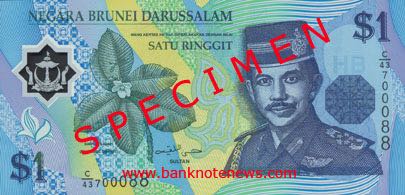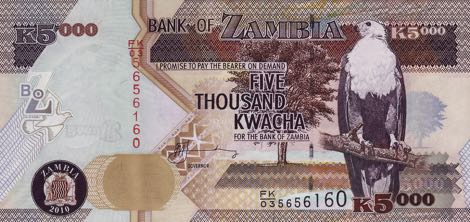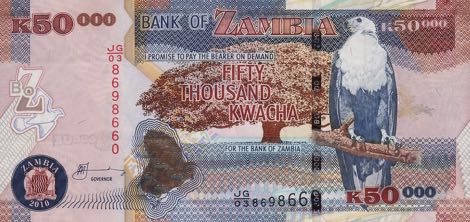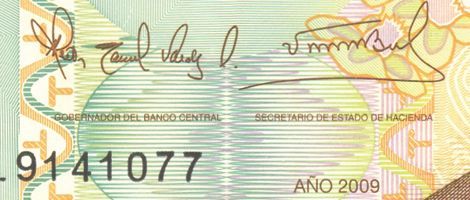Estonia adopts euro on 01.01.2011
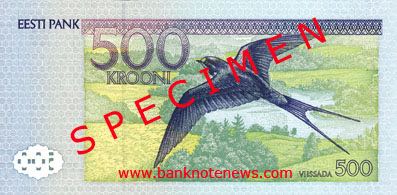
Like the barn swallow on the back of one of my favorite Estonian banknotes shown above, the kroon will fly away on 1 January 2011 as Estonia joins 16 other countries which have traded their own individual currencies for the common euro. Kroon, we’ll miss you!
Mexico new sig/date (23.04.2009) 20-peso note confirmed

20 pesos (US$1.60), 23 ABR. 2009. Like P122, but new date and signatures (Roberto del Cueto Legaspi and Raul Valdes Ramos). Series J.
Courtesy of Ricardo G. Ramírez.
Mexico new sig/date (20.11.2007) 20-peso note confirmed

20 pesos (US$1.60), 20 NOV. 2007. Like P122, but new date and signatures (Guillermo Ortiz Martinez and Raul Valdes Ramos). Series F.
Courtesy of Ricardo G. Ramírez.
Pakistan to start issuing notes with new signature on 03.01.2011
Pakistan old 500-rupee notes (B227) to be demonetized on 01.10.2011

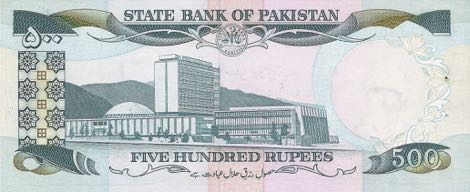
The State Bank of Pakistan has informed the public that it will demonetize old 500-rupee (US$5.85) notes as of 1 October 2011. The old notes (B227), which were introduced in April 1986, have been replaced with new notes (B236) originally issued in 2006.
Uganda 20,000-shilling note spurs copyright claim
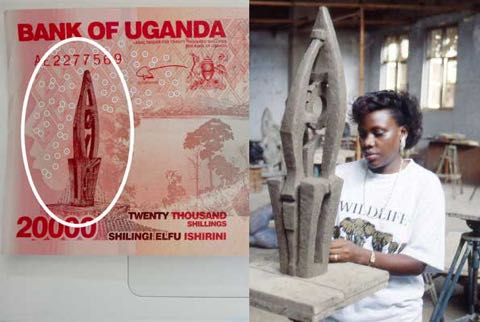
According to an article on Daily Monitor dated 30 December 2010, the Bank of Uganda used an image of a sculpture on the front of the 20,000-shilling (US$8.60) note issued 17 May 2010 without the permission of its creator, Sylivia Nabiteeko Katende, a senior lecturer at the Margaret Trowel School of Industrial and Fine Art at Makerere University. The artist is suing the bank for over 1 billion shillings (US$430,000), for fraudulent use of her intellectual property. Ms Katende claims she created the sculpture, named the Socio Economic Growth of Kampala City, to commemorate the city’s centenary celebrations in 2000.
India new 5- and 10-rupee notes reported
The 5-rupee note will have an R inset letter whereas the 10-rupee note will have an N insert letter. Both will bear the signature of Dr. D. Subbarao, governor. The design of these notes is similar in all respects to the banknotes in the Mahatma Gandhi Series with additional / new security features. Existing notes will circulate in parallel.
Additional information and images are requested.
Israel new note honorees unveiled
After a long process of consultation and discussions between the Committee and the Governor, the Governor decided to incorporate two aspects of Israel's history, the political and the cultural, by depicting two politicians who signed peace agreements with Israel's neighbors, and two outstanding people in the fields of literature and poetry.
The Governor said that it was of historical importance, in particular for future generations, to denote the leaders of the nation, and the characters chosen convey an important lesson in Israel's heritage. The Governor thanked the members of the Committee, chaired by Judge Turkel, for the time they devoted to this matter and for their recommendations.
The Bank plans to launch the new series of banknotes in 2012 in denominations of 20, 50, 100 and 200 shekel. The new banknotes will incorporate state-of-the-art security and identification features among the anti-counterfeiting measures.”
Courtesy of Bryce W. Denham.
Philippines new note family has errors
Central bank spokeswoman Fe de la Cruz acknowledged the criticism, but said space constraints limited the artist's room for manoeuvre. "In choosing the design..., we are always guided by our commitment to enrich the appreciation and knowledge of the Filipinos we honor on our banknotes, as well as the unique sites and species our country should be proud of," she said. "For our banknotes we used an artist's rendition of the Philippine map that by virtue of space and aesthetics does not reflect all of our islands and the precise coordinates of each site. Nevetheless, we appreciate constructive comments and we will take these into account moving forward."
Liberia new sig/date (2009) notes confirmed
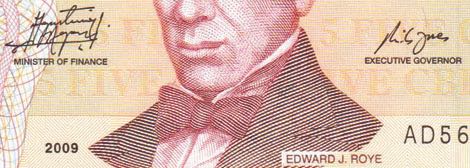
All denominations (5, 10, 20, 50, and 100 dollars) have been confirmed dated 2009 with new signature combination (Augustine K. Ngafuan, MINISTER OF FINANCE; J. Mills Jones, EXECUTIVE GOVERNOR).
Courtesy of Andrew Roberts.
Saudi Arabia new sig/date (2009) 5-riyal note (B131b) confirmed
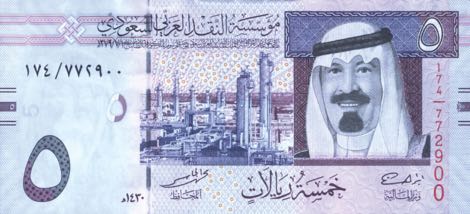
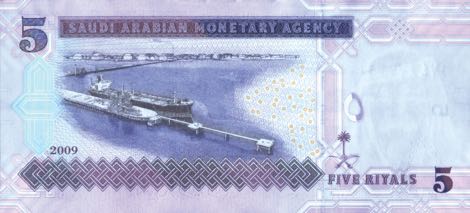
Like B131a, but new date (١٤٣٠/2009) and new signatures (Muhammad Al-Jaser and Ibrahim bin Abdulaziz bin Abdullah al-Assaf).
Courtesy of Dr. Ghassan Samman.
Venezuela new sig/date (19.12.2008) 50-bolivar note confirmed

50 bolívares (US$11.65), 19 DE DICIEMBRE DE 2008. Like P92, but new date and new signatures.
Courtesy of Alexander Petrov.
Jordan new sig/date (2010) 5-dinar note (B230d) confirmed
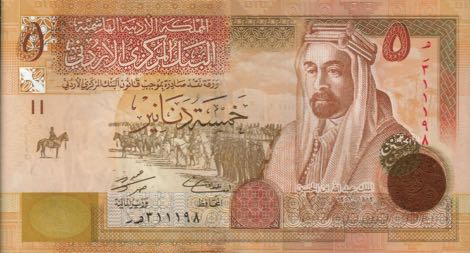
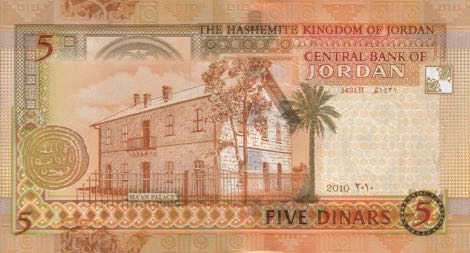
Like B230c, but new date (2010 ٢٠١٠) and new signature combination (Mohammad Abu Hammour and Umayya Salah Toukan).
Courtesy of Armen Hovsepian.
United Arab Emirates new 5-dirham note (B226a) confirmed


B226 (P26): 5 dirhams (US$1.35)
Brown. Front: Arabic text; coat of arms; Blue Souk in Sharjah. Back: English text; Saker falcon; Bay of Khorfakkan in Fujairah; tower. Solid security thread with demetalized UAE 5. Watermark: Saker falcon head. Printer: (Unknown). 143 x 60 mm. a. ١٤٣٠ (AH1430)/2009. Sig. 3. Horizontal left s/n. Prefix 000 - 090.
Courtesy of Ricardo Castedo.
Kyrgyzstan new 200-, 500-, and 1,000-som notes confirmed


B126 (PNL): 200 som (US$4.25)
Yellow. Front: Poet and playwright Alykul Osmonov; relief image of the sun and waves. Back: Lines from Osmonov’s “Jenishbek” about Lake Issyk-Kul. Holographic stripe. Windowed security thread with demetalized 200 COM. Watermark: Alykul Osmonov with electrotype 200. Printer: (TDLR). 138 x 66 mm. 2010. Signature 4. Intro: 01.12.2010.
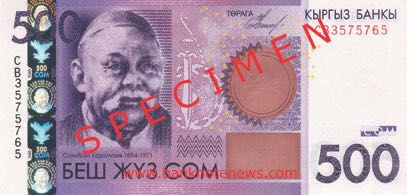
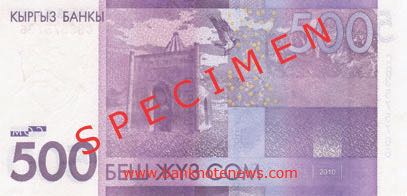
B127 (PNL): 500 som (US$10.20)
Violet. Front: “Manas” storyteller Sayakbai Karalaev. Back: Mausoleum of Manas; mountains. Holographic stripe. Windowed security thread with demetalized 500 COM. Watermark: Sayakbai Karalaev with electrotype 500. Printer: (TDLR). 144 x 68 mm. 2010. Signature 4. Intro: 01.12.2010.


B128 (PNL): 1,000 som (US$21.40)
Gray-green. Front: Poet Jusup Balasagyn. Back: Takhti Sulaiman, ancient architectural monument; Sulaiman Mountain. Holographic stripe. Windowed security thread with demetalized 1000 COM. Watermark: Jusup Balasagyn with electrotype 1000. Printer: (TDLR). 150 x 71 mm. 2010. Signature 4. Intro: 01.12.2010.
Courtesy of Ömer Yalcinkaya, Leszek Porowski and Cleo Phas.
Oman new 20-rial commemorative note (B232) confirmed
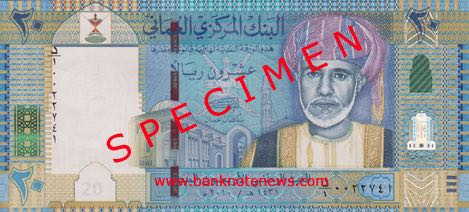


B232 (P46): 20 rials (US$52)
Blue, yellow, and purple. Front: Coat of arms with crossed swords and khanjar (dagger); Grand Mosque; Sultan Qaboos bin Said; main entrance of the CBO headquarters. Back: Royal Opera House building; 40th National Day logo; coat of arms. varifeye thread and windowed security thread with demetalized 20 RIALS. Watermark: Sultan and electrotype 20. Printer: (G&D). 167 x 76 mm. 1431 H / 2010 G. Signature 4. Intro: 22.11.2010.
Courtesy of Kai Hwong and Thomas Augustsson.
Hong Kong new 1,000-dollar notes confirmed
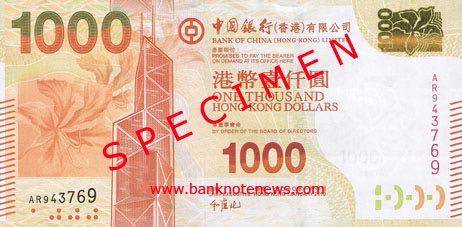


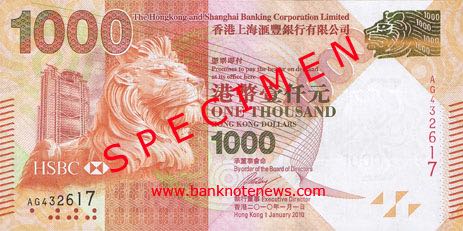
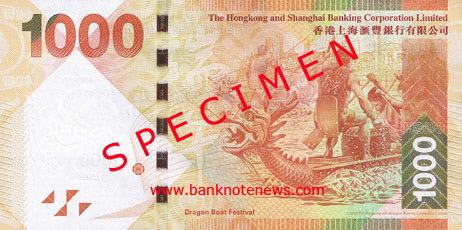
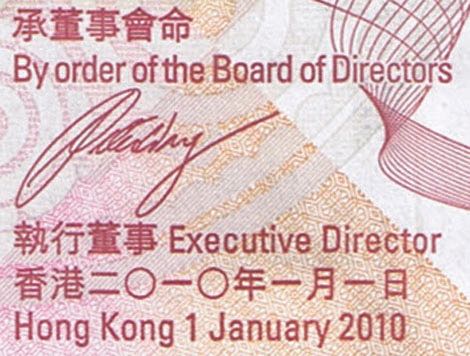


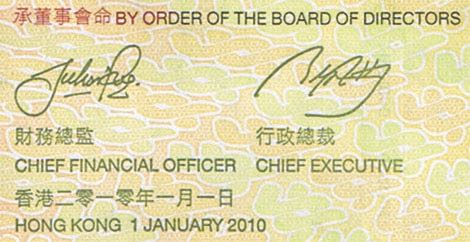
On 20 July 2010, the Hong Kong Monetary Authority announced it will begin producing banknotes with Braille and embossed lines for benefit of the visually impaired. The new notes will be phased in over the next two years and will feature Braille at the bottom left corner of each note, together with embossed lines that correspond with each notes value. The HK$1,000 (US$129) notes were unveiled at the press conference, and were put into circulation 7 December 2010.
Courtesy of Vincent Tan.
Brazil new 50- and 100-real notes confirmed
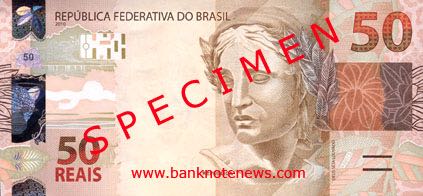

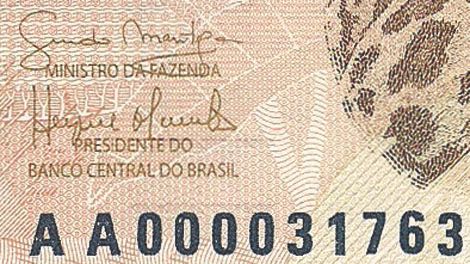
50 reais (US$29.45), 2010.
Brown and olive green. Front: Jungle plants; head of República. Back: Onça pintada (jaguar). Holographic stripe. Solid security thread with demetalized 50 REAIS. Watermark: Jaguar and electrotype 50. Printer: CASA DA MOEDA DO BRASIL. 149 x 70 mm. Signatures: minister of finance, Guido Mantega, and president of the bank, Henrique Meirelles. Intro: 13.12.2010.

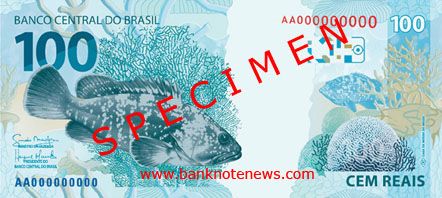
100 reais (US$58.90), 2010.
Aqua and light blue. Front: Underwater plants and starfish; head of República; coral. Back: Garoupa (grouper) fish; coral. Holographic stripe. Solid security thread with demetalized 100 REAIS. Watermark: Grouper and electrotype 100. Printer: CASA DA MOEDA DO BRASIL. 156 x 70 mm. Signatures: minister of finance, Guido Mantega, and president of the bank, Henrique Meirelles. Intro: 13.12.2010.
For more information, check out this great interactive presentation (in Portuguese).
Courtesy of Marco Antonio da Silva Freire.
Cuba new sig/date (2010) 10-peso note (B906l) confirmed

Like B906k, but new date (2010) and new signature.
Courtesy of Thomas Augustsson.
Brazil to issue new notes starting 12.12.2010

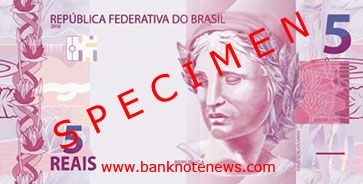






In a press release dated 3 February 2010, Banco Central do Brasil announced that it intends to issue a new family of paper notes starting with the 50- (US$27) and 100-real (US$55) denominations to be introduced in mid-2010, followed by the 10- ($5.50) and 20-real (U$11) notes in the first half of 2011, and concluding with the 2- (US$1.10) and 5-real (US$2.75) notes in the first half of 2012. During the transition to the new family, the current series will remain legal tender. The release date of the first two notes is now scheduled for 12 December 2010.
The new notes are dated, and will increase in size with the denomination. Along with tactile features, this will assist the sight-impaired in distinguishing between denominations. The notes bear the signatures of the minister of finance, Guido Mantega, and the president of the bank, Henrique Meirelles. The theme of the current family—an effigy of the Republic on the front and Brazilian animals on the back—will be maintained, but the graphics have been redesigned with a horizontal orientation and for enhanced security.
Courtesy of Rafael Augusto Mattos Ferreira, Marco Antonio da Silva Freire, and Rui Manuel Palhares.
Egypt new date (01.03.2010) 200-pound note confirmed
Courtesy of Michael Reissner.
Gambia new 25-, 50-, and 100-dalasis notes confirmed
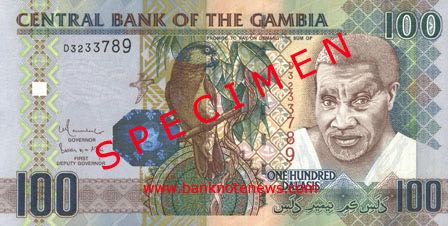
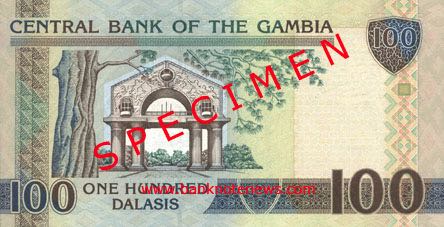

According to an article in The Gambian Banker, on 2 August 2010 the Central Bank of The Gambia issued new 25-, 50-, and 100-dalasis banknotes signed by Governor Momodou B. Saho and First Deputy Governor Basirus A.O. Njai. The notes are essentially unchanged from the preceding issues of the same denominations issued in 2006, except for the 100-dalasis note, which has a Depth Image holographic patch instead of a silver embossed foil. The patch shows the portrait on the banknote with the palm trees alternating with the denomination. When tilted, a flying parrot moves behind the portrait. All current banknotes continue to be legal tender.
Courtesy of Claudio Marana.
Philippines new Aquino signature varieties confirmed

On 26 November 2010, the Bangko Sentral ng Pilipinas (BSP) started issuing banknotes with the signature of President Benigno S. C. Aquino III, ahead of December’s launch of redesigned note series. The bank stopped producing notes with the signature of former President Gloria Macapagal Arroyo when Aquino assumed office last June 30 and the new printing is aimed at shoring up supply. Given the fact that a new series is coming out in less than a month, notes of the old designs with Aquino’s signature may be relatively rare.
Courtesy of Andy Siegman.
Philippines new date (2010) 20-peso note confirmed

20 pesos (US$0.45), 2010. Like P182, but new date.
Courtesy of Sejin Ahn.
Cuba new 2005 dated 5- and 10-peso convertible notes confirmed
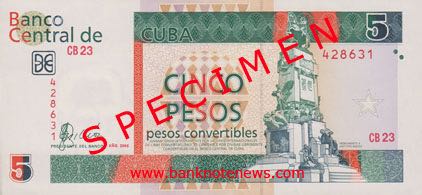
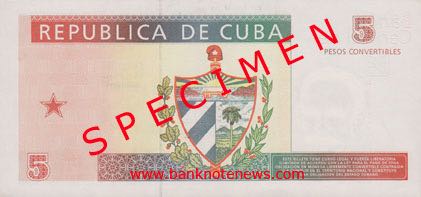
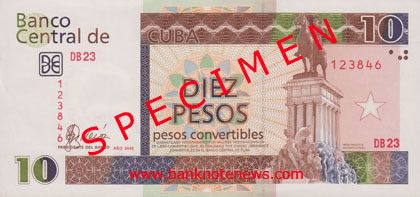
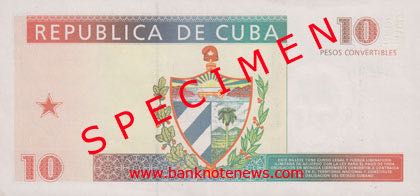
At first glance these two notes appear to be 2005-dated varieties of PFX44 and PFX45 (which are both dated 2004), respectively, but there are additional colors on front, with several items rendered in two tones, and the serial number placement and orientation is new, too.
Courtesy of Thomas Augustsson.
The Challenge: Iranian/Persian symbolism help sought
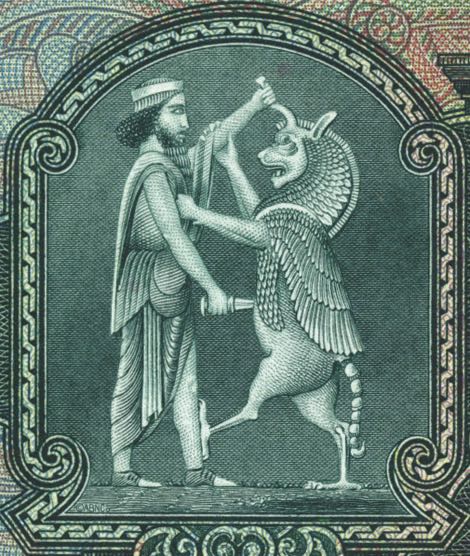
I’m working on the Iranian chapter of The Banknote Book and have come across this interesting engraving on the front of Pick 30, the 1,000-rial note of 1934. The image—described in SCWPM as “warrior killing fabulous creature”—also appears on the date stamps of subsequent issues. I suspect it depicts some Persian legend or myth. If anyone can direct me towards a full explanation, hopefully identifying the warrior and/or creature by name, I would appreciate it. Thanks in advance!
IDENTIFIED: Darius the Great stabbing Ahriman monster from stone relief at Persepolis.
Courtesy of Raphael.
United States new 100-dollar note plagued by printing problems
Visit msnbc.com for breaking news, world news, and news about the economy
Courtesy of Alex Zlotin.
Guatemala new 5-quetzal polymer to be printed in Canada
South Africa faulty 100-rand notes reported

According to an article in BusinessReport dated 5 December 2010, the South Africa Reserve Bank discovered in May that it had issued 100-rand (US$14.55) banknotes which are defective because they lack fluorescent printing visible under UV light. In June, printing of this denomination was shifted from the South African Bank Note Company to Crane Currency’s Swedish division (Tumba Bruk.), which reportedly produced 80 million 100-rand notes. The defective notes are said to bear the signature of former governor Tito Mboweni' (P131) as well as the current governor, Gill Marcus. These notes were originally issued in 2005 and 2009, respectively, so the problem apparently went undetected for quite some time.
Serbia new 5,000-dinar note confirmed
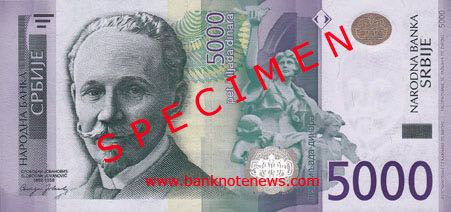

According to a press release, on 26 November 2010 the National Bank of Serbia issued a new 5,000-dinar (US$61.10) banknote that will circulate in parallel with the same denomination note issued in 2003 (P45). The new note retains the overall design of the old note with the following changes:
on the front of the banknote
1. the position and the form of the kip effect and OVI elements are changed;
on the back of the banknote
1. the year of issue (2010) and governor’s signature are changed;
2. the logo of the National Bank of Serbia is replaced with the Great Coat-of-Arms of the Republic of Serbia;
3. the year of issue and governor’s signature are no longer below the logo of the National Bank of Serbia, but in the right part of the white area;
4. lettering (handwriting of S. Jovanović) in intaglio print is added in the central part of the banknote;
5. the serial number is placed between the Great Coat-of-Arms of the Republic of Serbia and the value numeral, instead to the right of the value numeral;
6. Cyrillic lettering “Narodna banka Srbije – Zavod za izradu novčanica i kovanog novca Topčider“ (National Bank of Serbia – Institute for Manufacturing Banknotes and Coins Topčider) is now placed above the upper edge of the fully printed area instead of directly above its lower edge.
Courtesy of Matej Omahen.
Denmark to issue new 500-krone note on 15.02.2011

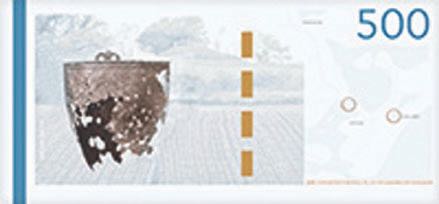
According to Danmarks Nationalbank, the new 500-krone (US$90) banknote will be issued 15 February 2011. The note measures 155 x 72 mm, and the front depicts Dronning Alexandrines Bro and the back features a bronze pail from Keldby.
Dronning Alexandrines Bro
The bridge Dronning Alexandrines Bro, also called the Møn Bridge, was opened in 1943. The bridge across Ulvsund connects Kalvehave on South Zealand with the island of Møn. Dronning Alexandrines Bro is 746 metres long and has a maximum vertical clearance of 26 metres.
The bronze pail
The bronze pail from Keldby on the island of Møn was unearthed by a plough near Trehøje in the period before 1826. It was probably made in the 4th or early 3rd century BC. Other pails closely resembling this pail have been found in the Thracian area of the Black Sea in Southern Ukraine. Judging by the clearly Greek inspired ornamentation and shape, the pail could have been made in Macedonia or the Greek Black Sea colonies.
Additional information and images are requested.
Brunei new date (2008) 100-dollar note confirmed

100 dollars (US$76.70), 2008. Like P29, but new date in lower right corner on back.
Courtesy of Kai Hwong.
Central African States new signature varieties confirmed
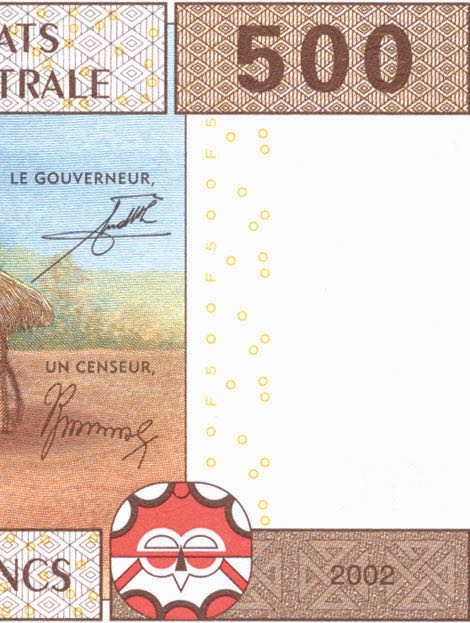
A new signature combination has been confirmed for all denominations from the Central African States. In this case, all carry the country code of U for Cameroon, which makes these P206-P210. If anyone has this signature combination on notes with other country codes, please send scans of same.
Courtesy of Bill Stubkjaer, David F. Cieniewicz, and Murtaza Karimjee.
Laos new 100,000-kip commemorative confirmed
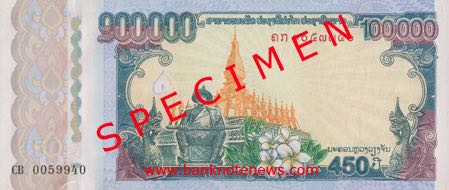

On 15 November 2010, the Bank Of the Lao PDR introduced a new 100,000-kip (US$12.45) banknote and several coins to commemorate the 450th anniversary of the capital, Vientiane, and the 35th anniversary of the establishment of the Lao PDR. Further details are available in this press release, currently available in Lao only, as well as this article from Vientiane Times.
100,000-kip (US$12.45)
Blue. Front: Naga; statue of King Setthathilat; frangipani, national flower; Wat That Luang stupa in Vientiane; naga. Back: Frangipani flowers; Ho Phra Keo temple in Vientiane. Holographic security thread printed with Lao text. Watermark: Kaysone Phomvihane. Printer: (Goznak). 159 x 68 mm.
Courtesy of Leszek Porowski and Thomas Augustsson.
Jordan's central bank announces new governor
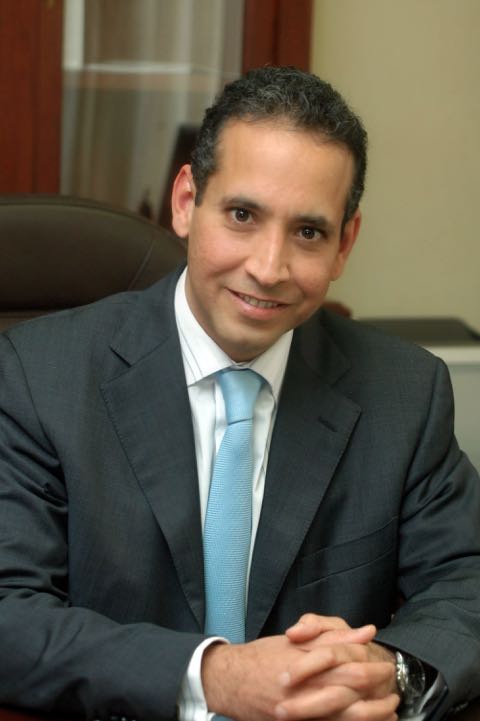
On 25 November 2010, the Central Bank of Jordan announced it has a new governor. Faris Sharaf, who replaces Dr. Umayya Toukan. As a result, we may expect to see new signature varieties issued shortly.
Courtesy of Mahdi Bseiso.
Macedonia new sig/date (00.01.2009) 100-denar note (B208j) confirmed
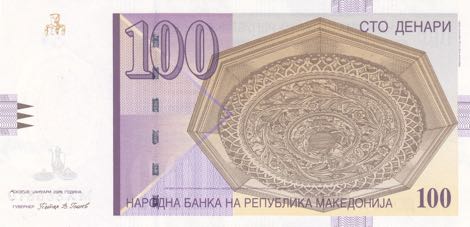

Like B208i, but new date (ЈАНУАРИ 2009) and new signature (Petar Goshev).
Courtesy of Matej Omahen.
Nepal new signature 500-rupee note confirmed
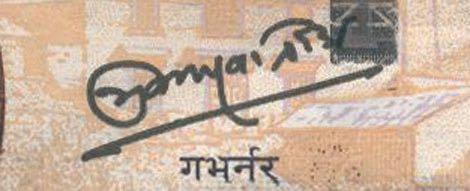
500 rupees (US$6.85), no date. Like 500-rupee note issued in 2009, but with new signature (Yuba Raj Khatiwada). Issued 24.11.2010.
Courtesy of Shankar Shrestha.
Tajikistan new 3-, 200-, and 500-somoni notes confirmed
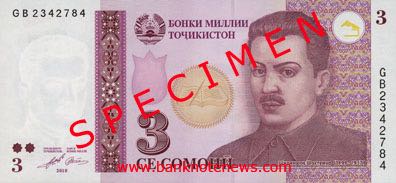
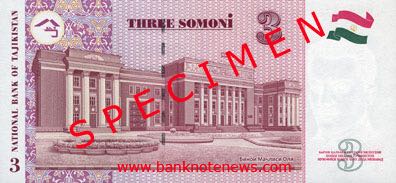
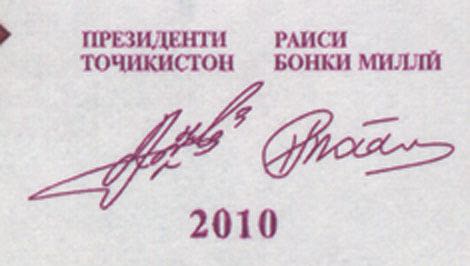
3 somoni (US$0.70)
Violet. Front: Coat of arms; open book with pen; Shirinsho Shotemur, hero statesman. Back: Majlisi Oli (parliament) building in Dushanbe; flag. Windowed security thread with demetalized БМТ. Watermark: Shirinsho Shotemur. Printer: Unknown. 141 x 65 mm. 2010. Signature 3. Intro: 10.09.2010.
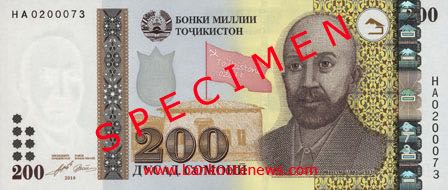
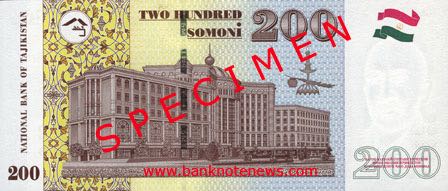
200 somoni (US$45.65)
Brown and yellow. Front: Coat of arms; building with red flag; Nusratullo Makhsum, hero statesman. Back: National Library building in Dushanbe; ink well, quill, and candlestick; flag. Holographic stripe. Windowed security thread with demetalized БМТ. Watermark: Nusratullo Makhsum. Printer: Unknown. 159 x 68 mm. 2010. Signature 3. Intro: 10.09.2010.

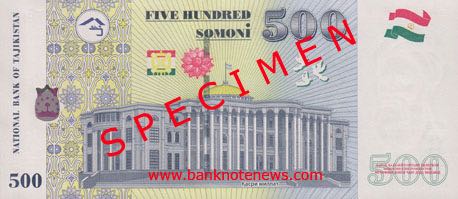
500 somoni (US$114)
Purple and gray. Front: Coat of arms; Abuabdullo Rudaki, founder of Tajik classic literature. Back: Palace of Nations in Dushanbe; flag. Holographic stripe. Windowed security thread with demetalized БМТ. Watermark: Abuabdullo Rudaki. Printer: Unknown. 162 x 71 mm. 2010. Signature 3. Intro: 10.09.2010.
Courtesy of Thomas Augustsson, Claudio Marana, Vitali Khaletski, and Alexander Petrov.
Hong Kong to issue new 1,000-dollar notes 07.12.2010
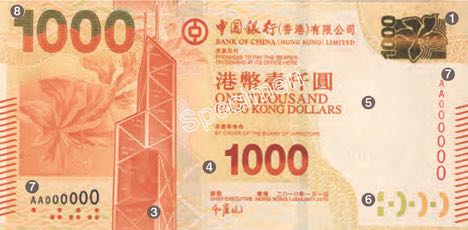
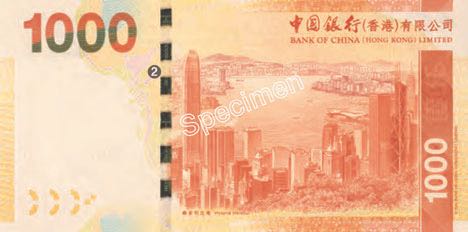
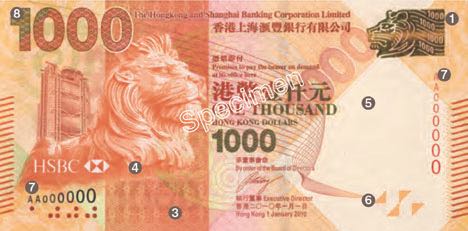


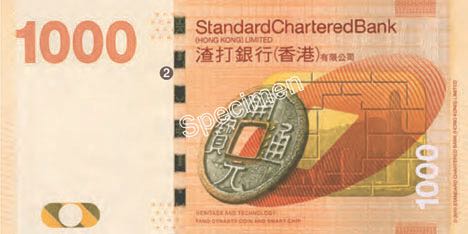
According to a press release dated 24 November 2010, the Hong Kong Monetary Authority (HKMA) and the three note-issuing banks (Standard Chartered Bank (Hong Kong) Limited, The Hongkong and Shanghai Banking Corporation Limited, and Bank of China (Hong Kong) Limited) have announced that a new series of 1,000-dollar (US$129) banknotes will be issued on 7 December 2010. New notes for the other four denominations of HK$500, HK$100, HK$50 and HK$20 will go into circulation in 2011 and 2012. The new notes will circulate in parallel with existing notes.
The new banknotes have incorporated state-of-the-art security features, the locations of which will be the same across all five denominations. The five key features are:
- Dynamic Color-changing Pattern — color shifting between green and gold with a shimmering horizontal bar seen to be rolling up and down when the note is tilted
- Color-changing Windowed Metallic Thread — color shifting between magenta and green and the "H" and "K" on the thread are made up of microtext
- Standardized Enhanced Watermark — comprising a multi-tonal watermark of a bauhinia flower and electrotype watermark of the denomination numeral and dot pattern, a standardized design for the three note-issuing banks
- Fluorescent See-through Pattern — perfect registration of the patterns on the front and back, with two fluorescent colors visible under ultraviolet light
- Fluorescent Serial Number — the vertical serial number is fluorescent red under ultraviolet light
Guyana new 20-dollar variety confirmed
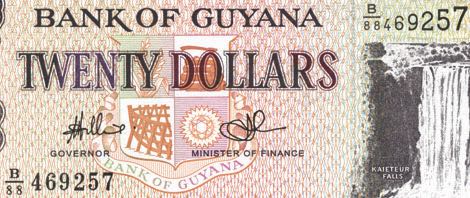
20 dollars (US$0.10), no date. Like P30, but new signatures, new printer imprint (CANADIAN BANK NOTE COMPANY, LIMITED), and the serial number font at lower left has been changed and no longer matches the novel serial number font at upper right.
Courtesy of Murtaza Azeez.
Cuba new date (2009) 10-peso note (B906k) confirmed

Like B906j, but new date (2009).
Courtesy of Thomas Augustsson.
Guatemala to issue 5-quetzal polymer note in 2011
Additional information and images are requested.
Chile new 2,000-peso note (B297) confirmed
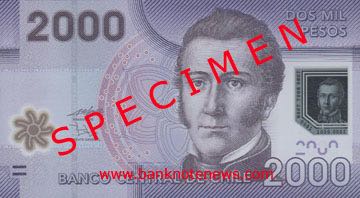
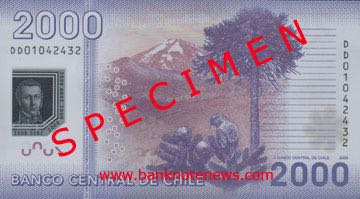
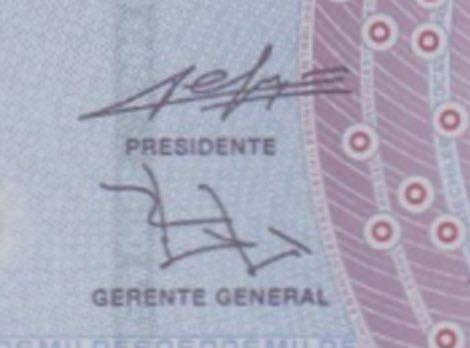
On 6 October 2010 the Central Bank of Chile unveiled its new 2,000-peso (US$4.15) banknote. This polymer note was issued 17 November 2010. On front it features a portrait of lawyer and guerrilla leader, Manuel Rodríguez Erdoíza, as well as a stylized corazón del copihue (heart of Chilean bellflower). The back of the note depicts Reserva Nacional Nalcas in the Araucania region, with a volcanoe and a choroy parrot. The 2,000-peso notes is the fourth member of the new family of notes which started with the 24 September 2009 introduction of the 5,000-peso note, and will be complete with the 2011 introduction of the 1,000-peso note.
Courtesy of Thomas Krause.
Denmark new 200-krone note confirmed
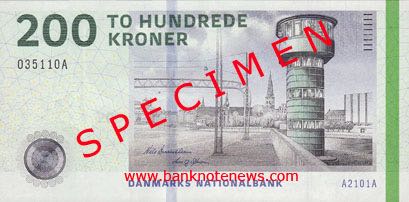
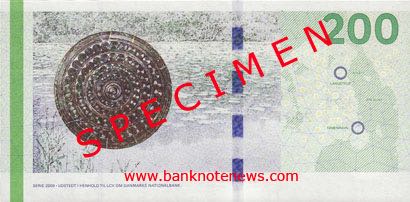
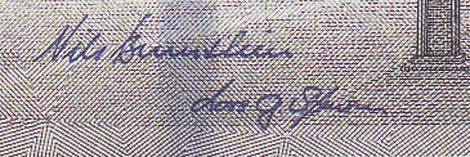
Signature (Nils Bernstein, Governor; Lars Gerrild Sørensen, Head of Banking Services).
UPDATE:
New signature variety confirmed as follows.
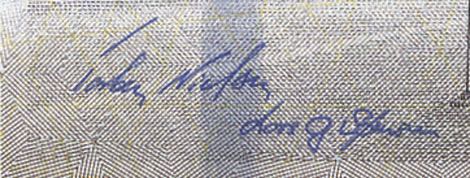
Signature (Torben Nielsen, Governor; Lars Gerrild Sørensen, Head of Banking Services).
Danmarks Nationalbank has issued the following press release:
19 October 2010 a new 200-krone [US$37.25] banknote will be issued. The new series makes it even more difficult to counterfeit or copy genuine banknotes. The banknotes have been designed by the artist Karin Birgitte Lund and have Danish bridges and prehistoric finds as their motifs. All Danish banknotes issued since the substitution of money in 1945 can be exchanged at face value at Danmarks Nationalbank.
Why issue new banknotes?
Technological advances mean that counterfeiters constantly gain access to improved tools for copying genuine banknotes. To remain one step ahead, Danmarks Nationalbank in 2006 initiated the process of designing a new banknote series with new security features, a replacement for the current series from 1997.
Among the new security features is a window thread with a moving wave pattern [Crane’s Motion thread]. Another feature is a new, sophisticated hologram that reflects light in different colours. The new banknotes will also have the traditional security features such as the watermark and the hidden security thread.
What do the new banknotes look like?
The theme of the new banknotes is Danish bridges and the surrounding landscapes, or details from these landscapes. The artist Karin Birgitte Lund has chosen to interpret this theme in two ways: bridges as links between various parts of Denmark and as links between the past and the present. The present is represented by the bridges, the past by five distinctive prehistoric objects found near the bridges.
When will the new banknotes be issued?
The expected schedule for introducing the remaining new banknotes is as follows:
• 500 kroner: February 2011 – depicting Queen Alexandrine's Bridge and the bronze vessel from Keldby
• 1,000 kroner: May 2011 – depicting the Great Belt Bridge and the Sun Chariot
What is being done for the visually impaired?
In the interests of the blind and partially sighted, the 100- and 200-krone banknotes will have embossed print to make it easier to distinguish them from each other. Like the current series, the banknotes will differ in size, which is also helpful to the blind and partially sighted.
Courtesy of Ricardo Castedo and Alberto Fochi.
South Africa new signature 10-, 20-, 50-, 100- and 200-rand notes confirmed

10 rand (US$1.40), no date. Like P128, but new signature (Ms. Gill Marcus).
20 rand (US$2.85), no date. Like P129, but new signature (Ms. Gill Marcus).
50 rand (US$7.15), no date. Like P130, but new signature (Ms. Gill Marcus). Intro: 2009.
100 rand (US$14.30), no date. Like P131, but new signature (Ms. Gill Marcus). Intro: 2009.
200 rand (US$28.60), no date. Like P132, but new signature (Ms. Gill Marcus). Intro: 2009.
Courtesy of Alberto Fochi, Michael Reissner, and banknoteshop@gmx.net.
Singapore new 5-dollar variety confirmed
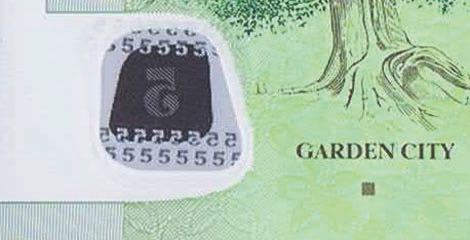
5 dollars (US$3.30), no date. Like the $5 note issued 18.05.2007, but now with one square below GARDEN CITY on back. Signature remains CHAIRMAN Goh Chok Tong.
Courtesy of Tan Wei Jie.
Scan modern notes without CDS problems
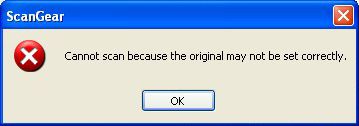
Recently more and more collectors have reported problems attempting to scan modern banknotes. The problem is caused by newer hardware and software that contains built-in Counterfeit Deterrence System (CDS) technology foisted upon the public by the Central Bank Counterfeit Deterrence Group (CBCDG), a group of 31 central banks and note-printing authorities. Attempts to scan some modern notes using most newer scanners results in an error message like the one shown above.
I sympathize with the desire to reduce counterfeiting, but limiting the capabilities of new consumer devices punishes everyone while doing nothing to discourage determined counterfeiters. Anyone wishing to scan banknotes can easily do so simply by avoiding the latest generation in computer equipment. Instead of buying a cheap new scanner that performs poorly and is likely hobbled by CDS, buy an older used scanner that works on everything you throw at it. I highly recommend the Epson Perfection 2450 PHOTO which cost $400 when it was brand new, but now routinely sells for around $50 on eBay. This scanner is fast, has excellent color fidelity, and can even scan watermarks and security threads when used in film/slide mode.
If you already have a scanner that you like, but which refuses to scan some modern notes, you can likely replace the manufacturer's provided scanning software with VueScan. This third-party scanning program works with almost all scanners and doesn't prevent you from scanning troublesome notes. It costs $40, but you can try before you buy to ensure it meets your needs.
Bahrain new variety 1/2-dinar note (B212c) confirmed
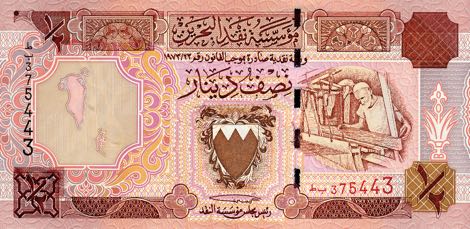

Like B212b (top), but the security thread has six, not five, “windows” that are 4.0-mm long, not 5.5-mm long. Also, the prefix font is different.
Courtesy of Sejin Ahn.
Singapore new 10-dollar variety confirmed
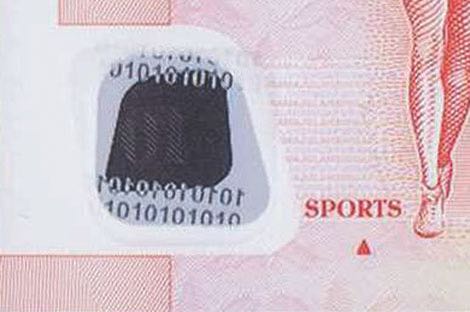
10 dollars (US$7.70), no date. Like P48, but new signature and now with triangle below SPORTS on back. This denomination has been previously confirmed with no symbol as well as either one or two squares in the same location.
Courtesy of Tan Wei Jie.
India new sig. 5-rupee note without inset letter reported
Vanuatu new signature 1,000-vatu note confirmed
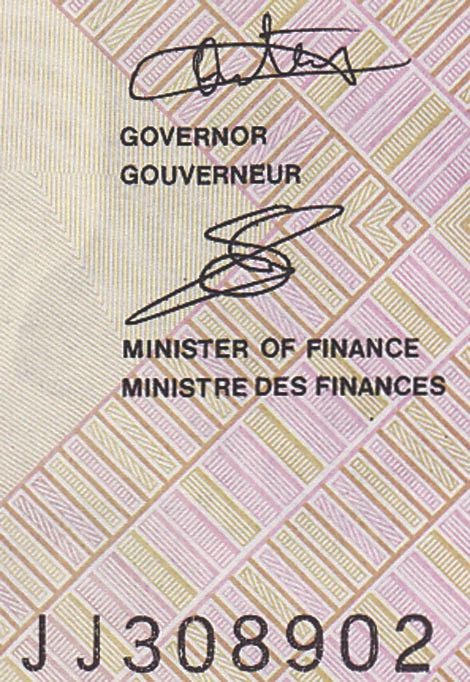
1,000 vatu (US$10.60), no date. Like P10, but new signature combination (Odo Tevi and Sela Molisa). Prefix JJ.
Courtesy of Ricardo Castedo.
Nigeria new sig/date (2010) 10-naira note confirmed

10 naira (US$0.05), 2010. 6-digit serial number, signatures Lamido Aminu Sanusi and Benjamin C. Onyido.
Courtesy of Arigo Avbovbo.
Sweden new sig/date (2007) 20-krona note confirmed
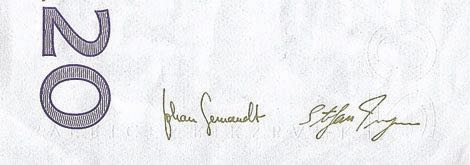
20 kronor (US$3), (200)7. Like P63, but new date and new signature combination.
Courtesy of Sejin Ahn.
Belarus language changes create errors on old notes
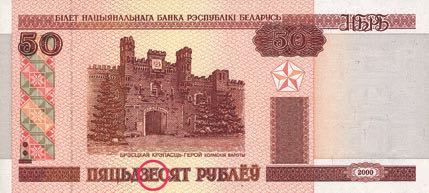
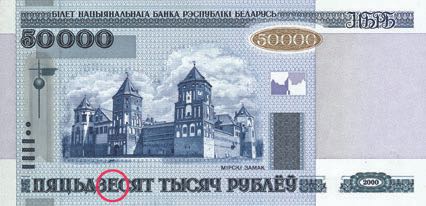
According to an article on the Belarus Partisan dated 05.11.2010, on 1 September 2010, new rules of Belarusian orthography came into force. According to the old rules, the correct spelling of the word “fifty” in Belarusian was “пяцьдзЕсят,” but under the new rules, it should be spelled “пяцьдзЯсят,” the difference being that the seventh character was the Cyrillic letter IE but is now the Cyrillic letter YA. As a result of these new rules, the existing 50- and 50,000-ruble notes (Pick 25 and Pick 32, respectively) dated 2000 now technically contain errors where the denominations are spelled out on the backs of the notes. Belarus National Bank intends to correct these spelling errors when it issues new versions of these denominations, but there is no word yet on when that may be.
Courtesy of Vitali Khaletski.
Russia to issue new 5,000-ruble note in 2011 with new ruble symbol
Greenland decides against issuing its own banknotes
Cuba new date (2009) 50-peso note (B910f) confirmed
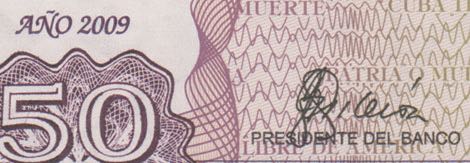
Like B910e, but new date (2009).
Courtesy of Thomas Augustsson.
Netherlands Antilles dissolved; new notes to be issued 2012
Courtesy of Stein Langørgen.
Chile new date (2009) 1,000-peso note (B290ff) confirmed

1,000 pesos (US$2.05), 2009. Like P154, but new date.
Courtesy of Alberto Fochi.
Nigeria new date (2010) 10-naira note confirmed

10 naira (US$0.07), 2010. Like 10-naira note originally dated 2009, but new date and new signatures (Lamido Aminu Sanusi and Muhammad Nda). 6-digit serial number.
Courtesy of Arigo Avbovbo.
RIP Mel Steinberg

I am deeply saddened to report that the banknote community lost one of its pillars when Mel Steinberg passed away yesterday morning in Northern California. Mel and his son Jeremy were familiar faces to anyone who attended major banknote shows, and a stop at their booth was always worthwhile, not only to view the fine rarities for sale, but also to chat with Mel, who was generous with his time, sharing wisdom and an easy, knowing smile and twinkle in his eyes. Rest in peace, Mel. We'll miss you dearly…
Romania new date (2009) 200-leu note (B284c) confirmed

200 lei (US$65), (20)09. Like P122, but new date. Last two digits of year of issue as first two digits of serial number. Signature remains the same.
Courtesy of Ricardo Castedo.
Bangladesh new date (2010) 10-taka note confirmed
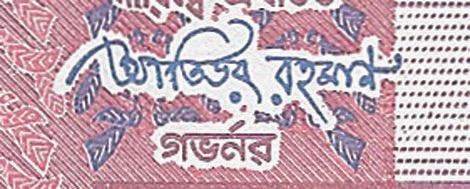
10 taka (US$0.15), 2010. Like P39, but new date and signature (Atiur Rahman).
Courtesy of Sejin Ahn.
Nicaragua new 50-cordoba commemorative confirmed

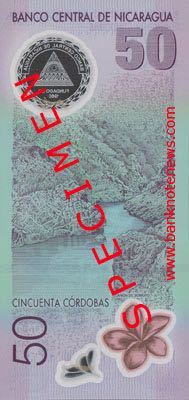
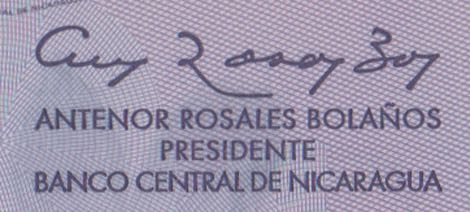
On 16 September 2010, Banco Central de Nicaragua (BCN) issued a new 50-cordoba (US$2.30) polymer banknote to commemorate the 50th anniversary of the bank. The note measures 141 x 67 mm and is the first vertically-oriented note in the bank's history. The front of the note features the first headquarters of the bank and the back depicts Somoto Canyon. Preceding notes of the same denomination will circulate in parallel with this commemorative, of which 6 million notes will be issued.
Courtesy of Alex Zlotin, Thomas Augustsson, and Ricardo Castedos.
Czech Republic to replace 50-koruna note with coin 01.04.2011

According to a Czech National Bank press release dated 8 October 2010:
As from 1 April 2011 it will not be possible to pay for goods and services with the CZK 50 [US$2.85] banknote. The Bank Board of the Czech National Bank has decided to terminate the CZK 50 banknote [Pick 17]. The note will be fully replaced in circulation by the currently used coin of the same denomination.
From 1 April 2011 to 31 March 2012, the invalid banknotes – which have a portrait of St. Agnes of Bohemia on the face side – will be exchangeable at bank branches and at branches of the Czech National Bank. From 1 April 2012 to 31 March 2017, the CZK 50 banknotes will be exchanged only by the Czech National Bank (at all its seven branches: Prague, Plzeň, Hradec Králové, Brno, Ostrava, České Budějovice and Ústí nad Labem).
The Czech National Bank has been gradually replacing the CZK 50 banknotes with coins since 2006. The number of such notes in circulation fell from 40 million at the end of 2005 to 25 million at the end of 2009, while the number of CZK 50 coins in circulation increased more than nine-fold in the same period (from 5 million to 47 million).
“The Bank Board’s main motivation in deciding to terminate the CZK 50 banknote was the lower costs of ensuring smooth currency circulation. Coins have a much longer useful life than banknotes, so they reduce the central bank’s direct expenditure on issuing money,” said CNB Bank Board member Pavel Řežábek.
The 50-crown note became part of the circulating currency as a Treasury note in 1919, shortly after the establishment of the independent Czechoslovakia. As a banknote it has been circulating in various versions since 1929 to the present. The longest period in circulation was recorded for the 50-crown note issued in 1965, which was valid until 1991. It depicted a Red Army soldier and a partisan and was designed by Václav Fiala. Treasury notes from the First Republic, especially those issued in 1919 and 1922, are most prized by collectors.
The 1994 and 1997 versions of the CZK 50 banknote are currently in circulation. The previous version (1993), which ceased to be valid in 2007, can currently be exchanged at the CNB. It will be exchangeable until 31 March 2017 only at CNB branches.”
Courtesy of Tristan Williams.
Ghana new sig/date (06.03.2010) 5-cedi note (B146b) confirmed
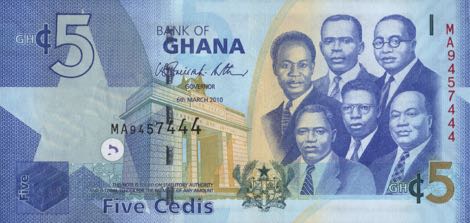
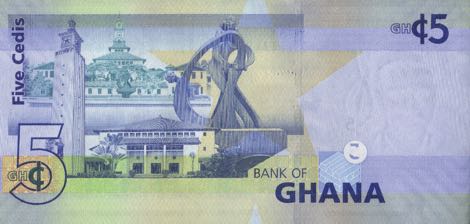
Like B146a, but new date (6th MARCH 2010), new signature (Kwesi Bekoe Amissah-Arthur), and electrotype denomination added to the watermark.
Courtesy of Claudio Marana.
Reviving regional currencies in Russia
Courtesy of Valts Mikelsons.
Papua New Guinea new 35th anniversary commemoratives confirmed


All notes are dated (20)10 and signed by Leonard Wilson Kamit and Simon Tosali.

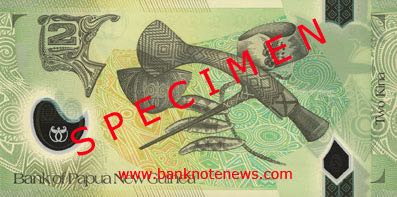


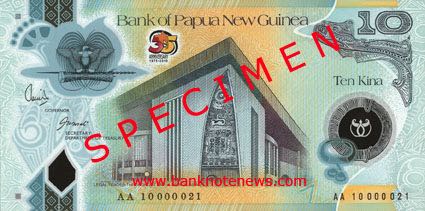
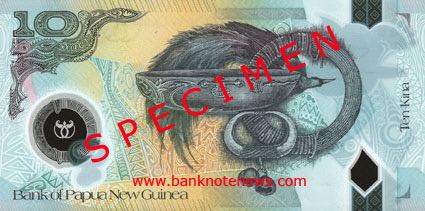


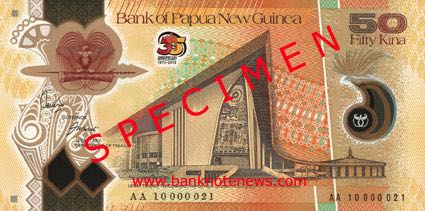
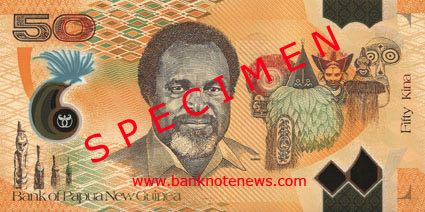
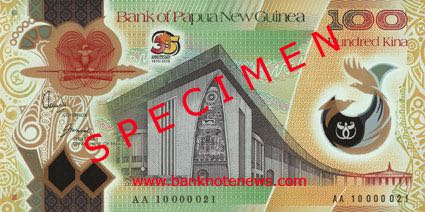

On 15 September 2010 the Bank of Papua New Guinea introduced new polymer notes to commemorate the nation’s 35th anniversary of independence from Australia. All six denominations (2, 5, 10, 20, 50, and 100 kina) have been issued and are like the preceding issues but they have a logo with the text “35th Anniversary 1975 – 2010.” In addition to the notes issued for circulation, the bank is also selling a numismatic product consisting of an album with all the notes with low and matching serial numbers.
Courtesy of Andrew Quirke, Sean Rooney, Manfred Krüger, and Thomas Krause.
Saudi Arabia new sig/date (2009) 50-riyal note (B133b) confirmed


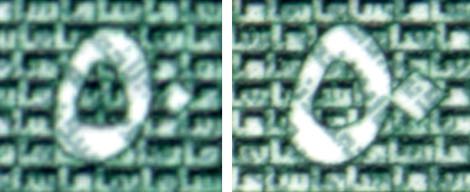
Like B133a, but new date (١٤٣٠/2009) and new Governor signature (Muhammad Al-Jaser). Also, the denomination expressed in Arabic in the bars at left and right edge of the front of the note has been slightly modified. In the first issue of this note, the trailing zero was so small that it blended in with the tiny boxes in the background (above, left), but the new variety has a larger zero which stands out better (above, right).
Courtesy of Sejin Ahn.
Philippines rumored to outsource new notes to Oberthur
Australian dated notes confirmed


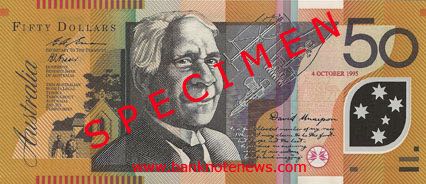

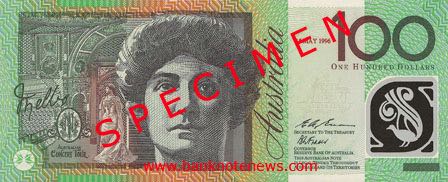

I’ve recently received scans of polymer notes from Australia which differ from the regular issues in that these actually bear full dates overprinted on the notes, rather than just having serial numbers which start with the trailing two digits of the year.
I assume these dates correspond to the dates of introduction for each of these denominations and that the notes were issued as numismatic products, perhaps in a folder or as part of a matched serial number set. Does anyone have any additional information on these notes? If they were in fact issued in folders, please send scans of the folders, inside and out.
Courtesy of Thomas Krause.
French Pacific Territories new signature 500-franc variety confirmed

500 francs (US$5.89), no date. Like P1, but new signatures. Intro: 2010.
Courtesy of Jerome Deschamps.
Nepal new sig. variety 50-rupee note confirmed

50 rupees (US$0.70), no date. Like P63, but new signature (Yuba Raj Khatiwada). Intro: 07.10.2010.
Courtesy of Shankar Shrestha.
French Pacific Territories new signature 5,000-franc variety confirmed

5,000 francs (US$58.60), no date. Like P3, but new signatures. Intro: 2010.
Courtesy of Rui Manuel Palhares.
Cuba new date (2001) 1-peso note (B901a) confirmed

1 peso (US$1), 2001. Like P121, but new date.
Courtesy of Thomas Augustsson.
Pakistan new date (2010) 20-rupee note (B233d) confirmed
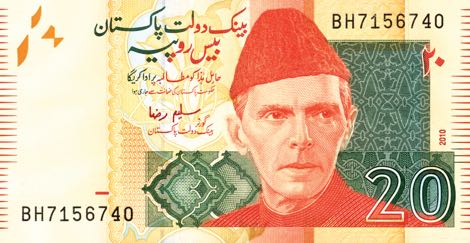
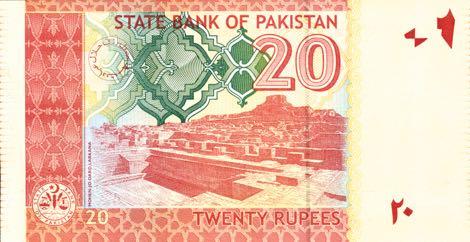
Like B233c, but new date (2010).
Courtesy of Bill Stubkjaer.
Nigeria new 50-naira commemorative polymer note confirmed
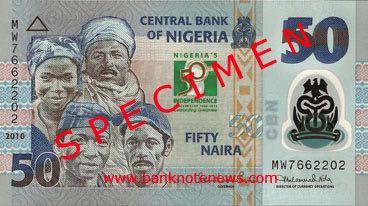
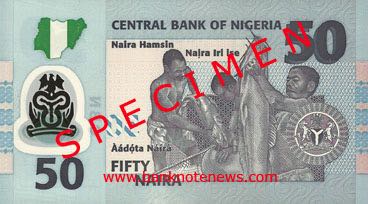

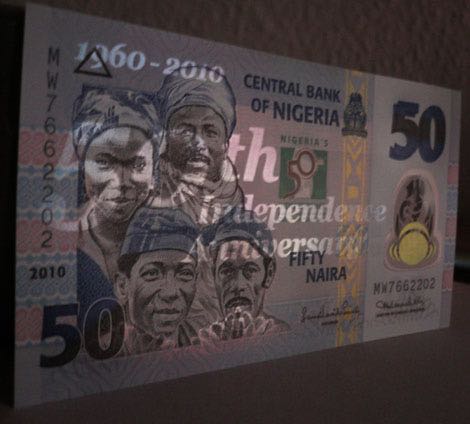
The Central Bank of Nigeria commemorated the nation's 50th anniversary of independence by issuing a redesigned 50-naira (US$0.35) note on 29 September 2010. The polymer note is adorned with a 50th anniversary logo and circulates in parallel with existing notes of the same denomination. The redesigned note has the anniversary logo, a strip of gold band, and a varnished message that reads “1960-2010, 50th Independence,” which can be seen when the note is tilted.
Courtesy of Nazir Rahemtulla, Mohammed Elarabi, Thomas Krause, and Mohammed Elarabi.
Mauritania new sig/date (28.11.2008) 100-ouguiya note (B114c) confirmed
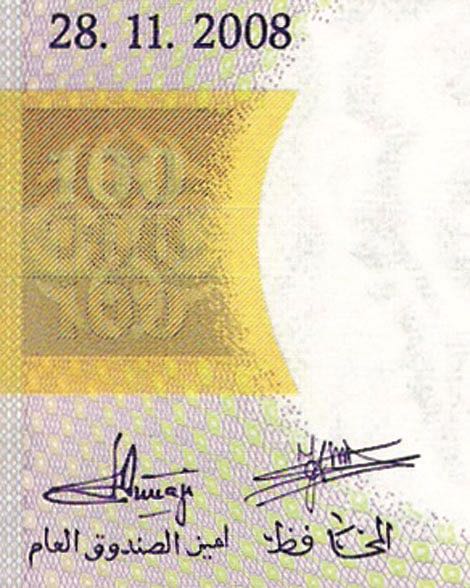
100 ouguiya (US$0.35), 28.11.2008. Like B114b, but new date and new signatures.
Courtesy of Jean-Michel Engels.
Ghana new sig/date (06.03.2010) 10-cedi note (B147b) confirmed

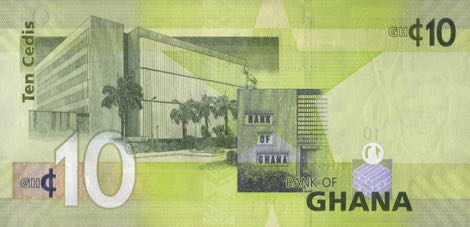
Like B147a, but new date (6th MARCH 2010), new signature (Kwesi Bekoe Amissah-Arthur), and electrotype denomination added to the watermark.
Courtesy of Claudio Marana.
Cambodia new date (2006) 10,000-riel specimen confirmed
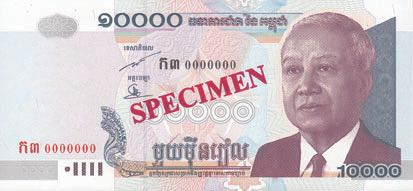
10,000 riels (US$2.35), 2006. Like P56, but new date (2006) and diagonal red SPECIMEN overprint. Also confirmed as issued note.
Courtesy of Allan Lambert.
Moldova new sig/date (2010) 1- and 20-leu notes confirmed
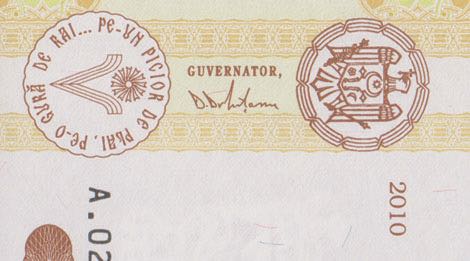
On 27 September 2010, the Banca Naţională a Moldovei (National Bank of Moldova) began issuing 1-leu and 20-leu (US$0.10 and US$1.65, respectively) that are like the preceding issues (Pick 8 and 13, respectively), but are dated 2010 and bear the signature of Dorin Drăguţanu, the new governor who replaced the previous governor, Leonid Talmaci, on 6 November 2009.
Courtesy of Alex Klark, Vadim Tislenko, and Thomas Augustsson.
Honduras new date (13.07.2006) 100-lempira note confirmed

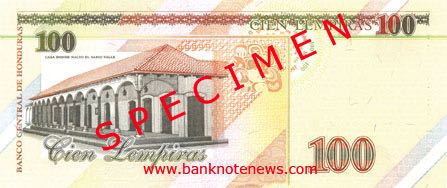

100 lempira (US$5.30), 13 DE JULIO DE 2006. I think this is P95, listed as an expected new issue in the 16th edition of the SCWPM, but it may be a new date variety of P77. If anyone can supply 300-dpi scans of any date varieties of P77, please send them so I can compare details of these notes and confirm the correct classification.
Courtesy of banknoteshop@gmx.net.
Philippines new sig/date (2010 A) 100-peso note confirmed
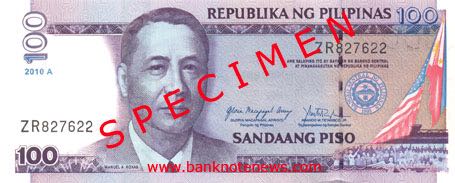
100 pesos (US$2.30), 2010 A. Like P194, but new date. The previously-reported note appeared to have signatures in black, but the note was not UNC and apparently its blue signatures had faded.
Courtesy of banknoteshop@gmx.net and Rodney Hall (Kiwi Coins).
Brunei new date (2008) 1-dollar note confirmed
Nepal new sig. variety 20-rupee note confirmed
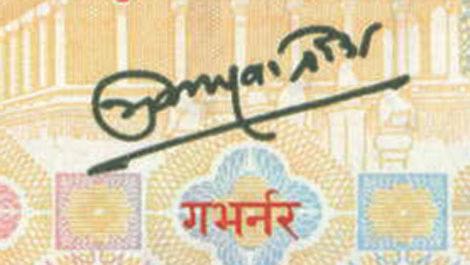
20 rupees (US$0.25), no date. Like P62, but new signature (Yuba Raj Khatiwada). Intro: 05.10.2010.
Courtesy of Shankar Shrestha.
Costa Rica new 20,000-colon note (B562) confirmed
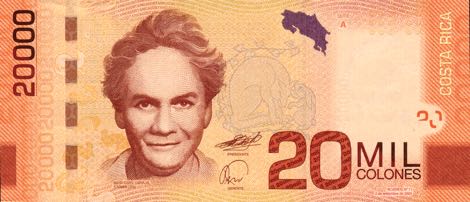

20,000-colon (US$38.70), 2 de setiembre de 2009.
Orange. Front: Spanish text; María Isabel Carvajal (Carmen Lyra); fox and hare; map of Costa Rica in OVI. Back: Spanish text; papelillo flowers; moor; Chispita hummingbird (Selasphorus flammula); rabbits; herbs. Motion windowed security thread and solid security thread. Watermark: María Isabel Carvajal and electrotype 20000. Printer: (Oberthur Technologies). 153 x 67 mm.
According to an article on Inside Costa Rica, bank officials had delayed the introduction due to an error on the small map printed with optically variable ink (OVI) on the front of the note. The error has been discovered on at least 150 notes, and others were examined to determine the extent of the problem.
Courtesy of Chris Twining.
Indonesia dispells rumor of error on 100,000-rupiah note

On 6 October 2010 Bank Indonesia issued the following press release:
No. 12 / 45 / PSHM / Humas
The rumour that Rp100,000 denominated banknotes displaying Soekarno-Hatta would be withdrawn from circulation due to a misprint of the Proclamation of Independence, in particular the inclusion of the year ’05 [in small print between the two portraits on front], can be immediately quashed by the following key points:
1. The inclusion of the Proclamation text on the Rp100,000 banknote corresponds to the original manuscript, more specifically "Djakarta, 17th Day, 8th Month of the Year ‘05". In this case the year ’05 refers to historical facts where Japan remained in power at that time, therefore, the calendar in use is Japanese and refers to the year 2605, abbreviated to ’05.
2. The Rp100,000 banknote issued by Bank Indonesia in 2004 was designed in close collaboration with several relevant parties, including those with extensive knowledge of the proclamation text in question.
3. Therefore, the Rp100,000 denominated banknote exhibiting Soekarno-Hatta is not a misprint and remains legal tender.
4. To all members of the public we appeal to disregard this issue as well as any information that cannot be accounted for.
Krause publishes SCWPM: General Issues Volume II, 13th Edition
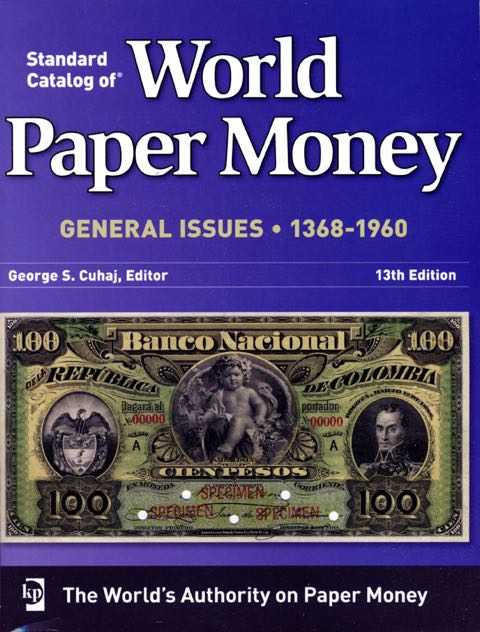
Krause Publications has released a new 13th edition of the Standard Catalog of World Paper Money, General Issues, 1368-1960. I haven’t gotten a copy yet, but according to the press release, key features of the book include:
• 25,100 bank note varieties with current values in three condition grades.
• Enhanced note and color descriptions, allowing users to quickly identify varieties.
• More than 8,000 quality photographs to assist with identification.
• Historical details, grading definitions and numeral charts.
Like it or not, the SCWPM remains "the bible" for our hobby because its Pick numbers are almost universally used to identify notes. If you intend to get a copy despite its flaws, please support this site by buying the latest edition using this link.
Check out other book reviews and news on the Books page of this site.
Egypt new date (11.06.2009) 200-pound note confirmed
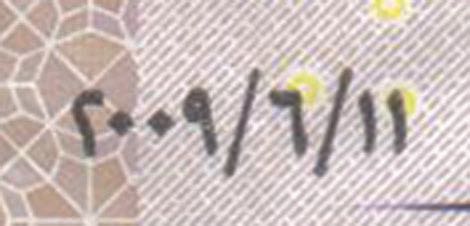

200 pounds (US$35.05). Like P68, but new date (11.06.2009).
Courtesy of Giuseppe Minafra.
Egypt new date (16.09.2009) 50-pound note confirmed
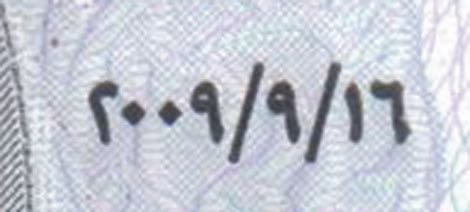

50 pounds (US$8.75). Like P66, but new date (16.09.2009).
Courtesy of Giuseppe Minafra.
Egypt new date (18.08.2008) 5-pound note confirmed
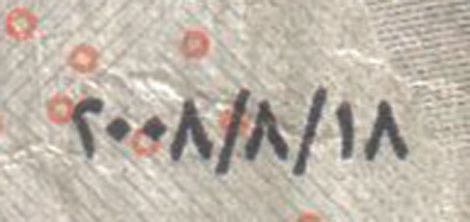
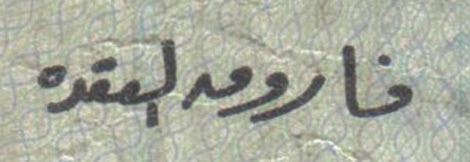
5 pounds (US$0.90). Like P63, but new date (18.08.2008).
Courtesy of Giuseppe Minafra.
Book review: Apples Are From Kazakhstan
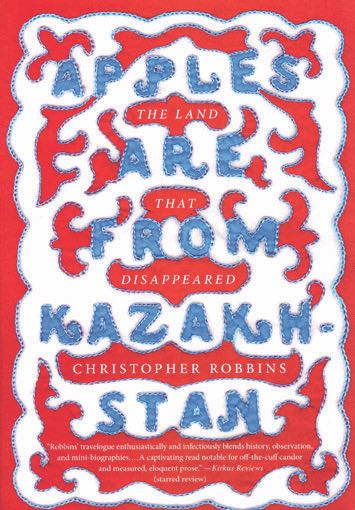
Apples Are From Kazakhstan:: The Land that Disappeared by Christopher Robbins (Order from Amazon.com)
This 296-page paperback book is a fascinating look at a country most Westerners barely know. The English author Robbins does a wonderful job of weaving his personal experiences in this former Soviet republic with rich historical background, from ancient times to repression under Russian rule in the last century. Of particular interest to banknote collectors is the chapter in which Robbins recounts the secret—and ultimately successful—plan to introduce tenge banknotes in 1993 to avoid being at the mercy of Moscow when it replaced the Soviet ruble with the new Russian ruble.
Check out other book reviews and news on the Books page of this site.
Ethiopia new date (2008) 1-birr note confirmed
How well do you know the Ghana cedi?
European Monetary Union to introduce 2nd-generation euro notes as early as 2013
Courtesy of Ricardo Castedo.
United States new 100-dollar note delayed
Yemen new 1,000-rial note (B129) confirmed
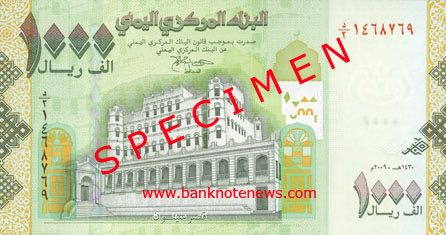

1,000 rials (US$4.65)
Yellow and green. Front: Sultan’s palace in Seiyun, Hadramaut. Back: Bab al Yemen (main gate of Sana’a). Holographic security thread with demetalized ١٠٠٠. Watermark: Coat of arms and electrotype ١٠٠٠. Printer: (Goznak). 156 x 83 mm. ٢٠٠٩/١٤٣٠ (2009/AH1430). Signature 10. Intro: August 2010.
Courtesy of Manuel Rui Palhares.
Nigeria plans to redesign its banknotes
India new 10-rupee note with S inset letter reported
Additional information and images are requested.
Swaziland new 100-lilangeni note reported
“The Central Bank of Swaziland has initiated a project to upgrade its entire series of banknotes in view of the fact that the existing portrait shown of His Majesty King Mswati III is outdated. Also banknote durability and security technology has advanced significantly since the issuing of the current series of notes in 1999,” Governor, Martin Dlamini said in a press statement. Older notes currently in circulation will remain legal tender and will be phased out gradually.
It has recently been reported that the 100-emalangeni note has been issued in September 2010.
Courtesy of Leszek Porowski.
Mexico new date (28.10.2008) 50-peso note confirmed

50 pesos (US$3.85), 28 OCT. 2008. Series K with signatures of Jesús Marcos Yacaman (JUNTA DE GOBIERNO/Sub-Governor) and Raúl Valdés Ramos (CAJERO PRINCIPAL/Chief Cashier). Introduced December 2009. Polymer.

50 pesos (US$3.85), 28 OCT. 2008. Series L with signatures of unknown (JUNTA DE GOBIERNO/Sub-Governor) and Raúl Valdés Ramos (CAJERO PRINCIPAL/Chief Cashier). Polymer.
Courtesy of Ricardo G. Ramírez and Thomas Krause.
Sri Lanka new 5,000-rupee note rumored
Palestine considers issuing its own currency
Azerbaijan new 1-manat note (B401a) confirmed

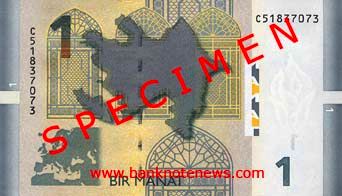
1 manat (US$1.25), 2009. Like P24, but new bank name of Azerbaycan Merkezi Banki instead of Azerbaycan Milli Banki, and new date. Signature remains the same: Elman Rustamov.
Courtesy of Vadim Tislenko and Alberto Fochi.
Philippines considers destroying unissued 2,000-peso note
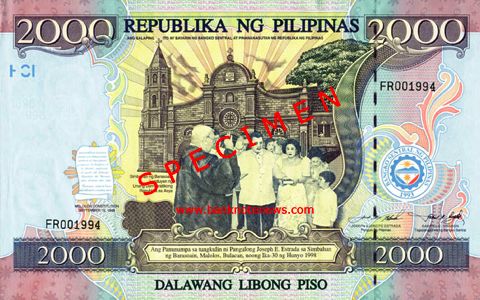
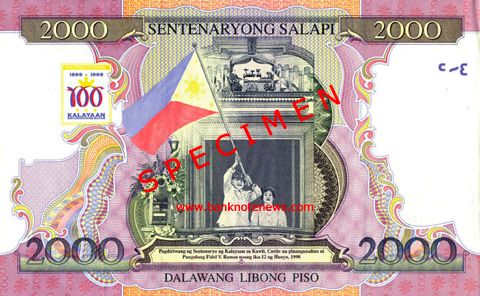
According to an article in mb.com.ph dated 20 September 2010, the Bangko Sentral ng Pilipinas (BSP) is considering circulating or shredding five million 2,000-piso (US$45.50) banknotes currently stored in its vaults. These unissued “New Millennium” notes are more commonly known at the BSP as "Erap" notes because the front features the inauguration of President Joseph "Erap" Estrada at Barasoain Church in Bulacan on 10 June 1998. Printed in 2000, the notes were to circulate in 2001, but President Estrada was ousted from office that year. Even if the bulk of the notes are destroyed, the BSP is considering saving 50,000 pieces which would be demonetized for “historical, educational, numismatic and other purposes.” The BSP currently sells a larger version of this denomination as a centennial commemorative note (P189, shown above).
Fiji 20-dollar notes stolen upon delivery from DLR

According to an article in the Fiji Times Online, late on Friday 3 September 2010 a container arrived at Suva Kings Wharf in Fiji. Inside was supposed to be a special vault containing $1 million (US$519,100) in brand new 20-dollar notes, fresh from De La Rue's security printing plant in the United Kingdom, destined for delivery to the Reserve Bank of Fiji when it opened for business on Monday. However, thieves apparently stole the notes sometime in transit. At first the bank indicated that the stolen notes bearing the serial numbers EB450,001 to 500,000 are not legal tender and should not be accepted, but in the past week has reversed itself and has instructed the public to accept the notes. Given the serial number range, it's likely that these notes are from the same new series introduced in 2007. For your information, 50,000 notes weighs approximately 110 pounds and could easily fit in a large piece of luggage.
Chile new 20,000-peso note (B300) confirmed

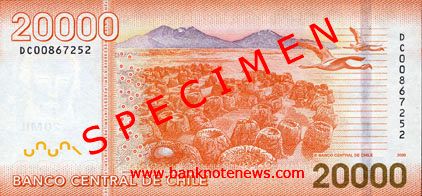

According to a press release dated 8 June 2010, the Central Bank of Chile issued a new 20,000-peso (US$36.50) note on 28 July 2010. Coppery orange in color and measuring 148 x 70 mm, this cotton-based note is the third denomination in a new family of notes, all of which feature representations of the country's natural beauty.
The front of the note features a portrait of Andres Bello based on a painting by French artist Raymond Monvoisin (1790-1870) belonging to the University of Chile. Next to him is the heart of Copihue, the national flower, and Antu, a Mapuche symbol representing the sun that fertilizes the soil.
The back depicts Salar de Surire Monument, located in northern Chile in the region of Arica and Parinacota. It also contains the image of a Chilean Flamingo, a bird that lives in shallow water areas, fresh or salt over the whole country.
Intaglio printed by Crane AB (Sweden), the 20,000-peso note features a portrait watermark with electrotype 20 MIL. There are two security threads; one solid, the other a windowed Motion thread within which there is a Antu, an icon that moves across the banknote is tilted. There is also the denomination printed in green-to-orange OVI. Signatures: José De Gregorio Rebeco and Alejandro Zurbuchen Silva.
Courtesy of Mark Allen, Alberto Fochi, and banknoteshop@gmx.net.
Chile new date (2008) 2,000-peso note (B292c) confirmed

2,000 pesos (US$4.05), 2008. Like P160, but new date and new signatures: José De Gregorio Rebeco and Alejandro Zurbuchen Silva.
Courtesy of Thomas Krause.
Chile new date (2008) 20,000-peso note (B295d) confirmed

20,000 pesos (US$40.50), 2008. Like P159, but new date. Signatures: José De Gregorio Rebeco and Alejandro Zurbuchen Silva.
Courtesy of Claudio Marana.
Dominican Republic unlisted 1-peso commemorative of 1994 confirmed

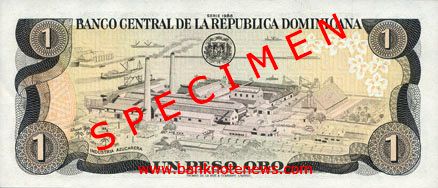
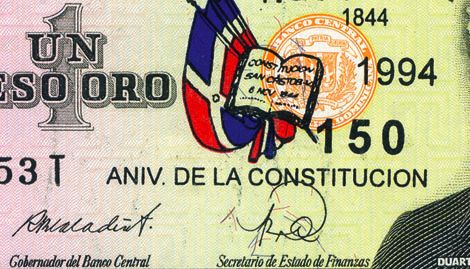
1 peso oro (US$0.02), 1994. This note apparently commemorates the 150th anniversary of the constitution and is overprinted on the 1988 dated note (P126a).
Courtesy of TDS.
Dominican Republic 20-peso commemorative dated 2000 (P166) sought
P.S. I’ve just been informed that this not does not exist as described, and that only P164, a 2,000-peso note, is available with a special 2000 NUEVO MILENIO logo. If anyone can refute this, let me know. Otherwise I will chalk it up as another error in the SCWPM.
Malawi new sig/date (31.10.2009) 50- and 100-kwacha notes confirmed
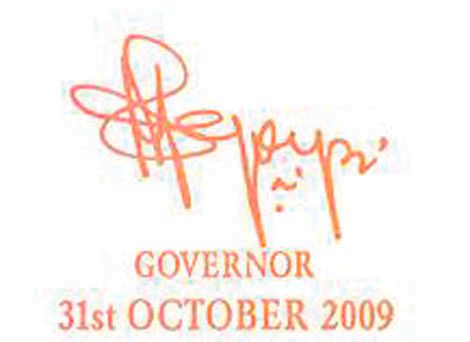
50 kwacha (US$0.35), 31st OCTOBER 2009. Like B144, but new date and new signature (Perks M. Ligoya).
100 kwacha (US$0.65), 31st OCTOBER 2009. Like B145, but new date and new signature (Perks M. Ligoya).
Courtesy of Nazir Rahemtulla.
Saudi Arabia new sig/date (2009) 100-riyal note (B134b) confirmed
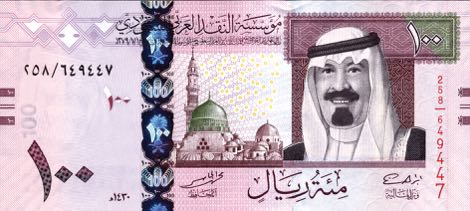
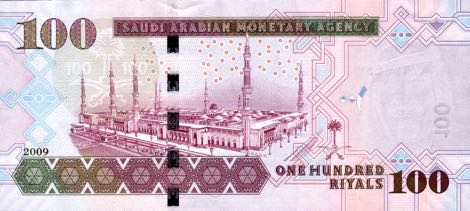
Like B134a, but new date (١٤٣٠/2009) and signatures (Muhammad Al-Jaser and Ibrahim bin Abdulaziz bin Abdullah al-Assaf).
Courtesy of Dr. Ghassan Samman.
Mexico new date (26.03.2002) 500-peso note confirmed
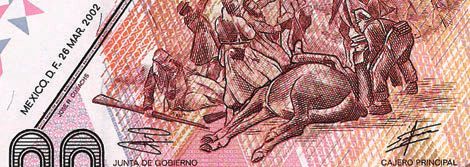
500 pesos (US$38.75), 26 MAR. 2002. Like P120, but new date, new signature, and Serie AG.
Courtesy of Jean-MIchel Engels.
Macedonia new sig/date (00.01.2009) 1,000-denar note (B214b) confirmed
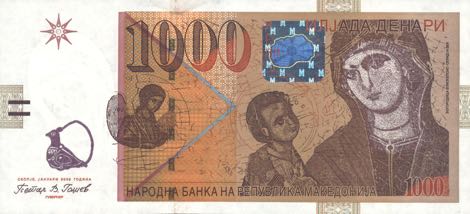
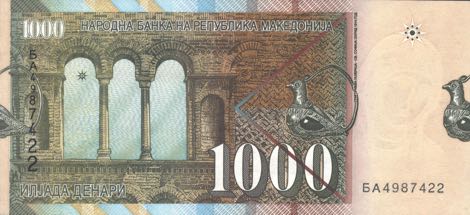
Like B214a, but new date (ЈАНУАРИ 2009) and new signature (Petar Goshev).
Courtesy of Claudio Marana.
Guatemala new 200-quetzal note confirmed
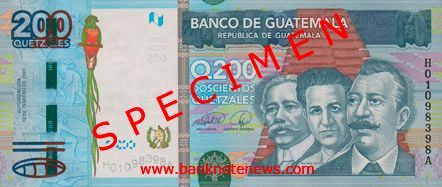
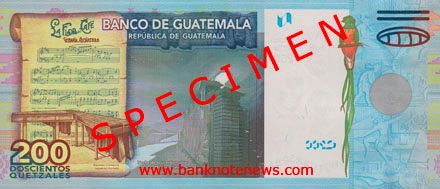

200 quetzales (US$25)
Blue. Front: Quetzal bird; flag; coat of arms; Sebastián Hurtado, Mariano Valverde, and German Alcántara. Back: Musical score of La Flor del Café by Alcántara; marimba chromática instrument by Hurtado; and allusion to Noche de luna entre ruinas by Valverde. Windowed security thread with demetalized 200BG. Watermark: Hurtado, Valverde, Alcántara, and electrotype 200. Printer: (G&D). 156 x 67 mm. 18 DE FEBRERO DE 2009.
The Bank of Guatemala introduced a new 200-quetzal (US$25) note on 23 August 2010 (originally scheduled for November 2009) in response to high demand and counterfeiting rate of the existing 100-quetzal note, which was issued with improved security on 6 November 2009. The Q200 is printed by the German firm Giesecke & Devrient, whereas the Q100 is printed by the Dutch company Joh Enschedé Banknotes. The notes have over 20 security features, including special paper, UV ink, latent image, OVI, security thread, holographic patch, and laser etching of the serial number below the watermark area.
Courtesy of Thomas Augustsson.
Mexico new 500-peso note confirmed
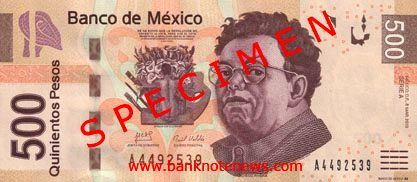


Agustin Guillermo Carstens and Raul Valdes Ramos
P126. 500 pesos (US$38.10). Brown. Front: Calla lily in violet-to-green OVI; Rivera’s mural Desnudo con Alcatraces (Nude with Calla Lilies), three brushes, and painter’s palette; muralist Diego Rivera; map. Back: Map; bank logo; artist Frida Kahlo; Kahlo’s painting El Abrazo de Amor del Universo, La Tierra, (México), Yo, Diego and Señor Xolotl (The Love Embrace of the Universe, the Earth, [Mexico], I, Diego and Mister Xolotl); hummingbird. Windowed Motion security thread and solid security thread. Watermark: Diego Rivera and electrotype 500. Printer: BANCO DE MÉXICO. 148 x 66 mm. 8 MAR. 2010. Serie A. Intro: 30.08.2010.
Courtesy of Rickey Stein and Ricardo G. Ramírez.
Mexico new sig/date (28.10.2008) 20-peso note confirmed

20 pesos (US$1.55), 28 OCT. 2008. Like P122, but new date and signatures (Jose Julian Sidaoui Dib and Raul Valdes Ramos). Series H.
Courtesy of Ricardo G. Ramírez.
Mexico new sig/date (28.04.2008) 20-peso note confirmed

20 pesos (US$1.55), 28 ABR. 2008. Like P122, but new date and signatures (Guillermo Guemez Garcia and Raul Valdes Ramos). Series G.
Courtesy of Ricardo G. Ramírez.
Mexico new sig/date (28.04.2008) 50-peso note confirmed

50 pesos (US$3.85), 28 ABR. 2008. Like P123, but new date and signatures (Jose Julian Sidaoui Dib and Raul Valdes Ramos). Series J.
Courtesy of Ricardo G. Ramírez.
Vanuatu new 10,000-vatu polymer commemorative note confirmed
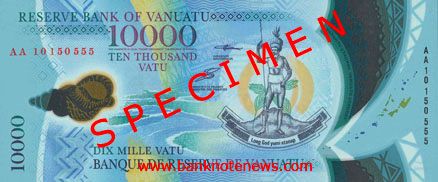


The Reserve Bank of Vanuatu began issuing a new series of banknotes beginning with a polymer 10,000-vatu (US$100) note introduced on 28 July 2010, coinciding with the 30th anniversary of independence. This is the largest denomination in the country. Governor Odo Tevi stated, “The existing note series has come under a lot of pressure over the years, particularly with regard to the lifespan and counterfeiting challenges. It is apparent that in recent years most countries in our region have modernized their currency, therefore it is considered appropriate that in athe 30th year of independence, the Reserve Bank of Vanuatu takes steps to introduce a new modernized series of vatu banknotes.” The new note carries the theme of telecommunication to reflect the recent liberalization of Vanuatu’s telecoms market. The new note was produced by Note Printing Australia.
Courtesy of Kai Hwong, Aidan Work, and Szilard Szemere.
Indonesia new 10,000-rupiah note confirmed
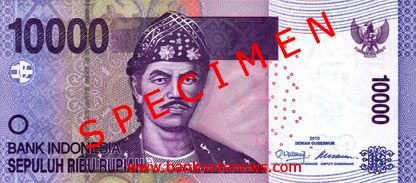
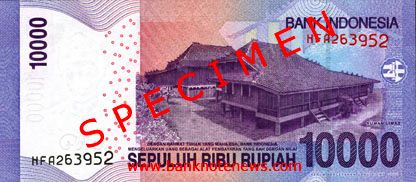
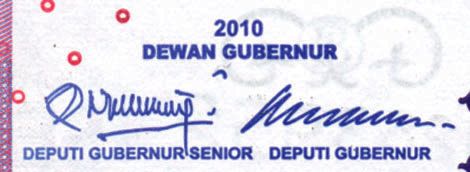
On 20 July 2010, Bank Indonesia began issuing new 1,000-rupiah coins and 10,000-rupiah (US$1.10) notes. The coins have a picture of Garuda Pancasila on the front, and the angklung traditional musical instrument on the back against the background of the Gedung Sate building in Bandung.
The new 10,000-rupiah note is similar to the preceding issue, but the overall color has changed from reddish purple to a bluish purple, and several security features have been revised:
• Additional security elements in the form of rainbow printing in a pentagon shape, which has the effect of changing color (rainbow effect) when observed from certain angles, on the right-hand side of the main image;
• Additional small red (Omron) rings filled in white scattered on the right-hand side of the main image;
• A change to the blind code, consisting of a circle that was previously invisible, which is now visible and noticeable to the touch (intaglio printmaking), positioned on the right-hand side of the main image;
• Discontinuation of Optically Variable Ink in the shape of an octagon, which changed from green to blue when viewed from different angles. Instead opting for the BI design logo framed by an ornament from the Palembang region, which does not change color (offset printing), positioned on the bottom right-hand side of the note.
Courtesy of Bill Stubkjaer.
Singapore new variety 50-dollar note confirmed
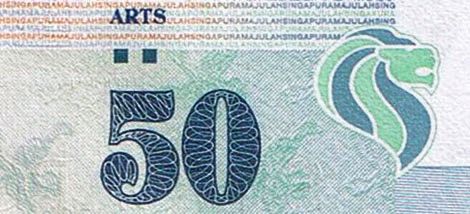
50 dollars (US$37.25), no date. Like P49, but two squares below ARTS on back. Intro: September 2010.
Courtesy of Vincent Tan.
Nigeria new sig/date (2010) 500-naira note confirmed
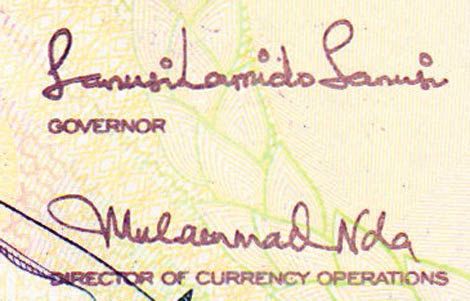
500 naira (US$3.30), 2010. Like P30, but new date (2010) and new signatures (Lamido Aminu Sanusi and Muhammad Nda).
Courtesy of Arigo Avbovbo.
Burundi new reduced-size 100-franc note confirmed

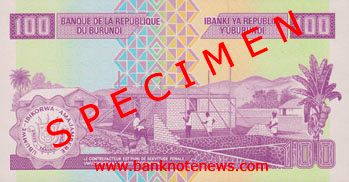
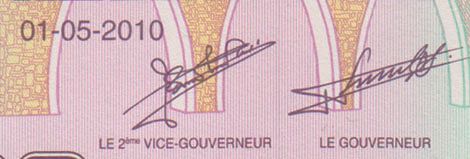
On 5 July 2010, Banque de la Republique du Burundi issued a new 100-franc (US$0.10) note which has been reduced in size to 125 x 65 mm. Older notes of the same denomination remain legal tender until 31 December 2010.
Courtesy of Thomas Augustsson.
Zambia new date (2010) 5,000-kwacha note (B147f) confirmed
Northern Ireland's Northern Bank new date (06.11.2006) 20-pound note confirmed
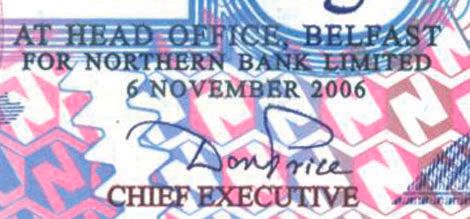
20 pounds (US$30.70), 6 NOVEMBER 2006. Like P206, but new date.
Courtesy of Nazir Rahemtulla.
Hungary new date (2010) 1,000-, 2,000-, and 5,000-forint notes confirmed
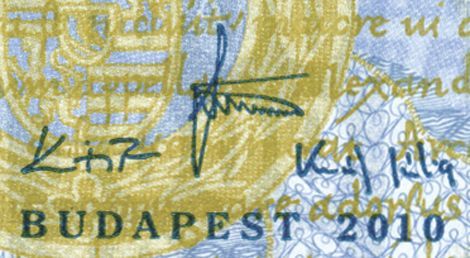
1,000 forint (US$4.50), 2010. Like B582a, but new date, new signatures, and Omron rings.
2,000 forint (US$9.05), 2010. Like B583b, but new date, new signatures (as above), and Omron rings.
5,000 forint (US$22.60), 2010. Like B584a, but new date, new signatures (as above), and Omron rings.
Courtesy of Bill Stubkjaer and Szilard Szemere.
Nepal new signature 10-rupee note confirmed

10 rupees (US$0.15), no date. Like P61, but new signature (Yuba Raj Khatiwada). Intro: 05.09.2010.
Courtesy of Shankar Shrestha (www.nuphil.com).
Origin of color of India's 20-rupee note explained
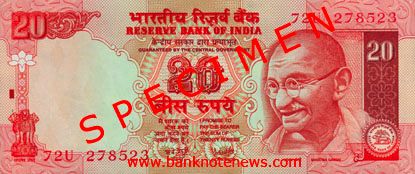
The International Business Times has an interesting article explaining the origin of the color scheme used on India’s 20-rupee (US$0.40) note, shown above (Pick 89A), as well as an examination of the history of banknotes in India.
Saudi Arabia new sig/date (2009) 500-riyal note (B135b) confirmed
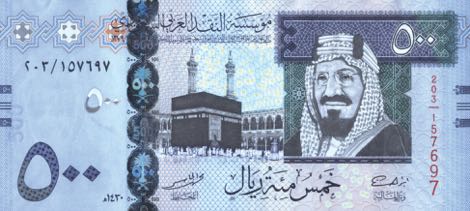
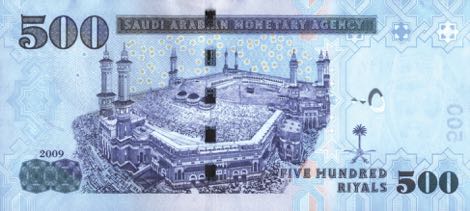
Like B135a, but new date (١٤٣٠/2009) and signatures (Muhammad Al-Jaser and Ibrahim bin Abdulaziz bin Abdullah al-Assaf).
Courtesy of Ghassan Samman.
Pakistan new date (2010) 1,000-rupee note (B238e) confirmed

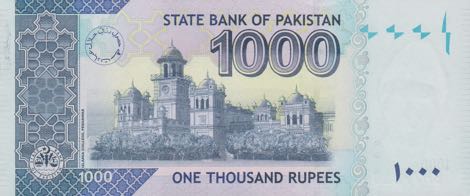
Like B238d, but new date (2010).
Courtesy of Thomas Augustsson.
Pakistan new date (2009) 100-rupee note (B235d) confirmed


Like B235c, but new date (2009) and new signature (Syed Salim Raza).
Courtesy of Bill Stubkjaer.
Mauritius new date (2009) 25-, 50-, and 100-rupee notes confirmed
50 rupees (US$1.60). 2009. Like P50, but new date and new signatures (see below).

100 rupees (US$3.20). 2009. Like P56, but new date.
Courtesy of banknoteshop@gmx.net and Bill Stubkjaer.
Hong Kong new date (01.01.2008) 50-note confirmed

50 dollars (US$6.45), 1 JANUARY 2008. Like Pick 208, but new date and new signature.
Courtesy of Bill Stubkjaer.
Colombia new date (27.08.2008) 1,000-peso note confirmed

1,000 pesos (US$0.55), 27 DE AGOSTO DE 2008. Like P456, but new date.
If anyone owns P456a dated 7 DE MARZO DE 2005 (07.03.2005), please send me scans of same.
Courtesy of Bill Stubkjaer.
Canada new date (2009) 5-dollar note confirmed

5 dollars (US$4.75), 2009. Like P101A (“ISSUE OF 2006”) but new “PRINTED IN” date of 2009 at lower center on back and new signatures (W.P. Jenkins and M.J. Carney).
Courtesy of Bill Stubkjaer.
Bangladesh new date (2010) 1,000-taka note confirmed
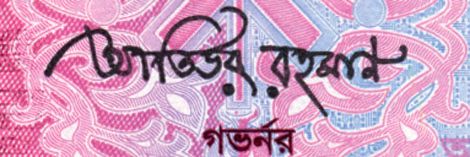
1,000 taka (US$14.35), 2010. Like P51, but new date and signature Atiur Rahman.
Courtesy of Bill Stubkjaer.
Bangladesh new date (2010) 2-taka note confirmed

2 taka (US$0.02), 2010. Like same denomination first issued in 2002, but new date and signature (Mohammed Tareq).
Courtesy of Bill Stubkjaer.
Guatemala new 5-quetzal note confirmed
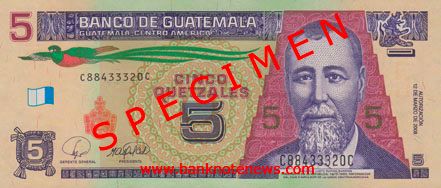


5 quetzales (US$0.60), 12 DE MARZO DE 2008 (12.03.2008). Like Pick 110, but new colors, new date, new signatures, new printer (OBERTHUR TECHNOLOGIES), Guatemalan flag as registration device, and new screen trap over entire background.
Courtesy of Thomas Augustsson.
Northern Ireland's Northern Bank new 10-pound note confirmed

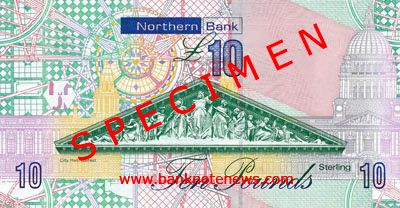
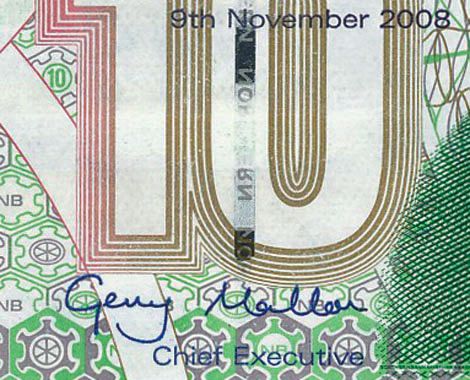
On 29 March 2010, Northern Bank in Belfast introduced a new 10-pound (US$15.10) note that is like P205, but new date, new signature (Gerry Mallon, Chief Executive), new gold foil, Cornerstone watermarks, and slightly redesigned front and back to accommodate the new bank logo.
Courtesy of Jan Ove Larsen.
Norway new date (2009) 200-krone note confirmed
Courtesy of Jan Ove Larsen.
Macedonia new sig/date (00.01.2009) 500-denar note (B213b) confirmed
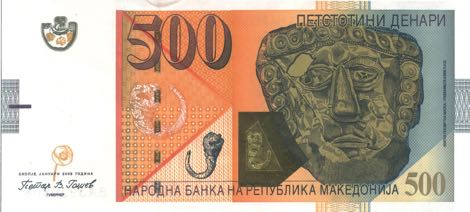
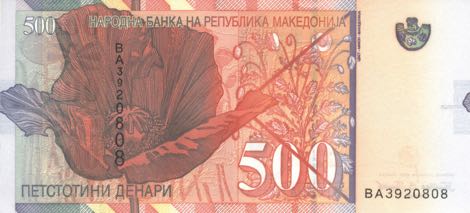
Like B213a, but new date (ЈАНУАРИ 2009) and new signature (Petar Goshev).
Courtesy of Claudio Marana.
Mauritania new 5,000-ouguiya note (B119) confirmed


5,000 ouguiya (US$17.35)
Olive and ochre. Front: The Great Mosque Ibn Abbas in Nouakchott. Back: Unloading iron ore in the port of Nouadhibou; diesel train. Solid security thread printed BANQUE CENTRALE DE MAURITANIE. Watermark: Bearded man. Printer: (G&D). 150 x 70 mm. 28.11.2009. Signature 11. Intro: 08.08.2010.
Courtesy of Thomas Augustsson.
New Caledonia new banknote designs approved
Additional information and images are requested.
Pakistan new date (2010) 500-rupee note (B237b) confirmed


Like B237a, but new date (2010).
Courtesy of Thomas Augustsson.
Mexico new 100-peso note confirmed
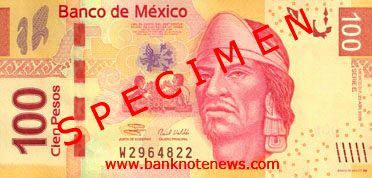
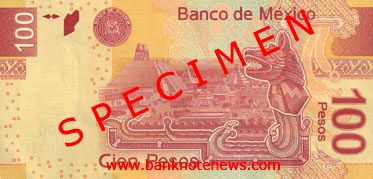

Guillermo Ortiz Martinez and Raul Valdes Ramos
100 pesos (US$7.90), 23 ABR. 2009.
Red and yellow. Front: Ear of corn; poem about zentzontle, a bird represented by jade, flower, and two seated men; warrior poet Nezahualcóyotl. Back: Bank logo; temple, central square, and aqueduct of México-Tenochtitlán; cricket. Windowed Motion security thread and solid security thread. Watermark: Nezahualcóyotl and electrotype 100. Printer: BANCO DE MÉXICO. 148 x 66 mm. Intro: 09.08.2010.
Courtesy of Ricardo G. Ramírez and Claudio Marana.
United Arab Emirates new 20-dirham note (B228a) confirmed


20 dirhams (US$5.40), 2009. Like B216c, but new date, new signatures, and new coat of arms.
Courtesy of Amirali Somji.
Afghanistan new 100-, 500-, and 1,000-afghani notes dated 2008 confirmed


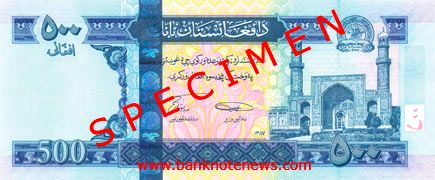


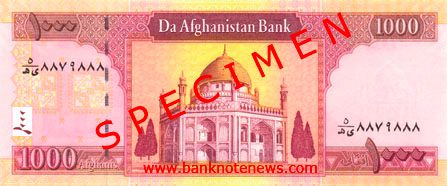
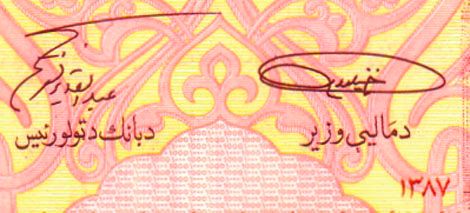
Like P70, P73, and P74, respectively, but repositioned holographic stripes, windowed threads, and registration devices. Also new dates ١٢٨٧ (SH1387/2008) and signatures. Finally, these notes have Cornerstone watermarks.
Courtesy of banknoteshop@gmx.net.
Dominican Republic new date (2009) 500-peso note confirmed
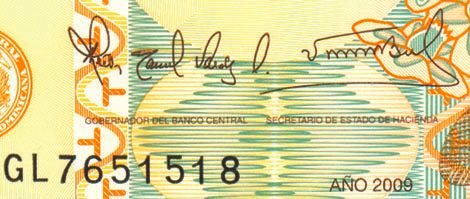
500 pesos (U$13.55), 2009. Like P172, but new date. Signatures: Gobernador del Banco Central, Héctor Valdez Albizu; Ministro de Hacienda, Vicente Bengoa.
Courtesy of banknoteshop@gmx.net.
Bahamas new 10-dollar note (B340a) confirmed
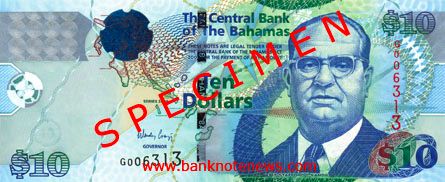
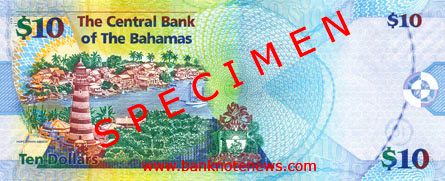
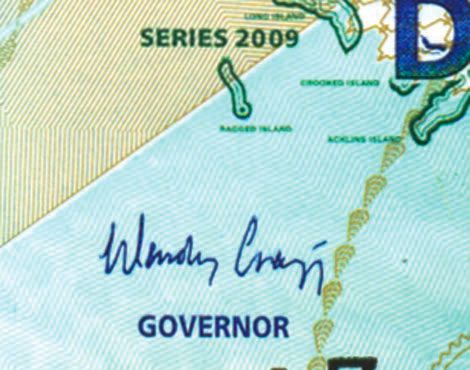
B340 (PNL): 10 dollars (US$10)
Dark blue, dark green, and maroon. Front: Sand dollar; blue foil patch; map; Stafford Sands. Back: Hope Town, lighthouse, Abaco with buildings and boats; coat of arms. Solid security thread and 3-mm windowed security thread with demetalized BAHAMAS. Watermark: Stafford Sands with electrotype 10 and Cornerstones. Printer: DE LA RUE. 156 x 67 mm. 2009. Signature Wendy Craigg. Intro: 2010.
Courtesy of banknoteshop@gmx.net.
Canada new date (2009) 100-dollar note confirmed

100 dollars (US$96), 2009. Like P105 (“ISSUE OF 2004”) but new “PRINTED IN” date of 2009 at lower center on back and new signatures (W.P. Jenkins and M.J. Carney).
Courtesy of Nazir Rahemtulla.
Seychelles new signature 100-rupee note confirmed
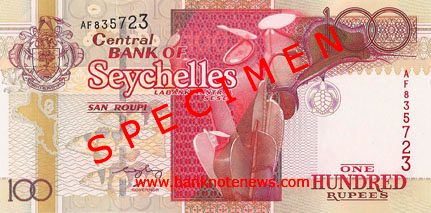
100 rupees (US$8), no date. Like P40, but new signature (Francis Chang-Leng). 2-mm wide security thread, and the vertical serial number is red. It appears these changes took place within the AF prefix range.
Courtesy of Stefan Rombaut.
Switzerland new date (2007) 100-franc note confirmed
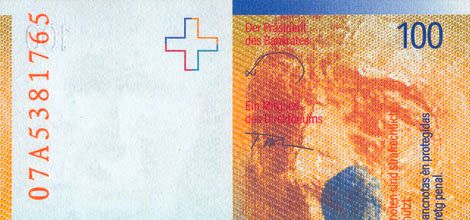
100 francs (US$95). (20)07. Like P72, but new date and new signatures (77).
Courtesy of Christof Zellweger.
Norway scans needed for catalog
I am looking for 300-dpi images of the following banknotes of Norway:
P1
P2
P3
P5
P6
P11
P12
P21
P22
P23
P24
P29
As a contributor, you will receive the satisfaction of taking part in creating something of excellence, your note will be immortalized as the plate note for the catalog, plus your name will appear in the Acknowledgements along with your email address or URL, if you wish.
Thanks in advance for everyone's cooperation!
British West Africa scans needed for catalog
I am looking for 300-dpi images of the following banknotes of British West Africa:
P3 issued or specimen
P4 with Arabic text on back
P5 with blank back
P6 issued note, not specimen
P7 dated 2ND JANUARY, 1930, 21ST JULY, 1930, 10TH DECEMBER, 1943, 29TH NOVEMBER, 1948, and 28TH JULY, 1950
P8 dated December, 1947
P11 dated 31ST MARCH 1953
As a contributor, you will receive the satisfaction of taking part in creating something of excellence, your note will be immortalized as the plate note for the catalog, plus your name will appear in the Acknowledgements along with your email address or URL, if you wish.
Thanks in advance for everyone's cooperation!
Tajikistan new variety 1-somoni note confirmed
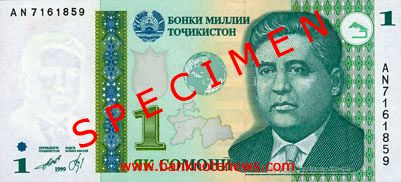

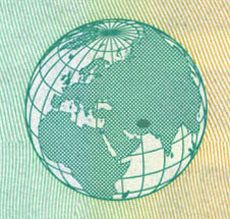
1 somoni (US$0.20), 1999.
On earlier notes the globe at center front is green and orange (P14a, left), but on later notes, the globe is all green (right).
Courtesy of Alexander Petrov.
Colombia congress proposes revaluing currency
Indonesia contemplating currency revaluation
Ghana new watermark 1-cedi note (B145c) confirmed
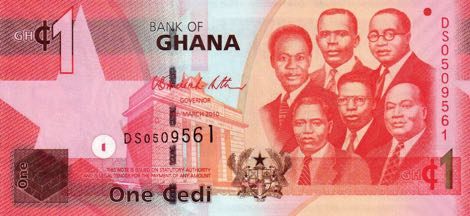

Like B145b, but electrotype denomination added to the watermark.
Courtesy of Claudio Marana.
Thailand to issue new note family in December 2010
Congo Democratic Republic new 500-franc commemorative confirmed
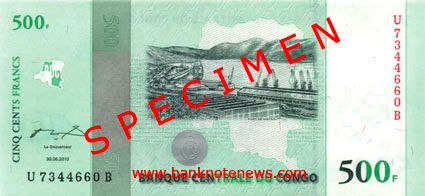
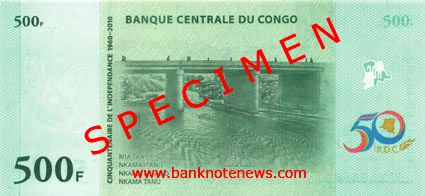
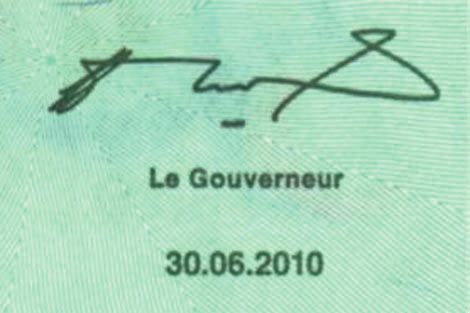
500 francs (US$1), 30.06.2010.
Green. Front: Port of Matadi with buildings, cranes, ships, and mountains; map. Back: Kinsuka bridge; 50th anniversary logo. Solid security thread with demetalized REP DEM DU CONGO. Watermark: Okapi head. Printer: Unknown. 151 x 70 mm.
This note has also been confirmed as a specimen with a diagonal red SPECIMEN overprint.
Banque Centrale du Congo issued 20 million notes to commemorate the country’s 50th anniversary of independence from Belgium. The commemoratives will circulate in parallel with the preceding notes of the same denomination.
Courtesy of Bill Stubkjaer, banknoteshop@gmx.net, and Hartmut Fraunhoffer.
Syria new 50-, 100-, and 200-pound notes confirmed
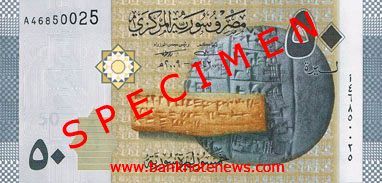
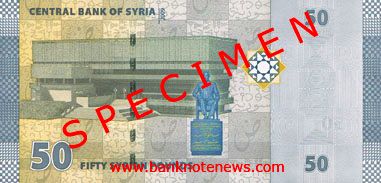
50 pounds (US$1.05), 2009.
Blue and tan. Front: Ancient writing on clay tablets from Ebla. Back: Library of Hafiz Al Assad in Damascus; statue of Hafiz Al Assad. Windowed security thread with demetalized CBS 50. Watermark: Horse head and electrotype 50. Printer: Unknown. 135 x 65 mm.
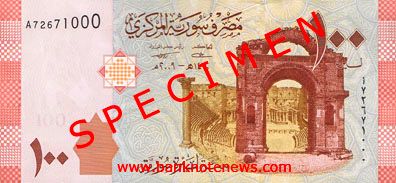

100 pounds (US$2.15), 2009.
Red and tan. Front: Ancient Roman theater and archway of main gate at Bosra. Back: Safe from Umayyad Mosque in Damascus; Central Bank of Syria headquarters building; ancient coin. Windowed security thread with demetalized CBS 100. Watermark: Horse head and electrotype 100. Printer: Unknown. 140 x 65 mm.

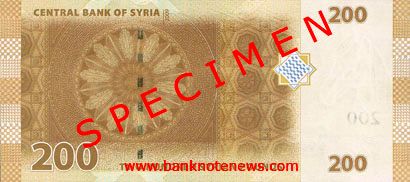
200 pounds (US$4.30), 2009.
Tan and green. Front: Norias (waterwheels) of Hama on the Orontes River. Back: Ceiling of Temple Bel in Palmyra. Windowed security thread with demetalized CBS 200. Watermark: Horse head and electrotype 200. Printer: Unknown. 145 x 65 mm.
These three notes were issued on 27 July 2010 and are dated 2009. They are signed by Adib Mayaleh, Governor and Mohammad Naji Al-Otri, Minister of Economy.
Courtesy of Abdullah Beydoun.
India 2009 20- and 100-rupee notes without inset letters confirmed
100 rupees (US$2.15), 2009. Like P98, but new date and no inset letter.
Courtesy of Jim W.-C. Chen.
Hong Kong new date (01.01.2009) 20-dollar note confirmed
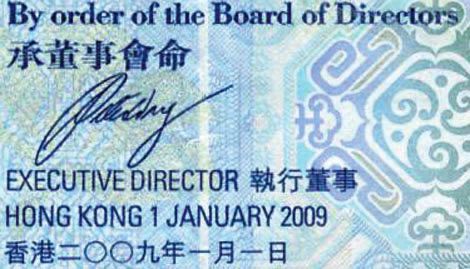
20 dollars (US$2.60), 1 January 2009. Like P207, but new date.
Courtesy of Michael Reissner.
Dominican Republic new 20-peso oro polymer note confirmed
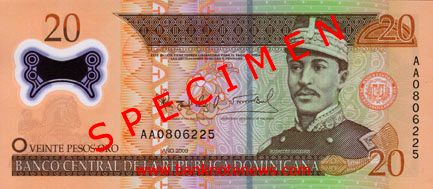
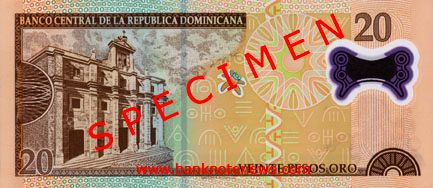

According to a press release, on 1 July 2010 the Dominican Republic's Central Bank issued a new 20-peso oro (US$0.55) note that is like P169, but now printed on polymer. Signatures: Gobernador del Banco Central, Héctor Valdez Albizu; Ministro de Hacienda, Vicente Bengoa. More info can be found here.
Courtesy of Claudio Marana, Art Matz, and Hartmut Fraunhoffer.
Japan's 2,000-yen note popular in Okinawa
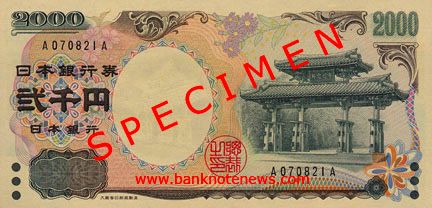
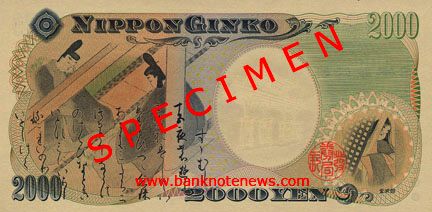
Okinawa still likes the unpopular 2000-yen note
The Japanese currency note is the only one in circulation bearing the number ‘2’, enough of a rarity to make people distrust it, leaving only Okinawans as champions of the beleaguered money.
The Bank of Japan began issuing the ¥2000 bill on July 19, 2000 to commemorate the Group of Eight summit in Okinawa, but this bill didn’t catch on with the general public and remains unpopular. There are around 110 million ¥2,000 notes in circulation, about 1% of all Japanese currency.
Okinawans have good reasons for loving the bill; the Okinawan symbol ’Shureimon’ is printed on one side of the bill. The Shureimon Gate in Naha was built in the 16th century as the main gate to Shuri Castle. Shureimon Gate is a symbol of peace, and Okinawans say they want “to promote the spirit of peace from Okinawa” with the ¥2,000 note. Local Okinawa businesses have begun a campaign to promote use of the currency, with local banks converting ATM machines to accept them and shopping malls now giving change in ¥2,000 notes.
The Bank of Japan stopped issuing the ¥2000 bill in fiscal year 2003, and has kept tons of the bills stored in its safe. The circulation of this bill peaked in 2004 but has been in decline ever since. There are various reasons to unpopularity of the ¥2000 bill. The bill resembles the ¥5000 note, and the lack of ATMs that issue them when customers draw cash have made citizens wary.
Courtesy of Mike Link.
Ghana new 2-cedi note (B150) confirmed

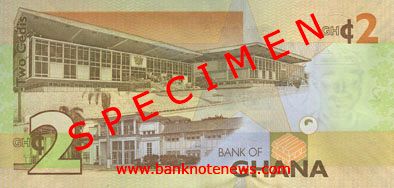

On 14 May 2010, the Bank of Ghana introduced a new 2-cedi (US$1.40) banknote to meet public need for an intermediary denomination and reduce the frequency, and associated cost, of printing large volumes of the GH¢1 banknote. The bank also acknowledges that the use of a single, identical portrait (The Big Six) on all the five denominations introduced in the July 2007 re-denomination exercise (and the previous ¢10,000 banknote that was withdrawn from circulation in 2007) makes it hard for the public to distinguish between denominations. As such, the bank has chosen to recognize departed national heroes who positively impacted on the lives of Ghanaians, such as Dr. Kwame Nkrumah, whose portrait appears on the new 2-cedi note in commemoration of the centenary of his birth. The back of the note depicts the old and new Parliament buildings, signifying Ghana’s deepening democracy.
The introduction of the new coincides with the conclusion of the year-long centenary celebrations of the birth of Dr. Kwame Nkrumah, Ghana’s first president, and has the commemorative text “CENTENARY OF THE BIRTH OF DR. KWAME NKRUMAH”. Future issues of the GH¢2 banknote are not expected to have this text; making this introductory issue a collector’s item.
Courtesy of Dieter Eheim.
Armenia new sig/date (2009) 5,000- and 20,000-dram note confirmed

5,000 dram (US$13.65), 2009. Like P51, but new date and new signatures.

20,000 dram (US$54.60), 2009. Like P53, but new date and new signatures.
Courtesy of Armen Hovsepian (www.MEBanknotes.com).
Hong Kong unveils new 500- and 1,000-dollar notes
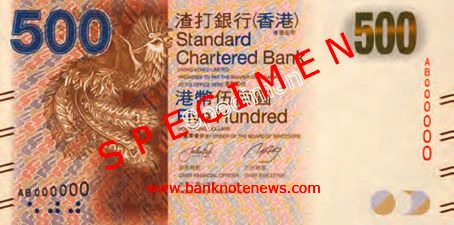

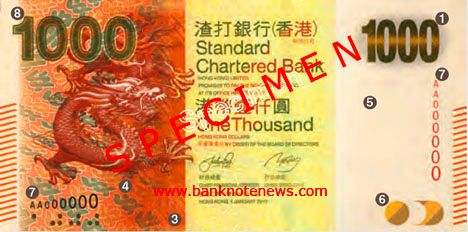
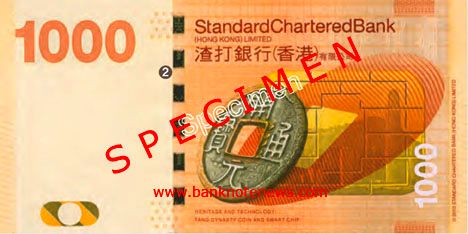
On 20 July 2010, the Hong Kong Monetary Authority announced it will begin producing banknotes with Braille and embossed lines for benefit of the visually impaired. The new notes will be phased in over the next two years and will feature Braille at the bottom left corner of each note, together with embossed lines that correspond with each notes value.
The HK$1,000 (US$129) and HK$500 (US$65), which were unveiled at the press conference, will be put into circulation in the last quarter of 2010 and early 2011, respectively. The design of the remaining three denominations, HK$100, HK$50 and HK$20, will be unveiled in mid-2011.
Each of the three banknote-issuing banks, the Bank of China, HSBC and Standard Chartered, will issue their respective versions. All will retain the current color schemes.
Visit the official HKMA site for more information.
India's unique challenge of making money from cotton waste
De La Rue admits problems at one banknote paper mill
Book Review: World Paper Money Errors
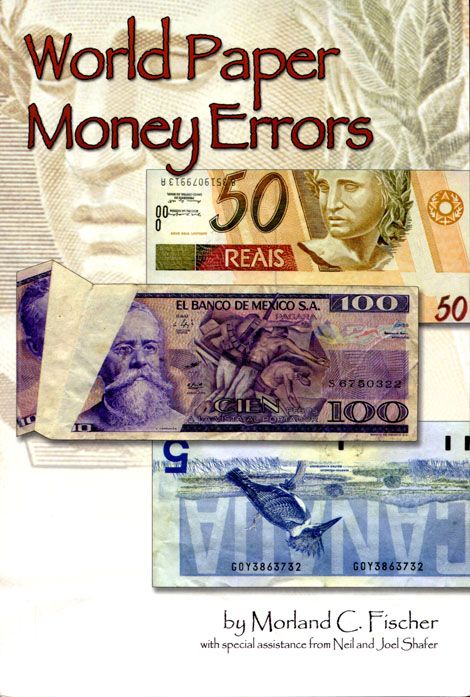
World Paper Money Errors by Morland C. Fischer (Order from Amazon.com)
250 pages, soft cover, 230 x 150 mm, color illustrations, English, published by Zyrus Press Publishing, ISBN 978-1-933990-25-5
Reviewed by Owen W. Linzmayer
While there are several catalogs covering United States paper money errors, this book is the first attempt at a systematic approach to describing, documenting, and pricing errors on world banknotes. As such, it’s an important new addition to the world’s numismatics knowledge base, but it suffers from some shortcomings I hope will be addressed in future editions.
Author Morland C. Fischer does a very good job of explaining the various types of errors found on banknotes and has distilled them down to an eight-point FEN (Foreign Error Note) ranking system in which higher numbers correspond to more significant errors. Reasonable people might disagree over whether a missing overprint is more dramatic an error than an inverted back (FEN 4 and 7, respectively), but the codification of the taxonomy of errors is a welcome improvement to a subjective field of study.
The bulk of the book is devoted to illustrating the various error types, each broken into their own chapters. I found the introductory explanations of how specific types of errors happen in the production process particularly interesting. The book has color illustrations throughout, usually with the front and back of the error note at 50% actual size, along with a non-error note for comparison. This allows you to see the magnitude of the error and appreciate the artwork and intended design of the reference note, although some illustrations would have benefited by close-ups or annotations to highlight the affected areas of the note. There are lots of examples from many different countries and time periods, which is good overall, but it’s overkill for some types of errors, such as missing serial numbers, which are easy to understand without repetitive illustrations.
Personally, I would have liked to see more plate errors—also known as engraving errors—because I find man-made errors more intriguing than machine mistakes. As a writer and editor myself, I’m amused by the fact that central banks sometimes fail to catch embarrassing typos until after printing and issuing millions of notes into circulation. Alas, there are only a dozen such errors discussed. Entirely lacking are any examples of errors in security features, such as when a thread intended for one note appears in another, or the wrong watermark is used.
Anyone who has contemplated buying an error note will do well to first read the chapter on “pseudo” errors. At first glance these appear to be errors, but may have been intentionally created by unscrupulous collectors/dealers by miscutting individual notes from sheets or using chemicals to alter notes, for example. Sometimes they aren’t errors at all, but rather printers’ waste, proof notes, or remainders. Buyer beware.
Ironically, the author is not immune to making errors of his own. For example, he mistakes the front and back of Ukraine’s 20-hryvan note of 1992 (Pick 107), includes a 1,000-shilling fantasy note from Somaliland without mentioning its dubious origin, and the last few pages of the book are incorrectly set in fonts of varying size, resulting in a jumbled appearance. However these are all minor quibbles; for the most part the content is solid and unassailable.
My main complaint with this book is that author tries too hard to make the case that world error notes are undervalued. He provides a number of possible explanations for the disparity in prices between comparable errors on US and foreign notes, yet ignores what might be the most obvious explanation of all: differences in the values of the corresponding non-error notes. For example, he laments that a foldover error on a United States 10-dollar note dated 1969C (Pick 451d) is worth $1,000 - 2,000 whereas a similar printing error on a Mexican 500-peso note (Pick 69) is valued at $200 - 300. But when you consider that the SCWPM lists non-error examples of the former at four times the value of the latter, the price disparity between the errors doesn’t seem so significant nor unwarranted.
Judging by the passion with which he approaches his subject, it is apparent that the author loves error notes, but his insistence that world error notes are “undervalued,” with “considerable upside potential,” and “could be ready to explode,” comes across as a hard sell by someone with an agenda. I found cause for pause when reading “In some instances, a price may appear to be unusually high. However, prices were chosen to indicate what should be [emphasis mine] the fair market value…Moreover, the assigned price ranges reflect an extrapolation of expected prices over a period of five years from publication.” Pricing non-error world notes is fraught with difficulties (fluctuations in currency exchange rates and differences in foreign/domestic demand for a country’s own notes, for example) which are only compounded when considering far less common—sometimes even unique—error notes and trying to guess what they should be worth far into the future. The book would have greater credibility if it merely reported current free market prices and suggested reasonable premiums a collector might expect to pay for different types of errors.
World Paper Money Errors carries a list price of US$34.95 and can be ordered directly from Zyrus Press Publishing, P.O. Box 17810, Irvine, CA 92623. (888) 622-7823. www.zyruspress.com or purchased from Amazon at a significant discount.
New currency following dissolution of Netherlands Antilles?
Courtesy of Stein Langørgen.
India approves new symbol for rupee

On 15 July 2010, India’s Union Cabinet approved a symbol for the rupee which is a combination of the Roman “R” without the vertical stroke and the Devnagri letter “ra.” The symbol was designed by Bombay IIT postgraduate D Udaya Kumar. A finance ministry official said the government is not planning to print banknotes with the new symbol. Historians say that the first “rupee” was issued by Emperor Sher Shah Suri in the 15th century. One rupee was equivalent to 40 copper paisas then. The rupee is believed to be derived from the Sanskrit word raupya, which means silver.
Hong Kong banknote exhibit opens
Mr Chan said, "HSBC's exhibition of the banknotes issued by the bank in the past 145 years, in the Hong Kong Pavilion at the first-ever World Expo hosted by our country in the city of Shanghai, has special meaning. "The banknotes featured in this exhibition are precious and very interesting. Many are rare, and some have never been publicly shown before." "Stories Behind Banknotes" provides a unique insight into the social and economic transformation of Hong Kong since HSBC issued its first banknote in the city in 1865.
Among the 56 banknotes featured is the "duress note" issued during the Japanese occupation of Hong Kong in World War II. Other rare notes from Shanghai and other note-issuing branches across China are also displayed. HSBC Chief Executive Officer Hong Kong Mark McCombe said, "The Hongkong and Shanghai Banking Corporation Limited has been the principal issuer of banknotes in Hong Kong since the bank issued its first banknote in 1865, the year of its establishment.
"Currently, approximately two out of every three banknotes in circulation in Hong Kong are issued by HSBC. HSBC's banknotes and their constantly shifting designs illustrate the trade and financial development of the region and provide a valuable insight into the culture and character of the city."
Latvia new date (2009) 5-lat note confirmed
Zambia new date (2010) 50,000-kwacha note (B150f) confirmed
Mongolia new 20,000-tögrög note (B436) confirmed
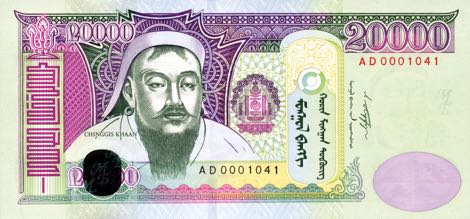
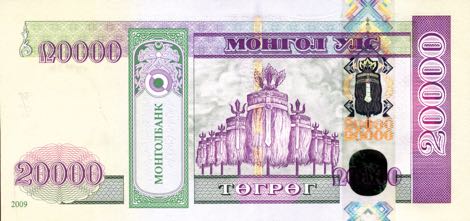
According to a notice on the Bank of Mongolia’s web site, a new 20,000-tögrög (US$14.60) note was issued on 25 May 2010.
The note dated 2009 is like the one issued in 2006 (B427), but has a varifeye thread.
Light green and yellow. Front: Chinggis Khaan; holographic Soyombo symbol; warrior on horseback. Back: State Nine White Banners. varifeye thread and 3-mm windowed security thread with demetalized MONGOLBANK. Watermark: Chinggis Khaan and electrotype МБ. Printer: (G&D). 152 x 72 mm.
If anyone can translate this press release into English, I would appreciate hearing from you so that I can share the info with others.
Courtesy of Thomas Augustsson, Roman Boroznjak, and Nin Cheun.
India new date (2010) 20-rupee note confirmed

20 rupees (US$0.40), 2010. Like Pick 96, but new date, new signatures, and E inset letter.
Courtesy of Bill Stubkjaer.
India new date (2010) 500-rupee note confirmed

500 rupees (US$10.70), 2010. Like Pick 99, but new date, new signatures, and R inset letter.
Courtesy of Bill Stubkjaer.
New holographic technology has designs on banknote security
Today, holographic technology remains very much to the fore as part of an array of overt features which make it quick and easy for people to recognise whether or not a banknote is bonafide. But new substrate technology, particularly the introduction of transparent ‘windows’ is being incorporated on banknotes to provide new levels of anti-counterfeiting complexity.
The commemorative 1,000 Tenge note produced by Papierfabrik Louisenthal for Kazakhstan and launched earlier this year takes optical sophistication to a new level. Not only does it feature a hologram showing typical rainbow colours but a small microlenticular patch viewed by transmission. The system is called Varifeye® and combines the best features of paper and polymer.

The optically variable feature on the new 1000 Tenge note of Kazakhstan showing microlenticular feature in the window and demetallised hologram below.
Previously, a deckle-edge window was created in the paper substrate during the process of cylinder-mould web formation as the stock fibers collect against the deckle, leading to the characteristic feather look. Latterly, the window has been cut into the paper after laminating to a polymeric layer. Then a clear stripe of film is laminated over it running from top to bottom of the note. The clear stripe contains the microlenticular image of a camel interchanging with the letter ‘K’ when tilted.
This feature can be viewed by transmission through the window. There is also a demetallised holographic image of the Astana Baiterek monument above the text ‘Organisation for Security & Co-operation in Europe’, interchanging with the date 2010 which are viewed by reflection where it falls over the paper. (This technology was first used on the Bulgarian lev banknotes in 2005, becoming the world’s first paper notes with see through window).
For polymeric substrates, the Bank of Australia has developed its Non-diffractive Switching Image (NSI). This appears like a dynamic watermark in the clear window of a polymer-based note. Being non-diffractive, the images are seen in varying shades of grey rather than rainbow colours and switching of the image elements occurs by rotation rather than tilting.
Mexico has also embraced new technology – the country’s 100 peso note has an ingenious feature which outwardly looks holographic but is in fact transparent optically variable inks (they are usually opaque) printed on the clear window of a polymer note. The viewer can look at the feature either by transmission or reflection. The inks change colour in both modes but the colours seen by transmission are the complementary colours of those seen by reflection.
The latest innovation in holographic technology which makes use of traditional (though modified) embossing technology is the Asterium feature from Toppan printing in Japan. Viewed in normal direct light this feature appears black but when inclined at an extreme angle, the rainbow colours of an embossed hologram appear. The important feature here is the optical black which gives a new aesthetic to documents and only reveals the colourful security feature as and when required.

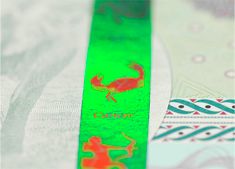
Asterium from Toppan uses optical black in conjunction with a hologram.
Another innovator, Kurz, has developed a revolutionary wafer thin security photopolymer which can record a volume holographic image for banknotes produced for Swiss National Bank. Kurz’s success has been to develop the material thin enough for use on a banknote, especially given that the reason this is called a ‘volume’ hologram is that the interference fringes are recorded within the depth of the photo-sensitive material. Similar developments are taking place in Japan where Dai Nippon Printing is leading the way.
OVD Kinegram, a division of Leonhard Kurz, continues to push the boundaries with its Kinegram reColor®. This has been developed for use as a laminate in conjunction with a window or aperture in the banknote substrate, and provides fundamentally different, and unexpected, effects depending on whether the note is viewed from the front or reverse. On the front the viewer sees a normal metallised reflective, diffractive image, while the reverse view shows a patterned coloured foil also displaying the diffractive features. The trick is performed using different coloured resist lacquers in the demetallization process. More remarkable still is Kinegram reView® which appears the same, metallic color on both sides of the image although the images seen on the two faces can be different and unrelated to each other.
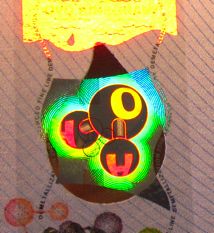
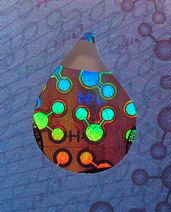
ReView from L. Kurz displays different holographic images when viewed from opposite side of a window.
One way or another, it seems that the window technology now becoming available to printers of banknotes is here to stay. Formerly, the opaque nature of security printing paper only allowed a watermark to be seen by transmission but most holograms are, by nature, transmissive and are rendered reflective by applying a metal coating. Once the opportunity is presented to allow them to be seen by transmission, as in a window, the opportunities for an optical tour de force are increased. This renders the note more visually attractive to inspectors and consumers and more difficult to simulate by counterfeiters.
However, here’s a cautionary word. Any trend towards simplification must be seen as a move in the right direction and run hand in hand with artists and graphic designers’ abilities to make good use of the media or of the public’s ability to appreciate and evaluate the security benefits offered by the latest technology. After all, it’s not as though holograms represent the only security feature on a banknote.
They are often one of many - for example, the 1000 Tenge note for Kazakhstan has at least 16 features including one to help the blind or partially sighted. So, it isn’t necessary to fill the hologram with every conceivable feature rather remember why the hologram was originally introduced: it provided a feature that could not be photocopied. Photopolymers provide this, so there’s no reason to suppose that holographic technology will not continue to be an integral security feature on future generations of banknotes.
END
The International Hologram Manufacturers Association (IHMA) is made up of 90 of the world's leading hologram companies. IHMA members are the leading producers and converters of holograms for banknote security, anti-counterfeiting, brand protection, packaging, graphics and other commercial applications around the world. IHMA member companies actively cooperate to maintain the highest professional, security and quality standards.
Issued on behalf of the IHMA by Mitchell Halton Watson Ltd. For further details contact Andy Bruce on +44 (0) 191 233 1300 or email andy@mhwpr.co.uk
Philippines central bank unveils new logo

Bangko Sentral ng Pilipinas (BSP) has unveiled a new logo which will be included in the new generation of banknotes by December 2010.
The following description comes from the bank’s web site:
The new BSP logo is a perfect round shape in blue that features three gold stars and a stylized Philippine eagle rendered in white strokes. These main elements are framed on the left side with the text inscription “Bangko Sentral ng Pilipinas” underscored by a gold line drawn in half circle. The right side remains open, signifying freedom, openness, and readiness of the BSP, as represented by the Philippine eagle, to soar and fly toward its goal. Putting all these elements together is a solid blue background to signify stability.
Principal Elements:
1. The Philippine Eagle, our national bird, is the world’s largest eagle and is a symbol of strength, clear vision and freedom, the qualities we aspire for as a central bank.
2. The three stars represent the three pillars of central banking: price stability, stable banking system, and a safe and reliable payments system. It may also be interpreted as a geographical representation of BSP’s equal concern for the impact of its policies and programs on all Filipinos, whether they are in Luzon, Visayas or Mindanao.
Colors
1. The blue background signifies stability.
2. The stars are rendered in gold to symbolize wisdom, wealth, idealism, and high quality.
3. The white color of the eagle and the text for BSP represents purity, neutrality, and mental clarity.
Font or Type Face
Non-serif, bold for “BANGKO SENTRAL NG PILIPINAS” to suggest solidity, strength, and stability. The use of non-serif fonts characterized by clean lines portrays the no-nonsense professional manner of doing business at the BSP.
Shape
Round shape to symbolize the continuing and unending quest to become an excellent monetary authority committed to improve the quality of life of Filipinos. This round shape is also evocative of our coins, the basic units of our currency.
Barbados new signature variety confirmed

The signature of Dr. DeLisle Worrell, governor of the Central Bank of Barbados since 2 November 2009, has been confirmed on 2- (P66) and 5-dollar (P67) notes.
Courtesy of Art Matz.
Iran new 100,000-rial note confirmed

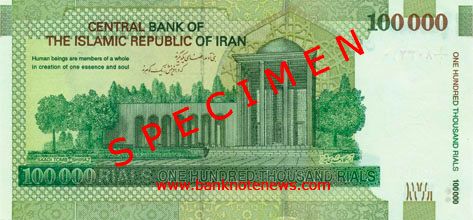
According to a Bloomberg BusinessWeek article dated 16 June 2010, the Central Bank of the Islamic Republic of Iran issued a new 100,000-rial (US$10) note on 22 June. Governor Mahmoud Bahmani said the bank will print at least 150 million of the new notes, though he promised it won’t increase the inflation rate (currently around 10 percent). The new banknotes will reduce the need for cheques (banknote-like documents available in denominations of half- and one-million rials) that Iranians buy from banks to use in large transactions. Cheques are transferred between individuals in the same way as cash, but are canceled when presented at banks for deposit.
Green. Front: Ayatollah Ruhollah Khomeini. Back: Lines from Gulistan (The Rose Garden), a poem by Saadi; trees and Saadi’s tomb in Shiraz. Solid security thread with printed Arabic text and windowed security thread with demetalized 100000. Watermark: Ruhollah Khomeini and electrotype 100000. Printer: Unknown. 166 x 79 mm. No date. Signature unknown. Intro: 22.06.2010.
Courtesy of Saeed Abdullah, Abdullah Beydoun, and Armen Hovsepian.
Sierra Leone resized note family confirmed
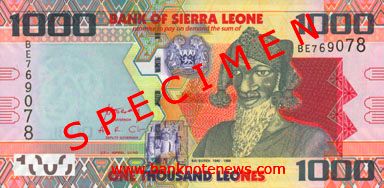
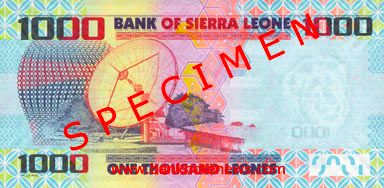
1,000 leones (US$0.25). Red and yellow. Front: Coat of arms; carving; Bai Bureh. Back: Telecommunications satellite dish. Windowed security thread with demetalized BSL. Watermark: Lion head and electrotype 1000. Printer: DE LA RUE. 135 x 67 mm. 27th APRIL 2010. Signature 18. Intro: 14.05.2010.

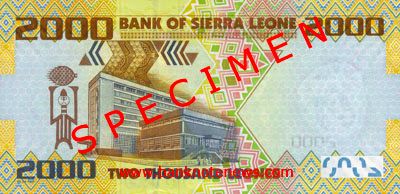
2,000 leones (US$0.50). Blue and orange. Front: Double diamond foil patch; coat of arms; cargo ship and port building; I.T.A. Wallace Johnson. Back: Bank of Sierra Leone building. Windowed security thread with demetalized BSL. Watermark: Lion head and electrotype 2000. Printer: DE LA RUE. 140 x 69 mm. 27th APRIL 2010. Signature 18. Intro: 14.05.2010.

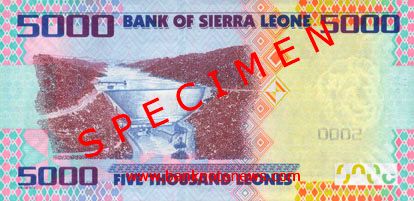
5,000 leones (US$1.25). Blue and purple. Front: Foil patch; coat of arms; building; Sengbe Pieh. Back: Bumbuna Dam. Windowed security thread with demetalized BSL. Watermark: Lion head and electrotype 5000. Printer: DE LA RUE. 145 x 71 mm. 27th APRIL 2010. Signature 18. Intro: 14.05.2010.
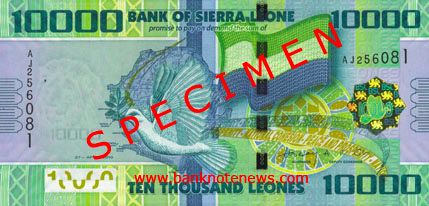
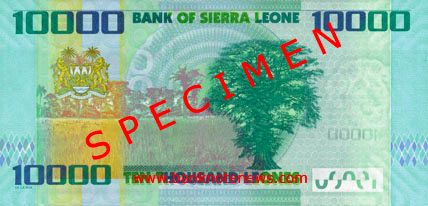
10,000 leones (US$2.55). Blue and green. Front: Dove flying over the map of Sierra Leone; national flag; holographic patch. Back: Coat of arms; cotton tree. Windowed security thread with demetalized BSL. Watermark: Lion head and electrotype 10000. Printer: DE LA RUE. 153 x 73 mm. 27th APRIL 2010. Signature 18. Intro: 14.05.2010.
Courtesy of Rui Manuel Palhares.
French Pacific Territories new signature 1,000-franc note confirmed

1,000 francs (US$10.30), no date. Like P2, but new signatures (Yves Barroux, Christian Noyer, and Patrick Besse).
Courtesy of Rui Manuel Palhares.
Explanation of A after year on Philippine banknotes
“The serial number on Philippine banknotes consists of two (2) alpha and six numerics per denomination. The total number of banknotes per denomination that can be printed with SN A0000001 to SN ZZ1000000 is 600 million pieces. When the actual production of banknotes per denomination exceeds 600 million pieces, the suffix A is added after the year mark in order to avoid duplication of the serial number.”
Estonia to adopt euro in 2011
Courtesy of Stein Langørgen.
Sri Lanka new date (03.07.2006) 100-rupee note confirmed

100 rupees (US$0.90), 2006-07-03. Like P118, but new date and new signatures (Mahinda Rajapaksa and Ajith Nivard Cabraal).
Courtesy of TDS.
Pakistan bank governor resignation confirmed
Courtesy of Aidan Work.
Bangladesh new date (2010) 500-taka note confirmed

500 taka (US$7.20), 2010. Like P50, but new date and serial number at lower right in Western numerals.
Courtesy of Bill Stubkjaer.
Palestine contemplating its own currency
Courtesy of Webb Linzmayer.
Australia new date (2009) 50-dollar note confirmed
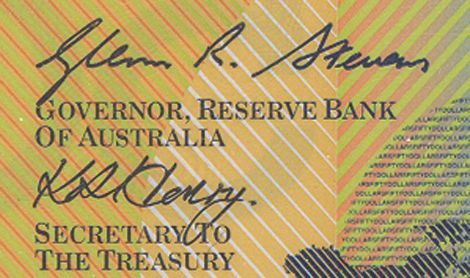
50 dollars (US$42.35), (20)09. Like P60, but new date.
Courtesy of Kai Hwong.
Honduras new date (17.04.2008) 500-lempira note confirmed

500 lempiras (US$26.46), 17 DE ABRIL DE 2008. Like P96, but new date and signatures:
PRESIDENTE - Edwin Araque Bonilla
GERENTE - Jorge Oviedo Imboten
SECRETARIA DE FINANZAS - Rebeca P.Santos
Courtesy of Jean-Michel Engels.
IACA Excellence in Currency Awards announced
A new family of banknotes from Scotland’s Clydesdale Bank was one of the outstanding winners at the International Association of Currency Affairs’ (IACA) Excellence in Currency Awards, sponsored by ‘Currency News’.
A high calibre of entries and some very close voting in several categories marked this year’s awards - the third event – the presentation of which took place during the gala dinner on May 12 at the Currency Conference in Buenos Aires, Argentina.
The 2010 awards saw the Lifetime Achievement Award go to Roland Tornare, the recently retired director of the Issue Department at the Swiss national Bank (1985 – 2007). His extensive experience in the field of banknote design and involvement in creating the current Swiss banknote series were cited by Currency Conference chairman Richard Haycock, who presented the awards.
Clydesdale Bank won the hotly-contested Best New Banknote Series Award for its family of banknotes celebrating the best of Scotland’s heritage, people and culture. The front of each note honours a prominent and innovative Scot while the reverse features one of Scotland’s five World Heritage Sites. The bank designed the new notes to ensure that everyone, including the visually impaired, could use the notes with confidence, while the use of vibrant colours, different sizes, bold fonts, and raised bars to assist in note denomination has been appreciated by the Royal Blind, a foundation devoted to the welfare of blind people.
Category runners up were the Central Bank of Armenia for its 100,000 Dram banknote and the Central Bank of the Republic of Turkey for a new series which completed the country’s currency reform started in 2005.
Clydesdale’s year-long media communications initiative from the launch of the initial designs right through to the introduction of the notes into circulation earned it the Best Currency Public Education Program. The move ensured its new notes were welcomed by consumers and readily accepted by retailers.
The National Bank of Denmark and the Central Bank of the Republic of Turkey were category runners-up.
The Best New Coin Series Award went to the Royal Canadian Mint for The Vancouver 2010 Winter Olympic Circulation Collection. In the run up to the Olympics, the Royal Canadian Mint released 12 Vancouver 2010 circulation quarters (25 cents) plus two lucky loonies ($1 coins) - each individual quarter represented a different Olympic Winter sport.
Runner up awards went to two new circulation coin series, issued by the Central Bank of the Republic of Turkey and the Reserve Bank of Fiji respectively.
Pixel Watermark, a development of Arjowiggins Security which appeared in the Bank of Mexico’s 200 Peso note commemorating the country’s bicentennial, won the award for the Best New Currency Feature. Printed on paper in a vertical design format and including a multi-tonal watermark in the form of an angel, the wing of which was created with a Pixel™ Watermark, this was the first time such a feature had appeared on a banknote.
De La Rue’s Depth Image and Magic Varifeye® (from Louisenthal) were the competitors who both received runner up awards. Voting results were very close in this category.
For the first time ever there was a tied result for the Best Currency Website. IACA members voted equally for the European Central Bank and the Central Bank of Chile for the detailed currency information found on their respective websites.
While the two sites are very different in their approach and perhaps the resources available for website development, both use video and interactive notes to help their public understand the design and security features preset. The Monetary Authority of Singapore was a close runner up.
Speaking at the awards, Richard Haycock said: “I would like to congratulate all this year’s winners and runners-up for their outstanding contribution to the currency industry.
“All have demonstrated the highest standards of technical expertise and innovation to deliver practical, eye-catching and cost effective currency products, which we as an industry can be proud of.
“This year’s ceremony has been an unequivocal success and I very much look forward to the continuing high standards being recognised at the next awards, which will undoubtedly be even bigger and better.”
The IACA awards were launched in 2007 to promote and recognise excellence in currency production, processing, management and distribution. They are open to any organisation or individual supplying products, services or systems for currency production or management. The IACA awards committee draws up a shortlist of three nominations in each category, and IACA members vote for the winners.
Nominations for the fourth IACA Awards will commence shortly via www.currencyaffairs.org. They will be presented at the next Currency Conference, which will take place in October 2011 in Singapore.
Gibraltar scans needed for catalog
I am looking for 300-dpi images of the following banknotes of Gibraltar:
Pick 1-5, 7-11 all date varieties
P16 dated 1st June 1942 and 1st December 1949
P17 dated 3rd October 1958 with W&S imprint
P19 dated 3rd October 1958 with TDLR imprint
P19 dated 1st May 1965 with Title: Financial and Development Secretary
specimens
As a contributor, you will receive the satisfaction of taking part in creating something of excellence, your note will be immortalized as the plate note for the catalog, plus your name will appear in the Acknowledgements along with your email address or URL, if you wish.
Thanks in advance for everyone's cooperation!
New edition of Standard Catalog of World Paper Money now shipping

The 16th edition of Krause’s Standard Catalog of World Paper Money is now shipping. I just received my copy and wanted to share my initial impressions.
At 1,112 black and white pages, it's exactly as large as the previous edition, though its list price is now $60 instead of $55, and it does not come with a disc containing a PDF version of the catalog, which is a great disappointment.
Also somewhat disappointing is that values for VG conditions have been eliminated. Now only VF and UNC conditions are listed. While some will decry this change, I think it’s a reasonable change because most modern notes collectors insist on UNC anyway.
More troublesome is that this edition continues the trend of covering only a fraction of the new note types and varieties that have been issued in the past years, and illustrating almost none of them. It appears that the cut-off for inclusion in this catalog was mid-2009, but many, many notes issued well before then failed to make it into print (The Banknote Update contains over 80 pages of images and info missing from the 16th edition of the SCWPM).
In an attempt to appear more current than it really is, the catalog has assigned Pick numbers to a lot of "expected issues." The problem with this practice is that many such notes are never released, inevitably forcing the editors to renumber at a future date, much to the frustration of collectors and dealers everywhere (my cursory examination uncovered a half dozen notes that have been renumbered or deleted between editions). Furthermore, the information (such as dates) in the listings for these expected issues often proves wrong, adding to the general confusion.
Speaking of frustrating and confusing, some listings refer to non-existent signature charts, or the signature chart exists, but hasn’t been updated to include the latest signatures, making it impossible to distinguish between varieties.
I haven't done a thorough check of the entire catalog, but a spot check revealed some obvious pricing problems, such as listing Armenia's 100,000-dram note at $250 in UNC, even though its face value is $263. The 50,000-won from South Korea, featured on the cover of the new edition, is worth $40 at face, but is listed at $50 in UNC. Good luck finding dealers selling notes with negative or nominal mark-ups.
Like it or not, the SCWPM remains "the bible" for our hobby because its Pick numbers are almost universally used to identify notes. If you intend to get a copy despite its flaws, please support this site by buying the latest edition using this link.
Documentary on Reserve Bank of Australia's bribery scandal
Courtesy of Kai Hwong.
Norway new date (2008) 50-krone note confirmed
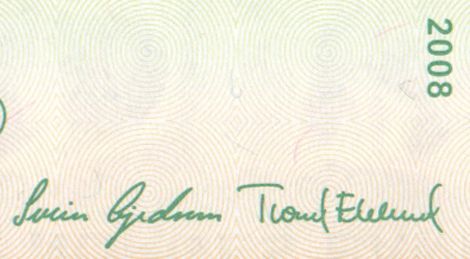
50 kroner (US$7.75), 2008. Like P46, but new date.
Courtesy of Håkon Hagelund.
Egypt new date (04.05.2009) 10-pound note confirmed
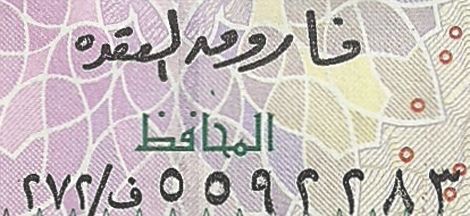
10 pounds (US$1.77), 04.05.2009. Like P64, but new date.
Courtesy of Christoph Thomas.
Egypt new date (17.07.2008) 5-pound note confirmed
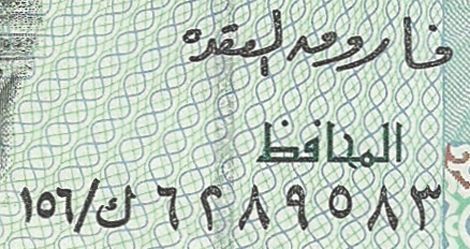
5 pounds (US$0.90), 17.07.2008. Like P63, but new date.
Courtesy of Christoph Thomas.
Denmark new date (2008) 100-kroner note confirmed

100 kroner (US$16.90), (20)08. Like Pick 61, but new date and new signatures.
Courtesy of Kai Hwong.
Paraguay new 10,000-guaraní note (B848a) confirmed


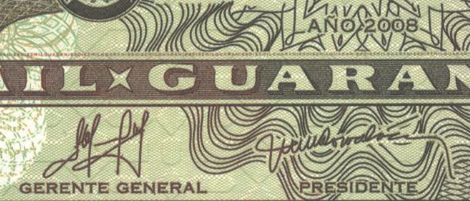
10,000 guaranies (US$2.10), 2008. Like P224, but new date, new signatures, wider windowed security thread, denomination added to upper right corner on front, and new printer imprint (OBERTHUR TECHNOLOGIES).
Courtesy of Claudio Marana.
Costa Rica new date (26.09.2007) 10,000-colon note (B551e) confirmed
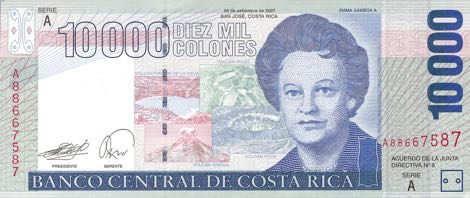

Like B551d, but new date (26 de setiembre de 2007) and “Acuerdo de la Junta Directiva N° 8” (instead of N° 7).
Courtesy of Alberto Fochi.
Zambia new date (2009) 500-kwacha note (B145g) confirmed
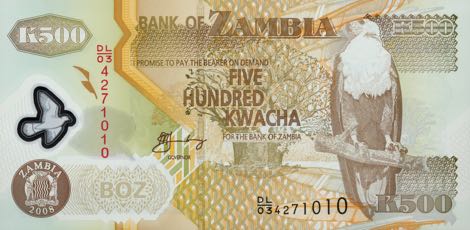
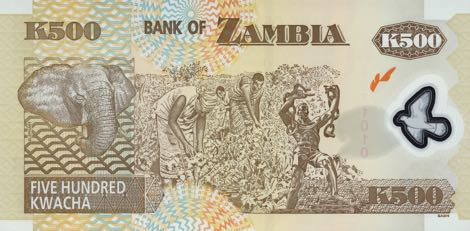
Like B145f, but new date (2009).
Courtesy of Sejin Ahn.
Jersey new note family confirmed
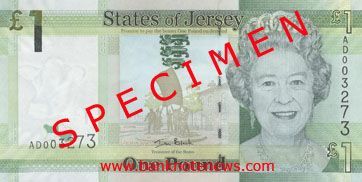
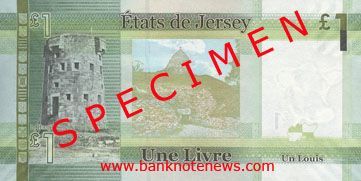
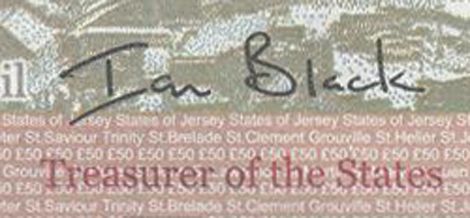
B28 (PNL): 1 pound (US$1.70)
Green. Front: Monument to Freedom in Liberation Square, Saint Helier; QE II. Back: La Hougue Bie Neolithic burial mound; Le Hocq in Saint Clement. Windowed security thread. Watermark: Jersey cow head, electrotype 1, and Cornerstones. Printer: DE LA RUE. 130 x 65 mm. No date. Signature 6. Intro: 29.04.2010.
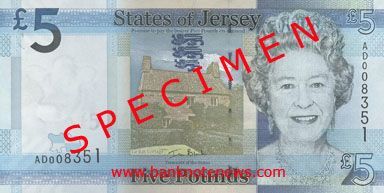
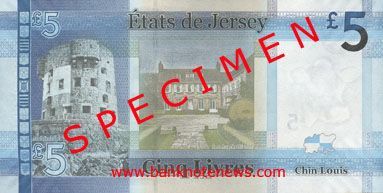
B29 (PNL): 5 pounds (US$8.40)
Blue. Front: 16th century National Trust property, Le Rât Cottage, in Saint Lawrence; QE II. Back: Les Augrès Manor, home of the Durrell Wildlife Conservation Trust; Archirondel Tower. Windowed security thread. Watermark: Jersey cow head, electrotype 5, and Cornerstones. Printer: DE LA RUE. 135 x 70 mm. No date. Signature 6. Intro: 29.04.2010.
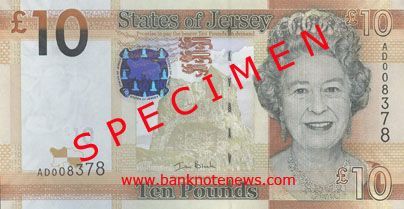

B30 (PNL): 10 pounds (US$16.80)
Burnt sienna. Front: Hologram; Hermitage of Elizabeth Castle in Saint Aubin’s Bay; QE II. Back: Rene Lalique’s glass sculptures in Saint Matthew’s Church of Saint Lawrence; Seymour Tower in Grouville Bay. Windowed security thread. Watermark: Jersey cow head, electrotype 10, and Cornerstones. Printer: DE LA RUE. 145 x 75 mm. No date. Signature 6. Intro: 29.04.2010.

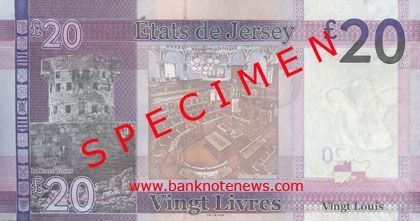
B31 (PNL): 20 pounds (US$33.55)
Violet. Front: Hologram; exterior view of The States (parliament building); QE II. Back: Interior view of The States chamber; La Rocco Tower (originally known as Gordon’s Tower) in Saint Jean. Windowed security thread. Watermark: Jersey cow head, electrotype 20, and Cornerstones. Printer: DE LA RUE. 150 x 80 mm. No date. Signature 6. Intro: 29.04.2010.
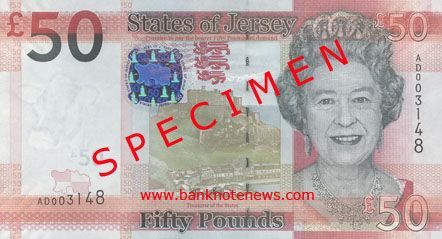

B32 (PNL): 50 pounds (US$83.90)
Cherry red. Front: Hologram; Mont Orgueil Castle; QE II. Back: Houses on the island of La Marmotière in Les Écréhous; Ouaisné Tower. Windowed security thread. Watermark: Jersey cow head, electrotype 50, and Cornerstones. Printer: DE LA RUE. 155 x 85 mm. No date. Signature 6. Intro: 29.04.2010.
All of these notes have also been confirmed as specimens with diagonal red SPECIMEN overprints.
Courtesy of Dieter Eheim.
Papua New Guinea new date (2009) 5-kina note confirmed
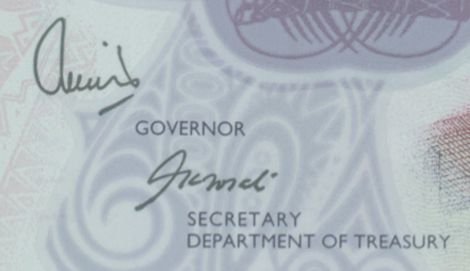
5 kina (US$1.80), (20)09. Like Pick 29, but new date.
Courtesy of Leszek Porowski.
Uganda new note family confirmed


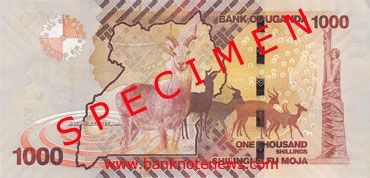
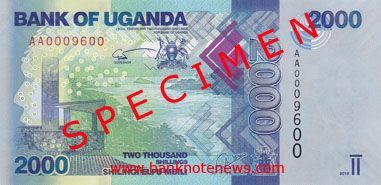
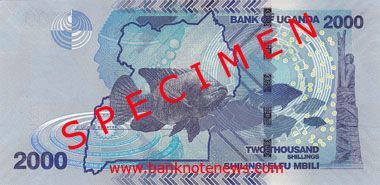
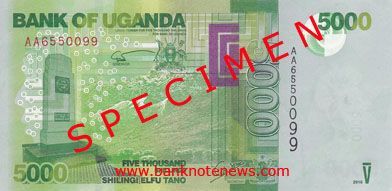
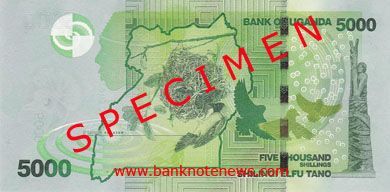
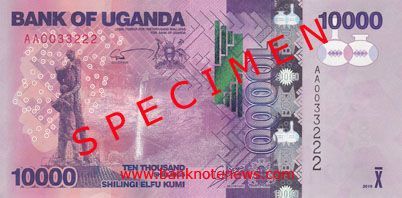

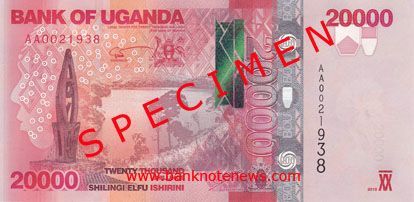
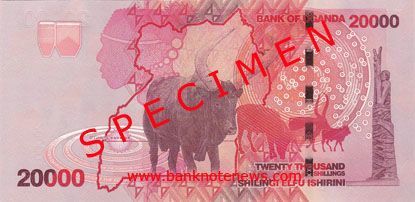
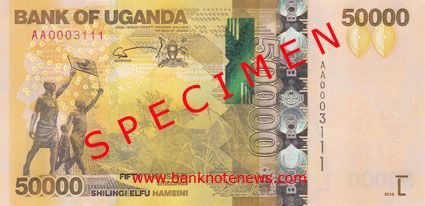
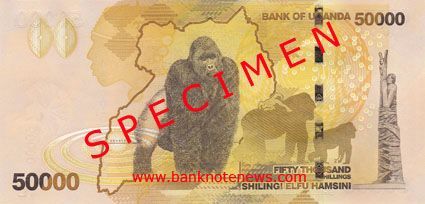
On 3 May 2010, Bank of Uganda unveiled a new series of redesigned and smaller banknotes which will go into circulation on 17 May. The new notes are in the existing denominations of 1,000, 5,000, 10,000, and 50,000 shillings, as well as a new denomination: 2,000 shillings (US$0.95).
Besides a harmonized banknote design that depict Uganda’s rich historical, natural and cultural heritage, the new notes bear improved security features and are smaller in size than the existing series which will remain legal tender. The common security features for the 1,000-, 2,000-, and 5,000-shilling notes are a watermark, a color-change image, and a raised effect on the surface to help the visually-impaired people differentiate denominations. The notes also feature a windowed thread that changes from red to green when the note is titled. The notes also bear a hidden irridescent pattern.
The bank hired professional artists and designers led by Gen. Elly Tumwine which explains the Ugandan look as depicted by the main images which constitute pots and ornaments common in Ugandan homes. The notes were printed by De La Rue, the world’s largest commercial security printer.
Bank of Uganda chief Emmanuel Tumusiime Mutebile said the new notes did not constitute a currency reform, nor were they dictated by politics. The redesign, he said, was driven by the need to comply with international practices and to beat counterfeiters. “Uganda is the first country in Africa to introduce ultra –modern security feature called SPARK,” an optical security feature from KBA-GIORI first used on Kazakhstan’s 5,000-tengé commemorative of 2008.
Courtesy of Ny Andry Ranaivosolo and Tuyet Nhung- Dieter Eheim Le.
Thailand new 100-baht commemorative confirmed
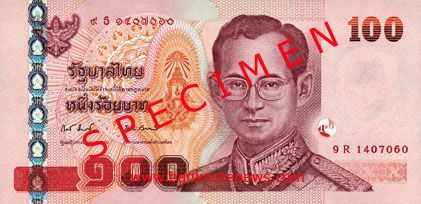
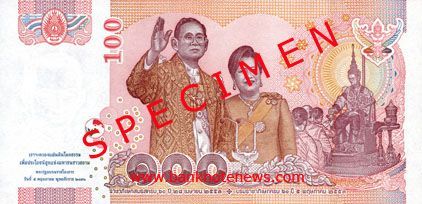

On 4 May 2010, Bank of Thailand issued a new 100-baht (US$3.10) note to mark the king’s 60th wedding anniversary. The note is the same as the current 100 baht (P114) but the back features the king & queen standing together. Apparently 9,999,999 notes were printed. A specimen without overprint and with all-zero serial numbers and a specimen number at lower right back has also been confirmed.
Courtesy of Sanjay Basu, Vincent Tan, Rafal Nogowczyk, Claudio Marana, and Jean-Michel Engels.
Somalia new notes reported
Costa Rica new date (14.09.2005) 1,000-colon note (B546f) confirmed
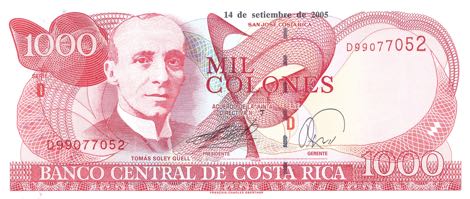

Like B546e, but new date (14 de setiembre de 2005).
Courtesy of Alberto Fochi.
Tonga new date (05.07.1985) 20-pa'anga note confirmed
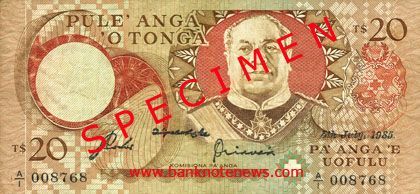

20 pa’anga (US$10.15), 5th July, 1985. Like Pike 23, but new date.
Courtesy of TDS.
Uganda new date (2009) 5,000-shilling note confirmed


5,000 shllings (US$2.30), 2009. Like Pick 44, but new date and new signatures (Emmanuel Tumusiime Mutebile and Chris Manyindo Kassami).
Courtesy of Bill Stubkjaer.
Hungary new 2,000-forint note (B583) confirmed

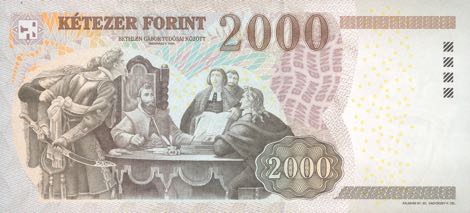
Like B574, but new date, new signatures, and Omron rings.
Courtesy of Bill Stubkjaer.
Nigeria new dates (2009 & 2010) 1,000-naira note confirmed


1,000 naira (US6.60), 2009. Like Pick 36, but new date and new signatures (Lamido Aminu Sanusi and Benjamin C. Onyido).
1,000 naira (US6.60), 2010. Like Pick 36, but new date and new signatures (Lamido Aminu Sanusi and Benjamin C. Onyido).
Courtesy of Arigo Avbovbo.
Nigeria new date (2010) 100-naira note confirmed
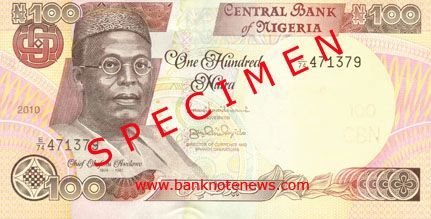
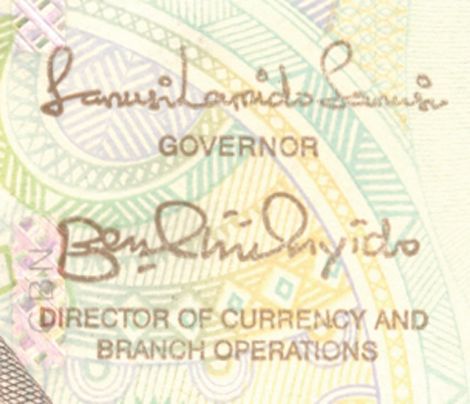
100 naira (US$0.65), 2010. Like Pick 28, but new date and new signatures (Lamido Aminu Sanusi and Benjamin C. Onyido).
Courtesy of Arigo Avbovbo.
Nigeria new date (2010) 50-naira note confirmed


50 naira (US$0.35), 2010. Like unlisted 50-naira note, but new date and new signatures (Lamido Aminu Sanusi and Benjamin C. Onyido).
Courtesy of Arigo Avbovbo.
Nigeria new date (2010) 20-naira note confirmed
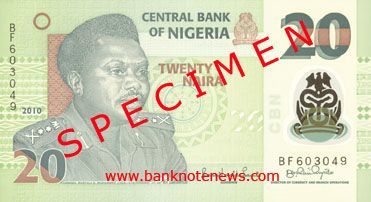

20 naira (US$0.15), 2010. Like Pick 34, but new date and new signatures (Lamido Aminu Sanusi and Benjamin C. Onyido).
Courtesy of Arigo Avbovbo.
Kenya new date (17.06.2009) shilling notes confirmed
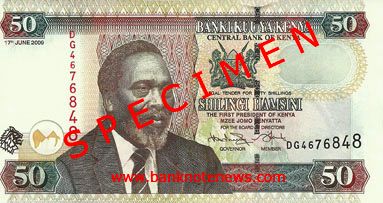

50 shillings (US$0.65), 17th JUNE 2009. Like Pick 41, but new date.

100 shillings (US$1.25), 17th JUNE 2009. Like Pick 42, but new date.
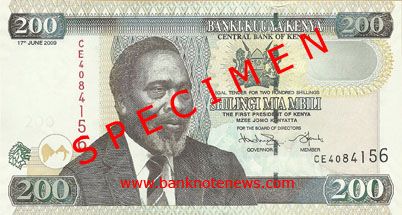
200 shillings (US$2.55), 17th JUNE 2009. Like Pick 43, but new date.

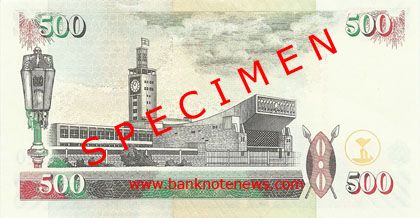
500 shillings (US$6.40), 17th JUNE 2009. Like Pick 44, but new date.
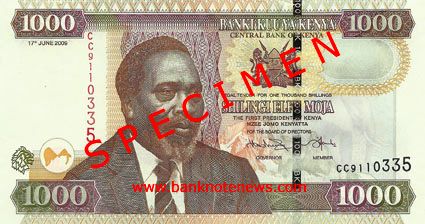
1,000 shillings ($12.80), 17th JUNE 2009. Like Pick 45, but new date.
Courtesy of John Silver.
Nigeria new date (2010) 200-naira note confirmed

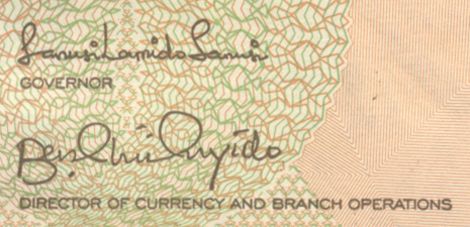
200 naira (US$1.32), 2010. Like Pick 29, but new date and new signatures (Lamido Aminu Sanusi and Benjamin C. Onyido).
Courtesy of Arigo Avbovbo.
Zambia unissued 1,000-kwacha proof dated 1992 confirmed
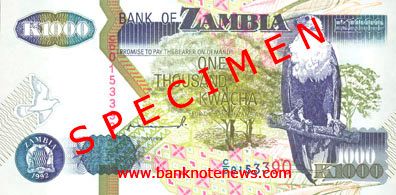

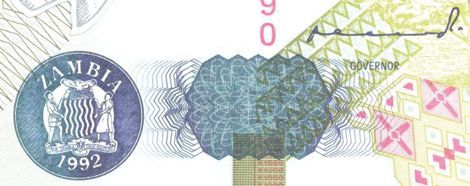
1,000 kwacha, 1992. Like Pick 40, but signature 10, blue in color, and design consistent with lower denominations dated 1992. This unissued note is uniface, with only a handwritten date of 24/08/93 on back.
Courtesy of Nazir Rahemtulla.
Barbados new 100-dollar note dated 1 May 2007 confirmed
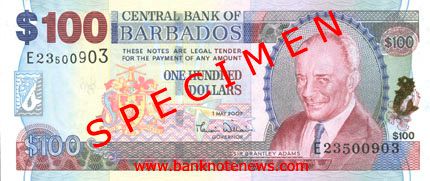
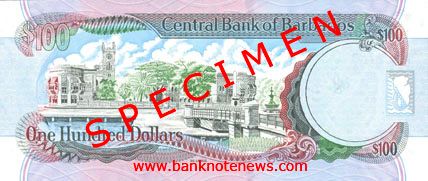
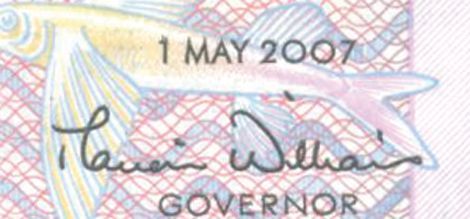
On 25 March 2009, the Central Bank of Barbados announced its plans to introduce a new 100-dollar note (US$50) with upgraded security features on 20 April 2009. "With the introduction of this $100 note we are completing the upgrades process that we began in 2007," explained Julia Weekes, director of banking, currency and investments at the CBB. "These features are intended to make the note more secure and are similar to those currently found in the $20 and $50 notes," she said.
Upgraded security features are:
• A small watermark-type image of the Pride of Barbados flower has been added to the right of the map of Barbados watermark.
• The windowed security thread is now wider and less reflective than the previous thread, and is demetalized CBB$100. Under UV light, the thread fluoresces blue and the text fluoresces yellow.
• The $100 numeral on the top left corner of the note is significantly raised above the surface of the paper, giving the paper a unique feel. This raised numeral will also allow the denomination to be more easily identified by the visually impaired.
• The coat of arms and the waves near the flying fish in the centre of the banknote fluoresce green and yellow under UV light.
In addition to the changes, several of the existing security features, including the highly reflective gold foil dolphin, can still be found on the upgraded $100 note.
Weekes revealed that the upgraded note will be in simultaneous circulation with older issues of the $100 note. “Both the new note and those we have issued previously will be legal tender and completely acceptable as payment for goods and services,” she stated.
Courtesy of Nazir Rahemtulla.
Iceland new signature 1,000-króna notes (B811n, B811p) confirmed
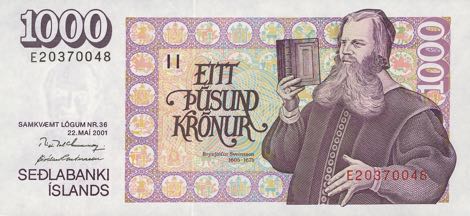
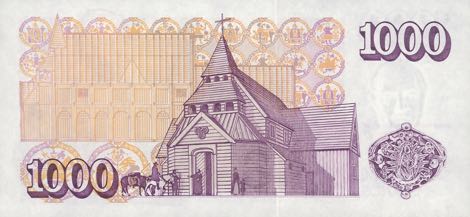
Like B811m, but new date and new signatures.

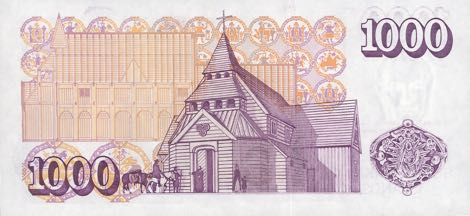
Like B811p, but new date and new signatures.
Courtesy of Werner Kober.
Denmark new 100-krone note confirmed

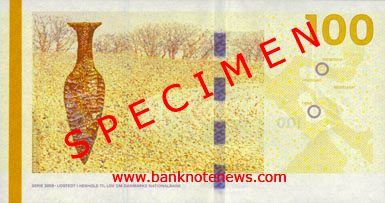
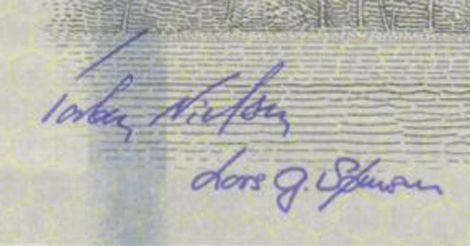
According to Danmarks Nationalbank, the 100-krone (US$17.70) note issued on 4 May 2010 depicts The Old Little Belt Bridge on front and The Hindsgavl Dagger on back. This signature pair is of Torben Nielsen, Governor and Lars Gerrild Sørensen, Head of Banking Services.
The following signature combo has also been confirmed for Nils Bernstein, Governor; and Lars Gerrild Sørensen, Head of Banking Services:

The Old Little Belt Bridge
The Old Little Belt Bridge, linking Erritsø in Jutland to Middelfart on Funen, was opened in 1935. The bridge was originally planned as a railway bridge in 1924, but the decision was later made to include roadways. The bridge is 1,178 metres long and has a maximum vertical clearance of 33 metres.
The Hindsgavl Dagger
The finest example of a flint-knapped dagger is the 29.5 cm long flint dagger that was found in about 1867 on the island of Fænø in the Little Belt opposite the Hindsgavl peninsula. This type of dagger is called the 'fish-tail design' due to the shape of the handle. The Stone Age dagger is from the latter part of the Dagger Period, 1900-1700 BC, and resembles metal daggers that have handles topped with an oval disk. The exquisite flint knapping shows the lengths to which the flint knappers went to compete with the increasingly popular metal goods that ultimately put the craft of flint knapping out of business.
View an informative video.
Courtesy of Rui Manuel Palhares and Bill Stubkjaer.
Philippines new date (2008 A) 500-peso note confirmed

500 pesos (US$10.95), 2008 A. Like P196, but new date.
Courtesy of Nazir Rahemtulla.
Switzerland new date (2006) 50-franc note confirmed

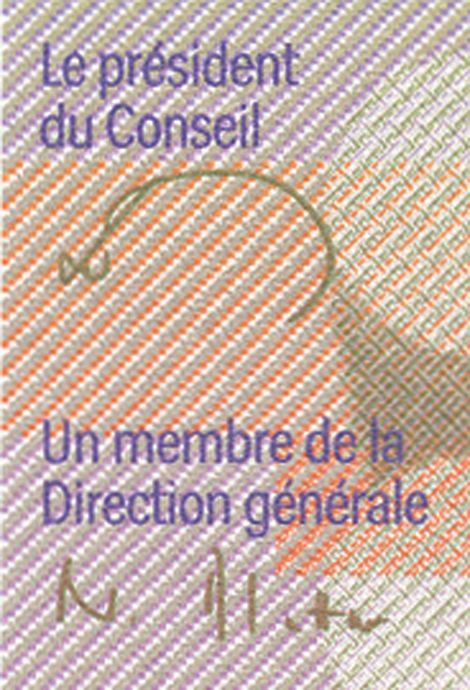
50 francs (US$45.10), (20)06. Like P71, but new date and signature 76 (Raggenbass and Blattner).
Courtesy of Christof Zellweger.
Zambia new date (2009) 10,000-kwacha note (B151b) confirmed

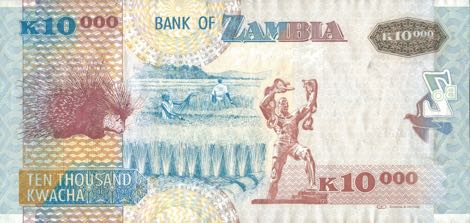
Like B148, but new date (2009), and instead of a holographic patch in the shape of a fish eagle head, an entire fish eagle is represented in a bright silver demetalized holographic LEAD (longlasting economical anticopy device) at left center on the front. Furthermore, the denomination at top right on the back is printed in copper-to-green OVI.
Courtesy of Manjunath P. Iyer.
Bahamas to issue new 10-dollar note
The Government of The Bahamas wishes to advise the public that an updated series of $10 banknotes will be issued by the Central Bank bearing the image of Sir Stafford Sands, former Minister of Finance of The Bahamas and a principal architect of the modern Bahamian economy.
Sir Stafford’s image was first placed on the banknote on March 7th, 2000, when the series 2000 banknotes were released into circulation, replacing the image of Her Majesty Queen Elizabeth II. In 2005 the government of the day determined to remove the image of Sir Stafford and to replace it with the image of Her Majesty the Queen.
Shortly after coming to office in 2007 the Government took the decision that when the 2005 series of banknotes bearing the image of the Queen expired the new series of $10 banknotes would again bear the image of Sir Stafford Sands. Now, given the expiration of the 2005 banknotes, the image of Bahamian Sir Stafford once again returns to the notes.
The Government is pleased to continue this effort of honouring Bahamians who make significant contributions to The Bahamas by placing their images on our local currency, an exercise that began in December 1993 when, for the first time, the portrait of a Bahamian, Sir Milo Butler was placed on the $20 banknote. Thereafter, the portraits of Sir Cecil was placed on the 1995 $5 banknote; Sir Roland on the $50 banknote in 2000 and Sir Lynden on the $1 banknote in 2001.
Norway 1995 test note confirmed
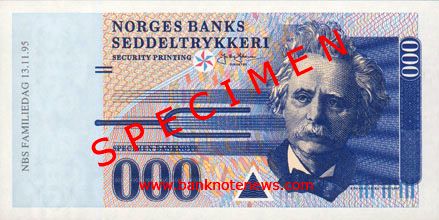
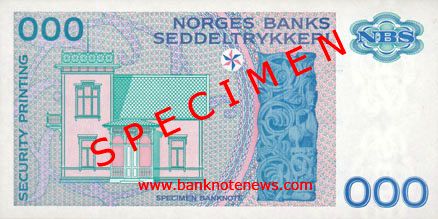
On 13 November 1995, Norges Bank printing works invited all the company’s families to a big Family Day and all the participants got this note as a gift, but it was soon withdrawn and destroyed because it was too similar to a real note. Everybody was asked to return them, but of course, some didn’t. Many notes were destroyed, and only a few survived. This is one of them. The watermark is NBS (same as NBS on the top right corner on the back) and it has a lot of other security details. Examine the pictures.
Courtesy of Håkon Hagelund.
Dominican Republic new 50-peso oro confirmed

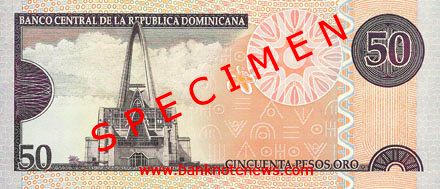

50 pesos oro (US$1.35), 2008. Front and back main vignettes like Pick 176, but decorative elements have changed substantially, and new date. This note is printed by DE LA RUE with imprint and is not to be confused with P176b also dated 2008 but printed by OBERTHUR TECHNOLOGIES (see below).
This new note has also been confirmed as a specimen with diagonal black ESPECIMEN / MUESTRA SIN VALOR overprint.
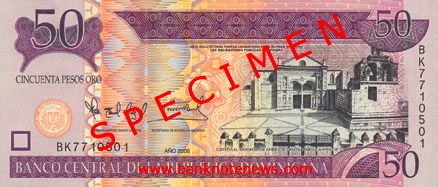
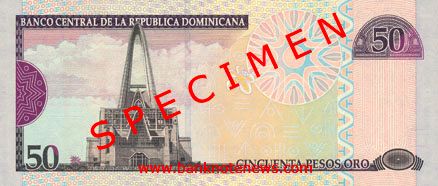
Courtesy of Jean-MIchel Engels and Bill Stubkjaer.
Ethiopia new date (2008) 10-birr note confirmed
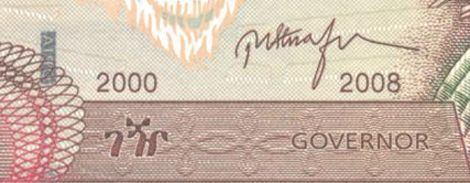
10 birr (US$0.75), 2000/2008. Like Pick 48, but new date.
Courtesy of Nazir Rahemtulla.
Jersey issues new note family
The following is from a 29 April 2010 press release issued by the States of Jersey:
Jersey’s new bank notes are being issued today (29 April 2010) by local banks and States cashiers. The Island’s first new designs for more than 20 years were officially launched in February. They have been tested in banks’ cash machines and commercial vending machines and are now ready to be introduced into circulation.
The new notes will be issued to banks, as they are needed, initially for a period of up to 8 weeks. At the end of that time there will be more than £20 million of the new notes in circulation, in place of existing notes. The existing Jersey bank notes are still legal tender and will remain in circulation until each note reaches the end of its useful life and is withdrawn in the usual way.
States cashiers will begin to issue Collectors’ Notes from today at Cyril Le Marquand House.
The designs incorporate new security features and the back of each note carries the words États de Jersey as well as each of the 12 parish crests. Other important changes include the use of French and Jèrriais and a new image of the Queen.
The Treasury Minister, Senator Philip Ozouf said, "I have received very many positive comments from islanders since the launch of the new notes in February. They are designed to reflect the Island’s history and culture and I was especially pleased that, for the first time, the value of each note is written in Jèrriais as well as in French.
“I hope this will contribute to the ongoing efforts to regenerate the Jersey-French language. I would like to see all States members counting up to 50 in Jèrriais!”
The Jèrriais Language Officer, Tony Scott Warren, is pleased that Jersey’s traditional language is getting a boost. He said “Lé louis dans vot' paûte est achteu pus vâliabl'ye viyant qu' la valeu d'la langue jèrriaise y'a 'té ajouôté.” (The pound in your pocket is now worth more because the value of the Jersey language has been added to it!)
Senator Ozouf added "We must also remember that when we issue Jersey notes, banks pay the States for that cash, those payments are invested and generate interest for the Island. So when we use our notes, we are helping to pay for essential services, like Health and Education.”
Display towers with more information about the new notes and their design are currently on display at the airport, Cyril Le Marquand House and the Co-op (Grand Marché, St Helier). In the coming months they will also be on view at Fort Regent, banks, retail outlets and schools.
The issuing of a £100 note will be considered next year.
Courtesy of Zeeshan Ali.
Costa Rica unveils new note designs

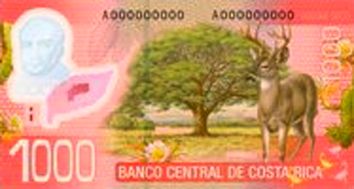
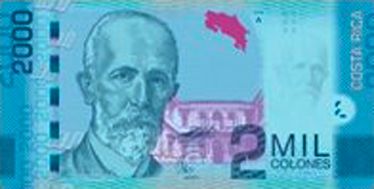
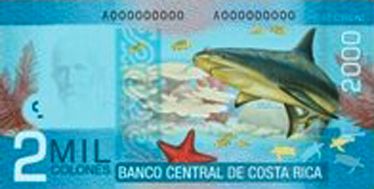
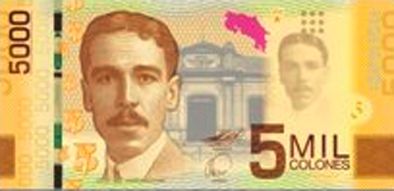
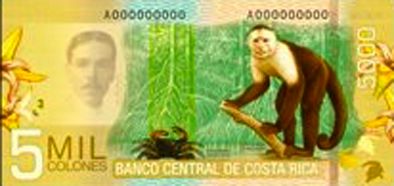


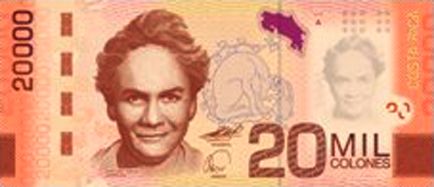
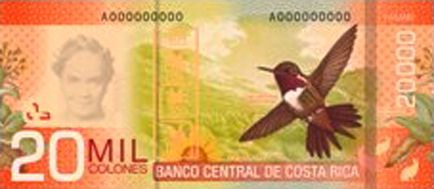

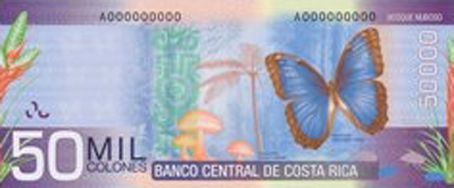
On 27 April 2010, Banco Central de Costa Rica unveiled a new family of banknotes that will replace the existing issues. The first denomination to be issued (possibly by August 2010) will be the 20,000 colones (US$39.10) depicting writer Carmen Lyra. This will be followed by the 2,000 colones in September or October, with the remaining denominations to come by year’s end, except for the 50,000 colones.
The front of each note depicts a portrait of a famous Costa Rican, and the back features flora and fauna from the six ecosystems that exist in the country. The notes are printed by Oberthur Technologies, and it appears all but the 1,000-colon denomination are protected by Crane’s windowed security thread, Motion. From the looks of it, the lowest denomination note may be printed on polymer.
Courtesy of Alex Zlotin.
Iraq new date (2008) 25,000-dinar note confirmed
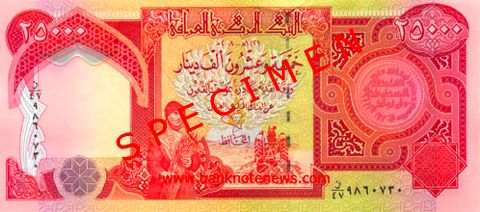

25,000 dinars (US$21.40), ٢٠٠٨ - ١٤٢٩ (2008/AH1429). Like Pick 96, but new date.
Courtesy of banknoteshop@gmx.net.
Chile new 10,000-peso note (B299) confirmed
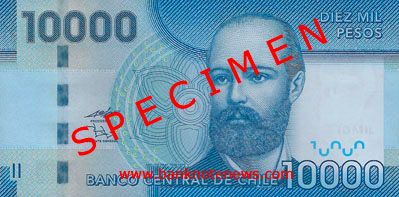
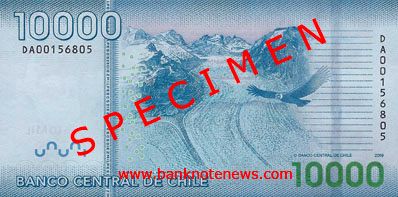

10,000-peso (US$19.70), 2009. Intro: 3 March 2010.
Light blue. Front: Stylized corazón del copihue (heart of Chilean bellflower); navy officer Arturo Prat. Back: Andean condor bird soaring above the Cordillera Darwin mountain range and ice fields in Parque Nacional Alberto de Agostini (Alberto de Agostini National Park) located in the Magdalena region of Tierra del Fuego. Solid security thread and Motion windowed security thread with Antú (indiginous Mapuche weaving design symbolizing the sun and fertility). Watermark: Arturo Prat and electrotype 10 MIL. Printer: (Crane AB). 141 x 70 mm.
Signature (José De Gregorio Rebeco, PRESIDENTE; Unknown, GERENTE GENERAL).
Courtesy of George Provencal, Cleophas Elmakias Schockemohle, Thomas Krause, Claudio Marana, and Michael Reissner.
Iran new signature 5,000-rial note confirmed

5,000 rials (US$0.50), no date. Like Pick 145, but new signature (Ebrahim Sheibani and Danesh Jafari). Intro: March 2010.
Courtesy of Ali Nasseri.
Dominican Republic new date (2009) 2,000-peso oro note confirmed

2,000 pesos oro (US$54.72), 2009. Like Pick 174, but new date.
Courtesy of Alberto Fochi.
Iran new signature 50,000-rial note confirmed
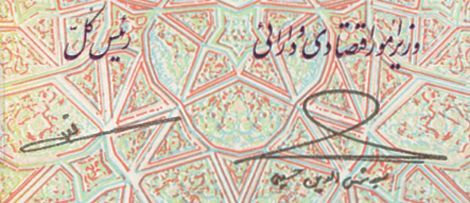
50,000 rials (US$5.05), no date. Like Pick 149, but new signature (Mazaheri and Hosseini). Intro: March 2010.
Courtesy of Ali Nasseri and Aminoroaaya.
Iran new signature 1,000-rial note confirmed
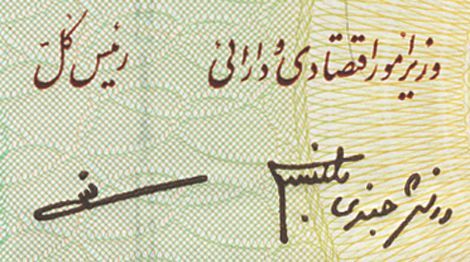
1,000 rials (US$0.10), no date. Like Pick 143, but new signature (Mazaheri and Danesh Jafari). Intro: March 2010.
Courtesy of Ali Nasseri and Aminoroaaya.
South Africa withdrawing older 200-rand notes

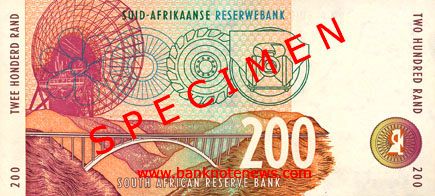
On 21 April 2010, the South African Reserve Bank informed citizens that they had until the end of May to exchange older 200-rand (US$26.94) notes (Pick 127) in an effort to combat counterfeits. These notes have been in circulation since 1994 and lack the enhanced security features of the newer notes introduced in 2005, first with the signature of T. T. Mboweni and now with that of the current governor, Gil Marcus.
Madagascar new 2,000-ariary note confirmed
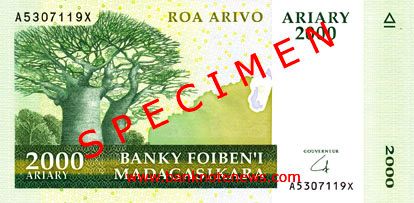
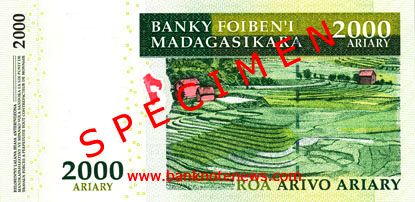
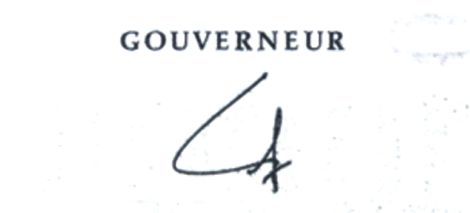
2,000 ariary (US$0.97), no date. Like Pick 90, but new signature and references to franc removed.
The 10,000-ariary note has also been confirmed without reference to franc. If anyone knows when these notes were introduced, or if the other denominations have been issued also without references to franc, please share that info.
Courtesy of Bill Stubkjaer.
Bangladesh new date (2009) 2-taka note confirmed

2 taka (US$0.01), 2009. Like previously reported new 2-taka notes, but new date and new signature (Mohammed Tareq).
Courtesy of Bill Stubkjaer.
Afghanistan new signature varieties confirmed
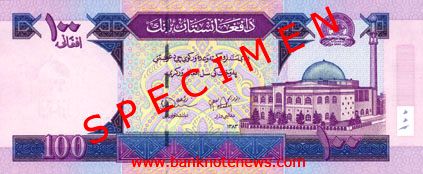
100 afghanis (US$2.11), ١٢٨٢ (SH1383/2004). Like P70, but new signature.

500 afghanis (US$10.58), ١٢٨٢ (SH1383/2004). Like previously reported new type 500-afghani note, but new signature.
Courtesy of Bill Stubkjaer.
Mongolia 20,000-tögrög commemorative specimen (BNP401as) confirmed
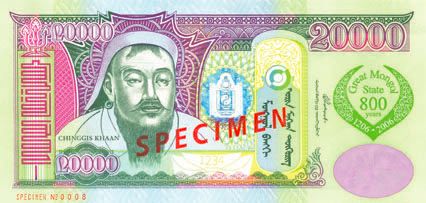
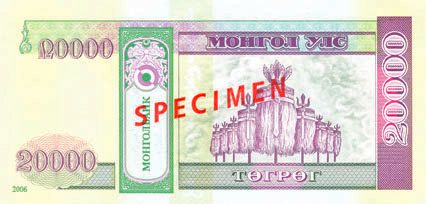
On 2 October 2006 Mongol Bank issued its first ever 20,000-tögrög (US$14.35) note into circulation (B427). A limited number of 20,000-tögrög (US$14.35) notes with the watermark area on front were overprinted Great Mongol State 800 years 1206 - 2006. This commemorative was the first note in the world to use G&D’s LOOK (Laser Originated Optical Key), a security feature that creates laser-induced effects in the substrate, print color, foil, and varnish. In this case, the 4-digit serial number was written using LOOK.
The above specimen example of the overprinted commemorative has surfaced, along with reports that non-specimen notes with the commemorative overprint were available only encased in Lucite. If anyone can provide more information about this commemorative note, please post a comment. I’m particularly interested in determining if the non-specimen version of the overprinted note is available, as well as how many such notes were printed, and if they entered circulation or were sold as numismatic products at a premium to face value.
Courtesy of Eberhard Siegele.
Nepal new signature 100-rupee note confirmed
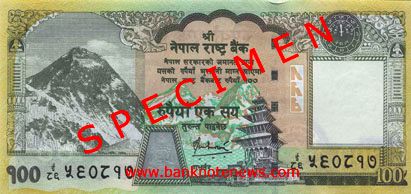
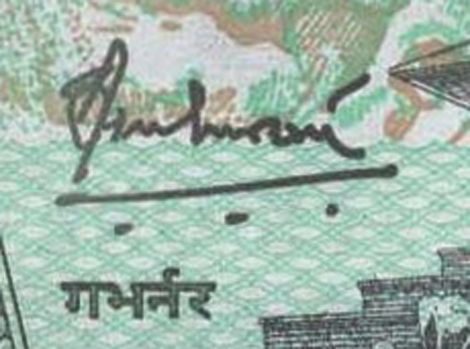
100 rupees (US$1.40), no date. On 16 April 2010 Nepal Rastra Bank issued a new 100-rupee note with usual color and size with prefix number EE/63 000001 to U/86 999999. On front left it has the picture of Mount Everest from south face, on right it has the watermark of Nepal’s national flower Rhododendron. It has the signature of the present Governor Bijay Nath Bhattarai (signature 16).
Courtesy of Shankar Shrestha.
Uruguay new date (2009) 200-peso uruguayo note confirmed
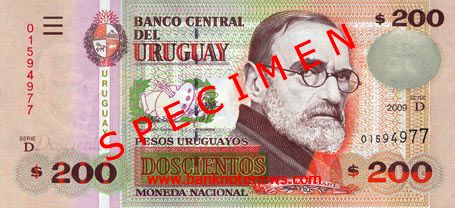
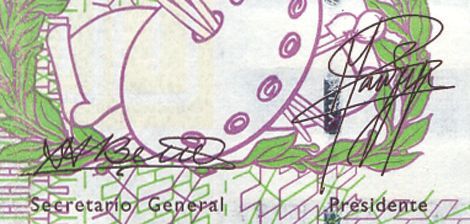
200 pesos uruguayos (US$10.36), 2009. Like Pick 89, but new date, new signatures, series D, and new imprint (OBERTHUR TECHNOLOGIES).
Courtesy of Alberto Fochi.
Vietnam new date (2008) notes confirmed
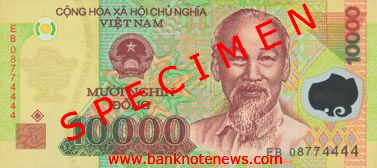
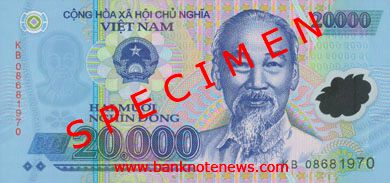
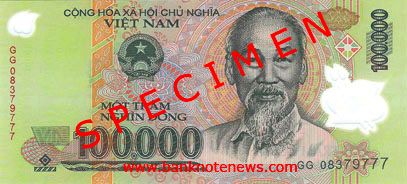

All denominations of notes from Viet Nam have been confirmed dated (20)08, except the 50,000- and 200,000-dong notes.
Courtesy of Ryan Vuong.
Bermuda 2-dollar note named IBNS Banknote of the Year
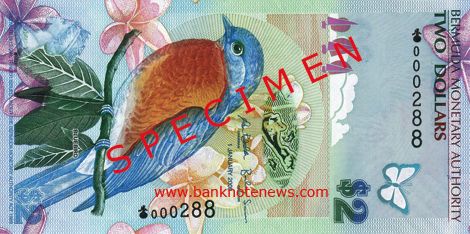
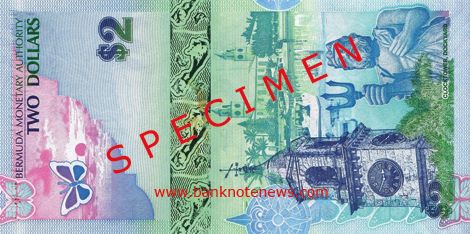
The International Bank Note Society (IBNS) has chosen Bermuda’s $2 note, issued as part of an entirely new series in 2009, as the 2010 Bank Note of the Year. Each year the IBNS recognizes an exceptional banknote issued in the previous year and, from nine very impressive nominations issued in 2009, the Bermuda $2 note was a clear winner.
The award-winning note portrays the Bermuda Bluebird (Sialia sialis) on the front and the Dockyard Clock Tower and Statue of Neptune on the back. As with all notes in the new Bermuda series, the head of HM Queen Elizabeth II appears in a reduced format on the front of the note, the portrait being a mirror of the Machin Head design which appears on the postage stamps of the Royal Mail.
The members of the IBNS Board, who chose the winning note, considered the Bermuda $2 note an example of the most attractive elements which create interest among the ever-widening community of banknote collectors and those who take an interest in the development of paper money. They said the combination of colours were appealing and blended well throughout all components of the design. Additionally, the range of items depicted on the note were attractively presented and allowed the eye to linger and to search for natural and historical design elements which were not immediately apparent.
One of the factors recommending the note to the judges was an interesting array of security features, despite its low face value. These include an Optiks™ embedded metallic thread, with an aperture on the front depicting the island; a Hibiscus watermark on the top section on the front; the Cornerstone™—a watermark feature on the four corners of the note enhancing the durability of the banknote; and, on the back, the Gemini™ feature portraying a compass which fluoresces in two colours under UV light.
Manufactured by De La Rue and released as part of a new series by the Bermuda Monetary Authority in February 2009, the series was the first major re-design of Bermudian banknotes for 40 years. The object of the series was to present depictions of Bermuda, with the series reflecting the natural beauty of the flora and fauna of the island on one side and the island’s architectural heritage on the other.
Working from a detailed brief from the Bermuda Monetary Authority, the initial concept designs for the series were created by Gene Bothwick, one of De La Rue’s long-serving designers, who retired in 2007 after 23 years of service. These concepts were then developed for production by the De La Rue banknote Preliminaries Department with input and guidance from the Monetary Authority.
The IBNS congratulates the Bermuda Monetary Authority and De La Rue on an exceptional banknote.
United States unveils new 100-dollar note

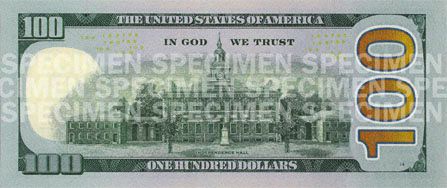
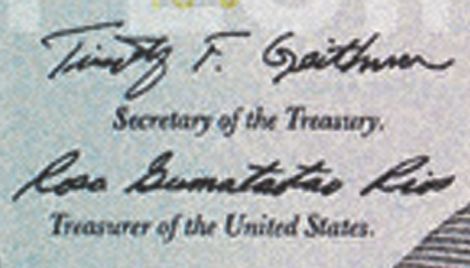
The United States’ long-awaited new 100-dollar banknote was unveiled on 21 April 2010. Like the preceding issues of the denomination, it features Benjamin Franklin on the front and Independence Hall on the back, but is protected by improved anti-counterfeiting features, chief among them is Crane’s windowed Motion thread (which the BEP calls “3-D Security Ribbon”) and a copper-to-green OVI metameric pair patch shaped like an inkwell which reveals the Liberty Bell inside when tilted.. The note also has a solid security thread printed USA 100, a watermark of Franklin, the denomination printed in copper-to-green OVI, intaglio printing, microprinting, and a huge vertical 100 on the back right. The new $100 will begin circulating on 10 February 2011 and will circulate in parallel with older versions of the denomination (all US notes remain legal tender forever). More information can be found on the BEP web site, but due to high traffic on the day of its unveiling, some pages may refuse to load properly.
Cuba new dates (2007 and 2008) 10-peso convertible note confirmed

10 pesos (US$10), 2007 and 2008. Like PFX49, but new dates.
Courtesy of Stein Langørgen.
Cuba new date (2008) 5-peso convertible note (BFX907c) confirmed

Like BFX907b, but new date (2008).
Courtesy of Stein Langørgen.
Cuba new date (2007) 1-peso convertible note (BFX905b) confirmed
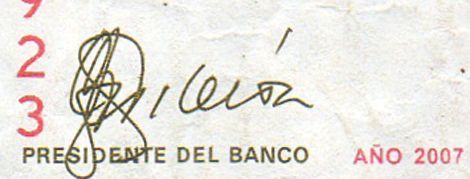
1 peso (US$1), 2007. Like BFX905a, but new date.
Courtesy of Stein Langørgen.
Congo Democratic Republic new printer for 100-franc note confirmed
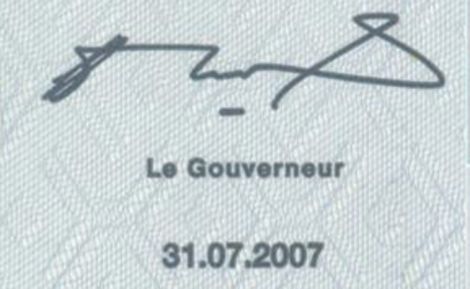
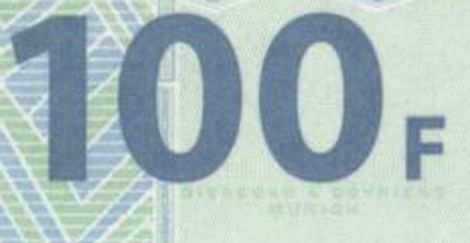
100 francs (US$0.20), 31.07.2007. Like Pick 92, but instead of the bank initials embossed on the silvery round patch on the front, the initials are printed; and the note is lithographed front and back. Furthermore, new date and new printer imprint (GIESECKE & DEVRIENT MUNICH). Imprint is in lower right corner on the back, below the denomination. It’s hard to read without a magnifying glass.
Courtesy of Rui Manuel Palhares.
Suriname new date (01.05.2009) 10-dollar note confirmed
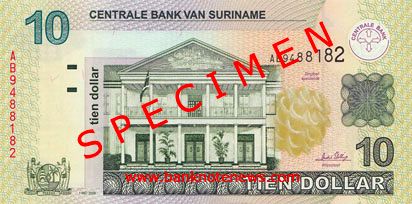
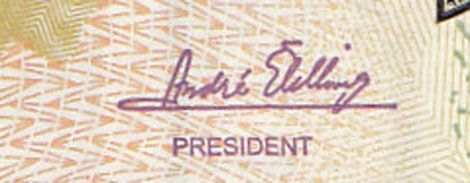
10 dollars (US$3.65), 1 MEI 2009 (01.05.2009). Like P158, but new date and the translucent band has been moved to the back.
If anyone has the 20-, 50-, or 100-dollar denominations in this series with the new date, please send scans of same.
Courtesy of Wonsik Kang.
Congo Democratic Republic new printer for 10-franc note confirmed
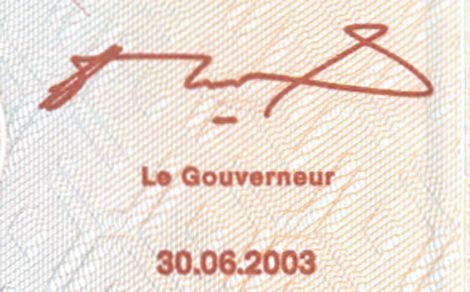
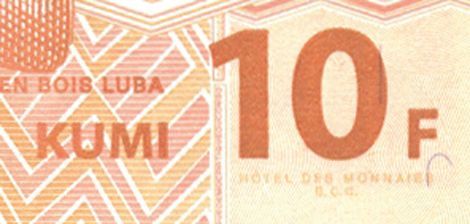
10 francs (US$0.02), 30.06.2003. Like Pick 93, but new printer (HOTEL DES MONNAIES B.C.C.). Imprint is in lower right corner on the back, below the denomination. It’s hard to read without a magnifying glass.
Courtesy of banknoteshop@gmx.net.
Egypt new date (08.06.2009) 100-pound note confirmed

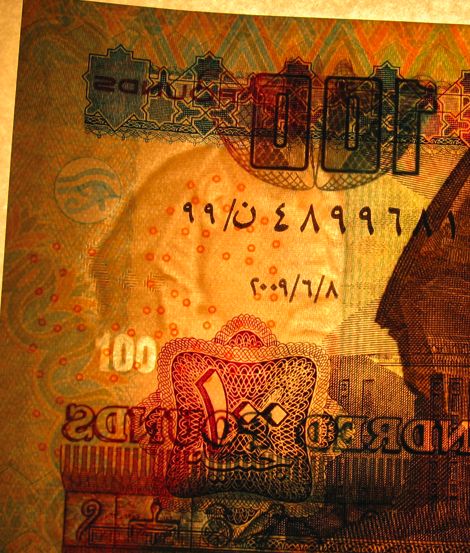
100 pounds (US$17.80). Like P67, but new date (08.06.2009), new signature (El-Okdah), new watermark (Sphinx) and electrotype 100, and new threads and placement of threads. On P67 notes dated earlier than June 2006, the windowed thread has no text and appears near the signature, but on later notes the thread is slightly wider and appears to the left of the minaret in the foreground and has demetalized 100 and ONE HUNDRED POUNDS in Arabic. Both old and new noes also have a solid security thread with demetalized 100 POUNDS in Arabic.
Courtesy of Alberto Fochi.
North Korea new 1,000-won note (B345a) confirmed

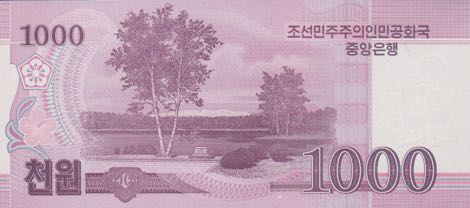
1,000 won, 2008. Pink. Front: Coat of arms; house (birthplace of Kim Jong Suk, Kim Il Sung’s first wife and Kim Jong Il’s mother) in Hoeryong. Back: Birch trees on shore of Lake Samji; mountain. Solid security thread with printed text. Watermark: Mongnan (Seibold’s magnolia) flowers. Printer: Unknown. 145 x 65 mm. Intro: 30.11.2009.
Courtesy of Thomas Augustsson.
Guatemala new 10-quetzal note confirmed
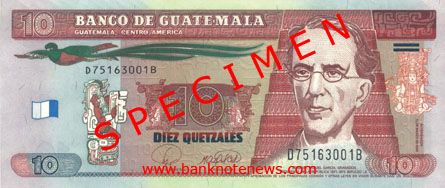
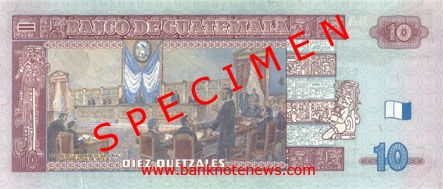

10 quetzales (US$1.25), 12 DE MARZO DE 2008 (12.03.2008). Like Pick 111, but new colors, new date, new signatures, new printer (OBERTHUR TECHNOLOGIES), Guatemalan flag as registration device, new screen trap over entire background, and different serial number placement and fonts. More information (in Spanish) can be found here.
Courtesy of Claudio Marana and Thomas Krause.
Seychelles new signature 25-rupee note confirmed
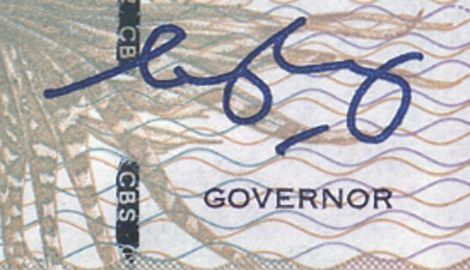
25 rupees (US$2.10), no date. Like Pick 37, but new signature (Francis Chang-Leng).
Courtesy of TDS.
Egypt odd 200-pound replacement note confirmed
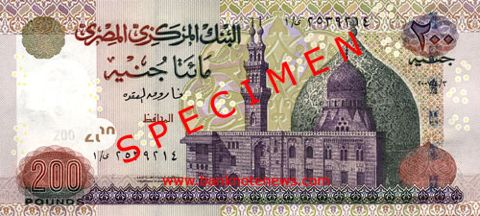
Pick 68a
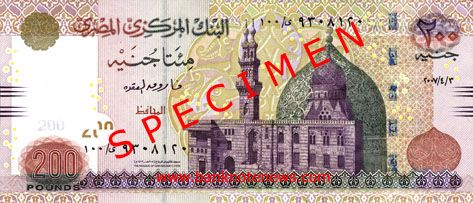
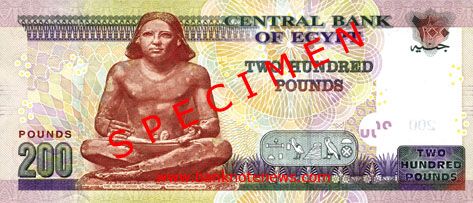
200 pounds (US$37.25), ٢٠٠٧/٤/٣ (2007.04.03). This replacement note (indicated by the prefix which is an even hundred) is like the 200-pound note dated 2009.01.03 in that it too is reduced in size (166 x 72 mm) and has horizontal lines at front edges, but is odd because it bears the date of Pick 68 (see top image), which is a larger note (176 x 78 mm) without the lines.
Courtesy of David F. Cieniewicz.
Iceland new signature 50-króna note (B808c) confirmed
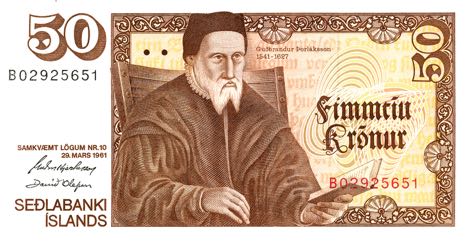
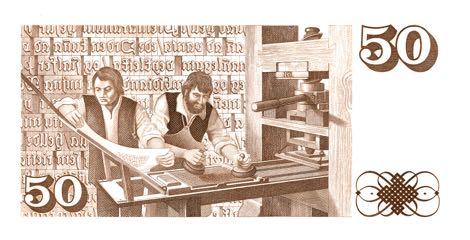
Like B808b, but new signatures of Guðmundur Hjartarson and Davíð Ólafsson (this pair’s signatures are assigned #42 in SCWPM, but these new ones are different enough to warrant a new variety, in my opinion).
Courtesy of George Provencal and Werner Kober.
Philippines new date (2010) 1,000-peso note confirmed
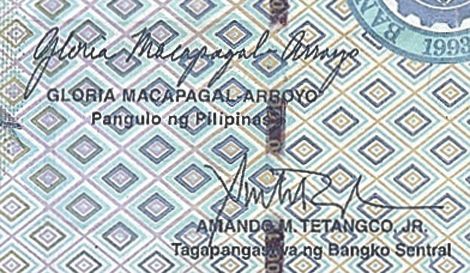
1,000 pesos (US$22.40), 2010. Like Pick 197b, but new date.
Courtesy of Rodney Hall.
Iceland new signature 1,000-króna note (B815c) confirmed


Like B815b, but new signatures (David Oddson and Eirikur Gudnason).
Courtesy of George Provencal and Stefan.
Bangladesh new date (2009) 5-taka note confirmed


5 taka (US$0.07), 2009. Like Pick 46, but new date and new signature (Atiur Rahman). Intro: 16.03.2010.
Courtesy of Mohammed J. Islam.
Bangladesh new date (2009) 10-taka note confirmed
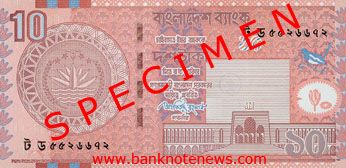
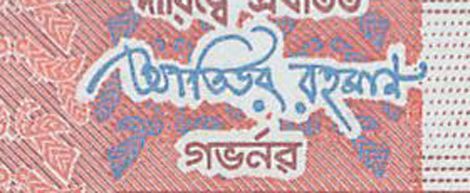
10 taka (US$0.15), 2009. Like Pick 47, but new date, new signature (Atiur Rahman), and litho printed instead of intaglio, plus text on front is surrounded by white. Intro: 31.01.2010.
Courtesy of Mohammed J. Islam.
What in the World is Notaphily?
What in the World is Notaphily?
Notaphily is the formal term used to describe banknote collectors. While people have most likely been collecting banknotes since they were first used to pay for goods and services, it wasn’t really considered a separate area of collections until late in the 20th century. Even the systematic collection of banknotes didn’t really begin in earnest until about the 1940s.
One factor in determining the value of a collectors banknote is the quality of the actual paper. Collectors can expect different grades to reflect this quality. These different grades will be compiled into a grading scale. While grading scales can change from one country to the next, expect to find uniformity in the grading scale within a particular country. For example, if you’re trading in the United States, you’ll probably find uniformity in its grading scale. However, you would not expect the grading scale in America to be necessarily the same as that of a European country.
The grading system used in bank note collecting refers to the quality of the specific note the collector has in their possession. However, some people might choose to keep track of the underlying value of the notes that are still being used in commerce. Historical currency rates can be obtained to facilitate this. Whether it is a foreign currency chart that is needed or one for your native currency, seeing the current underlying value of your banknote can be an exciting thing!
Regarding the actual collecting of banknotes, you first have to determine what type of collection you’re going to focus on. Obviously, it is possible to have too broad a collection goal. It’s just not feasible to collect every type of banknote ever produced. Find a category of note that you find interesting, unique or exciting and use that to define your collection parameters. It is always good to ease your way into any collecting process. You may want to begin by picking up notes that are inexpensive. This will give you some experience both in finding different types of banknotes and in purchasing.
For example, you might choose to collect notes from your favorite geographical location (city, country, or continent). Or perhaps your focus isn’t on location as much as it is time periods. You might be the one who chooses to collect World War II era notes, or notes produced in the 19th century. Of course, there are people who enjoy the specific features found on notes. They might enjoy collecting notes with certain security features as part of the design. In storing the notes, maybe you have some limitations that require you to focus on notes with certain dimensions.
As you can imagine, you can spend quite some time trying to define what type of banknote collection you’d like to have!
One of the best places to start is to find a currency gallery and start browsing. This will give you some idea of what type of notes you enjoy looking at. After all, if you can’t enjoy your collection once you get started, what’s the point in collecting?
Cambodia new signature 100-riel variety confirmed
Vietnam 100,000-dong note error confirmed


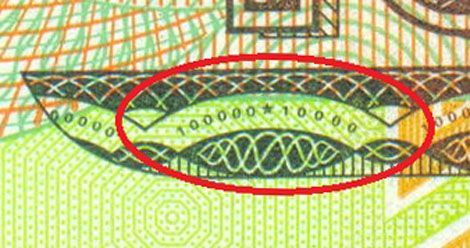
An error has been confirmed on Viet Nam’s 100,000-dong (US$5.25) polymer note (Pick 122). In the microprinting at lower left on the front of the note the denomination is spelled out in numerals, however there is a zero missing from the second full set of numerals (see circled area above). This error has been confirmed on all dates (2004, 2005, 2006, and 2008).
Courtesy of Ryan Vuong.
India 20-rupee note with R inset letter reported
Sri Lanka replaces 10-rupee note with coin
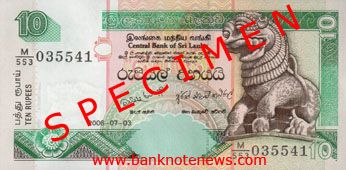
On 5 April 2010 the Central Bank of Sri Lanka issued a new 10-rupee (US$0.10) coin to replace the banknote (Pick 108 and 115) of the same denomination.
Courtesy of Aidan Work.
Iceland new sig/date (22.05.2001) 500-króna note (B810q) confirmed
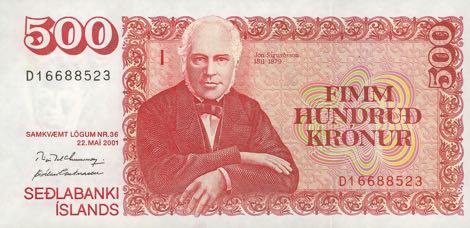
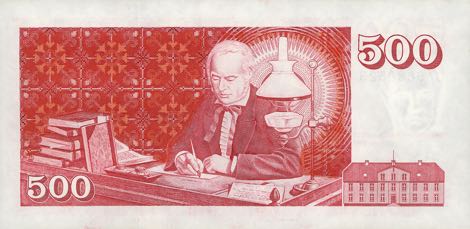
Like B810p, but new date (22.MAI 2001) and new signatures (Birgir Isleifur Gunnarsson and Eirikur Gudnason).
Courtesy of Werner Kober and Stefan.
Iceland new signature 1,000-króna note (B811o) confirmed
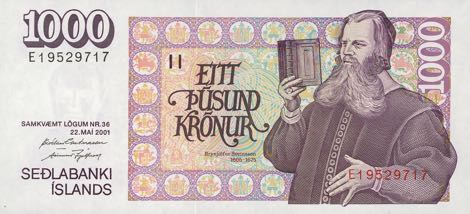
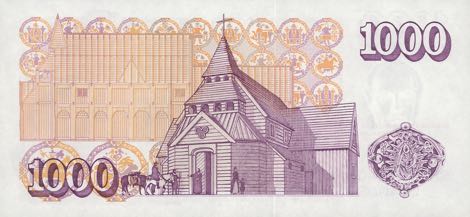
Like B811n, but new signatures (Eirikur Gudnason and Finnur Ingolfsson).
Courtesy of Werner Kober and Stefan.
Latvia new date (2009) 5- and 20-lat notes confirmed
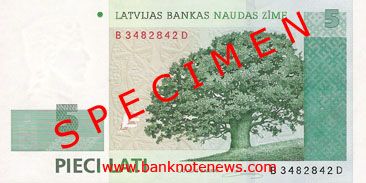

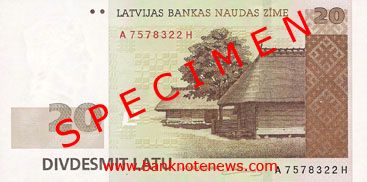

The Bank of Latvia has issued new 5- and 20-lat notes dated 2009. The 5-lat (US$10.10) note is like Pick 52, but new date. The 20-lat (US$40.35) note is like Pick 51, but new date. Both carry the same signature (Ilmars Rimsevics, Governor).
Courtesy of Nazir Rahemtulla and Jean-Michel Engels.
French Pacific Territories new signature 10,000-franc variety confirmed

10,000 francs (US$113), no date. Intro: 2010. Like P4, but new signatures (Christian Noyer, Yves Barroux, and Patrick Besse).
Courtesy of Kai Hwong.
Gambia new signature 10-dalasis note confirmed
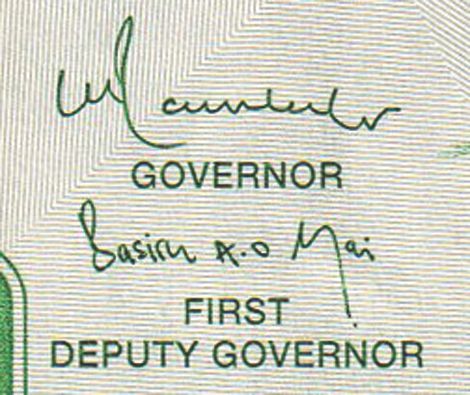
10 dalasis (US$0.40), no date. Introduced 16.04.2009. Like Pick 26, but new signatures: Governor Saho and First Deputy Governor Njai.
Courtesy of Andrew Roberts.
IBNS's Rhodesia-Zimbabwe chapter publishes 15th issue of newsletter
Jordan new sig/date (2009) 1-dinar note (B229e) confirmed
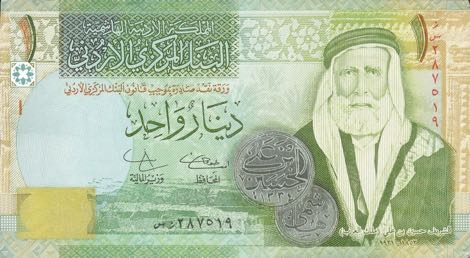
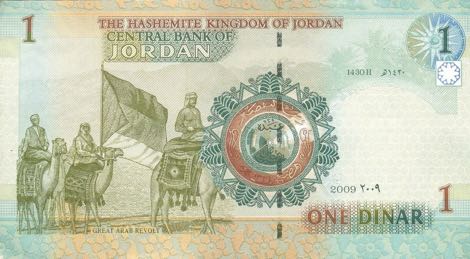
Like B229d, but new date (AH 1430 / 2009) and new signatures (Mohammad Abo Hamoor and Ummaya Toukan).
Courtesy of Abdullah Beydoun.
IBNS new Russian-language chapter formed
Seychelles new signature 10-rupee note confirmed
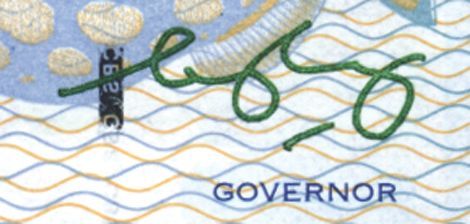
10 rupees (US$0.85), no date. Like P36a, but new signature (GOVERNOR Francis Chang-Leng, who served from May 2001 - October 2008).
Courtesy of Bill Stubkjaer.
Iceland new signature 1,000-króna notes (B815a, B815d) confirmed
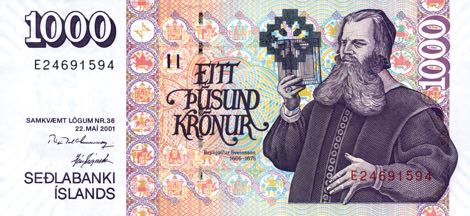
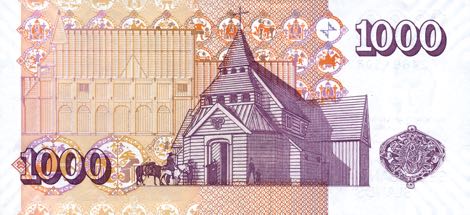
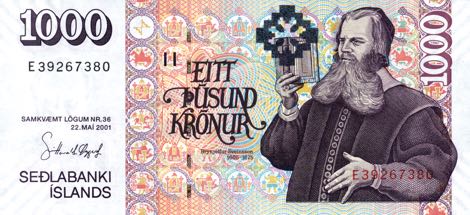

1,000 krónur (US$7.75), 22.MAÍ 2001. Like P60, but new signatures. Top scan is of note with single signature of Svein Harald Øygard. Bottom scan has two signatures: Birgir Isleifur Gunnarsson and Jón Sigurðsson.
Courtesy of Bill Stubkjaer.
Hong Kong new date (01.01.2008) 20-dollar note confirmed
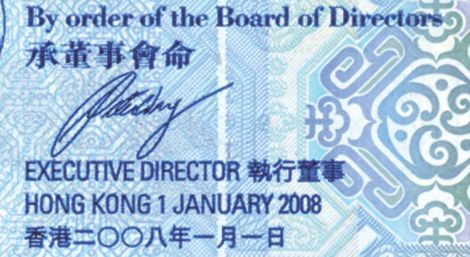
20 dollars (US$2.60), 1 JANUARY 2008. Like P207, but new date.
Courtesy of Bill Stubkjaer.
Bangladesh new date (2009) 1,000-taka note confirmed


1,000 taka (US$14.45), 2009. Like 1,000-taka note issued 27.10.2008, but new date and new signature (Atiur Rahman).
Courtesy of Bill Stubkjaer.
Bangladesh new date (2009) 20-taka note confirmed
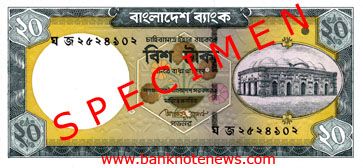
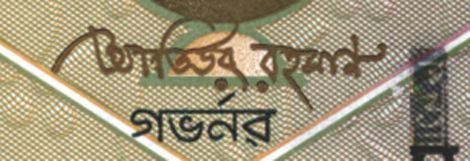
20 taka (US$0.30), 2009. Like P48a, but new date and new signature (Atiur Rahman).
Courtesy of Bill Stubkjaer.
Chile new date (2008) 1,000-peso note (B290ee) confirmed

1,000 pesos (US$1.90), 2008. Like P154, but new date.
Courtesy of Bill Stubkjaer.
Iran new 1,000,000-rial cheque confirmed
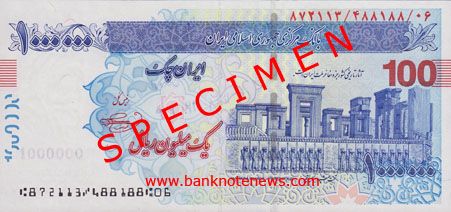
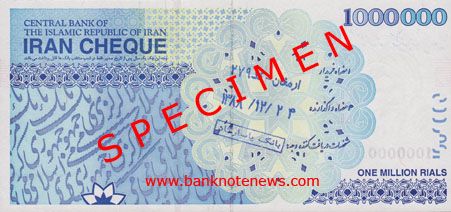
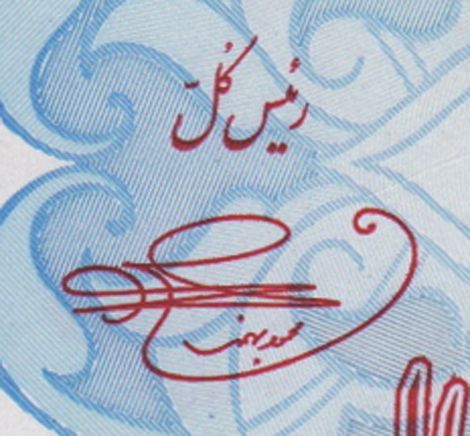
1,000,000 rials (US$101.15), no date. Introduced 2010. Like million-rial cheque issued by the Central Bank of Iran in 2008, but new color scheme and signatures.
Courtesy of Ricardo Castedo.
Iran to issue 100,000-rial notes by August 2010
Denmark three 50-krone signature varieties confirmed
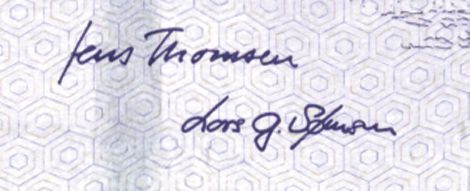
50-kroner (US$9.50), (20)09. Like the note introduced 11.08.2009, but new signature combination (Jens Thomsen, Governor; Lars Gerrild Sørensen, Head of Banking Services).
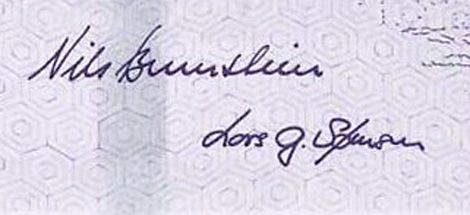
50-kroner (US$9.50), (20)09. Like the note introduced 11.08.2009, but new signature combination (Nils Bernstein, Governor; Lars Gerrild Sørensen, Head of Banking Services).
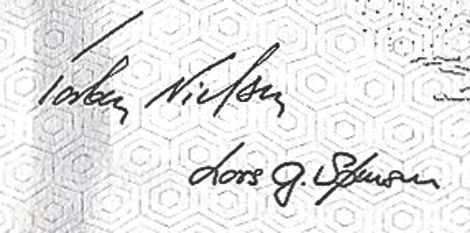
50-kroner (US$9.50), (20)09. Like the note introduced 11.08.2009, but new signature combination (Torben Nielsen, Governor; Lars Gerrild Sørensen, Head of Banking Services).
Courtesy of Krassimir Dimitrov, Paul D. Walters, and Bryce W. Denham.
Sweden's Riksbank supports keeping 20-kronor note and adding 200-kronor note
Courtesy of Zeeshan.
The Challenge: Identify items on Kenyan notes
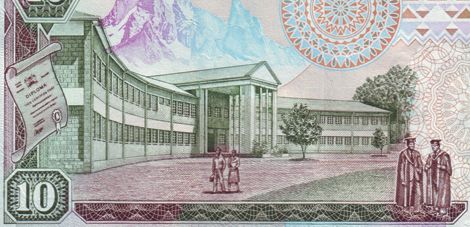
Can someone please identify the building on the back of Pick 24? Given the diploma and students in the vignette, it’s almost certainly a university, but which one? Educated guesses are welcome, but I am looking for definitive answers supported by citations if possible.
IDENTIFIED: Kabarnet Boys High School administration building in Baringo County.
Courtesy of Dennis Mukuba,
The Challenge: Identify buildings on Uganda P29 note
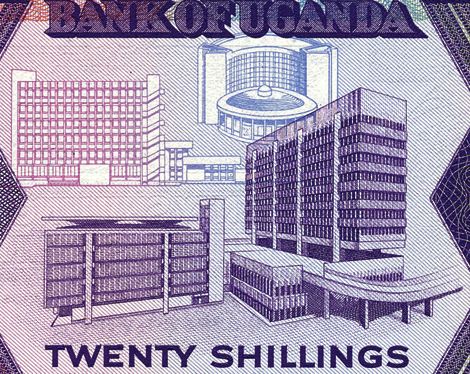
Please post a comment or send me an email if you can positively identify any of the buildings on the back of Uganda Pick 29 above.
Upper left: Unknown.
Upper center: Unknown.
Lower right: New Bank of Uganda headquarters.
Lower left: Old Bank of Uganda headquarters.
North Korea new variety foreign exchange certificate reported
However, the following two notes have recently been reported. They are exactly like Pick 23 and Pick 27, respectively, except they are red and brown in color, not blue and green. Does anyone know anything about these? Are the other denominations available in this color scheme too?

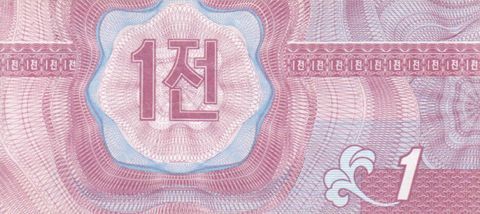
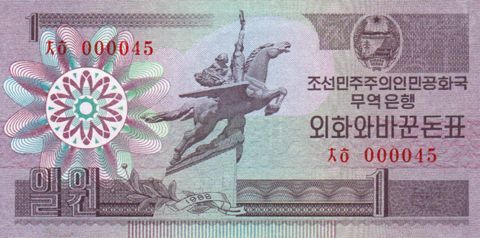
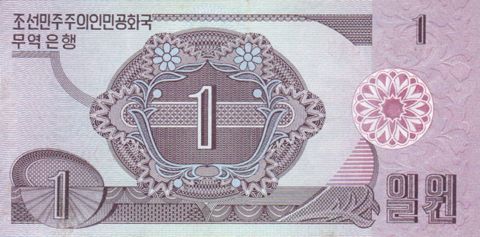
Courtesy of Alexey Semakov.
The Challenge: Identify Sudan note elements
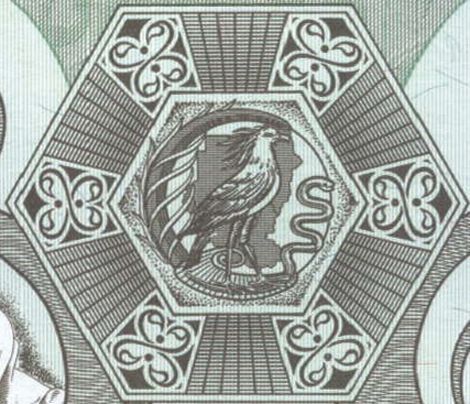
1. The secretary bird at the center of this vignette appears on the front of B312 - B321. It is not the coat of arms of the country. Perhaps it is the logo of the bank?

2. Identified: Parliament House in Omdurman.
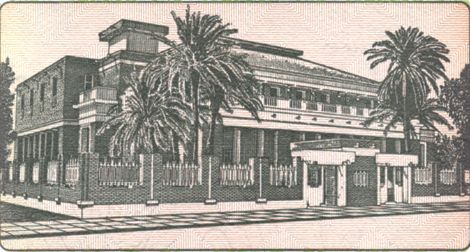
3. This building appears on the back of B342 - B344. Identified by Pavel Gusev: Ministry of Information and Communications in Khartoum.
India new date (2009) 10-rupee note with L letter confirmed

10 rupees (US$0.20), 2009. Like P95, but new date (2009), new signature (Dr. D. Subbarao, Governor since 06.09.2008), and L inset letter.
Courtesy of Sejin Ahn.
Philippines new date (2009) 100-peso note confirmed

100 pesos (US$2.20), 2009. Like Pick 194, but new date.
Courtesy of Sejin Ahn.
Nigeria color varieties on 50-naira notes reported

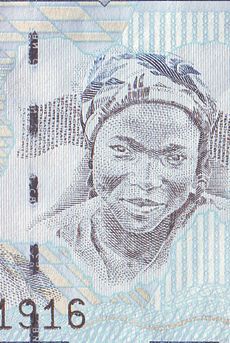
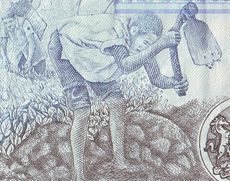
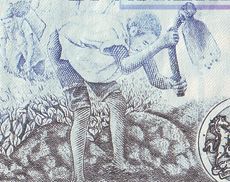
Aidan Work has reported varieties in the coloring of the 50-naira (US$0.35) note of 1991 (Pick 27). As you can see from the details above, the head scarf worn by the woman on the front of the note is entirely blue on one note (left) and black and blue on another (right). Also, the shorts worn by the man on the back of the note are also blue on one and black and blue on the other. There are other subtle color differences on the sample scans submitted.
Can anyone else confirm these color varieties in their collections? Please post comments to help resolve this issue.
Courtesy of Aidan Work.
Philippines to issue new notes in December 2010
All denominations (20, 50, 100, 200, 500, and 1,000 pesos) are being redesigned, but their colors will remain the same. Guinigundo said new personalities will be added to some of the notes, and existing portraits will be updated, while the backgrounds and vignettes will be changed to include the country’s famous tourist spots. New and old notes will circulate in parallel for up to three years.
More information can be found in this BSP press release dated 26 March 2010.
Courtesy of Leszek Porowski.
Colombia new date (29.08.2008) 2,000-peso note confirmed
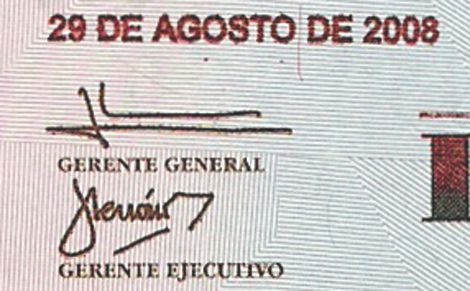
2,000 pesos (US$1.05), 29 DE AGOSTO DE 2008. Like P457, but new date.
Courtesy of Jean-Michel Engels.
North Korea new 5,000-won note (B347a) confirmed
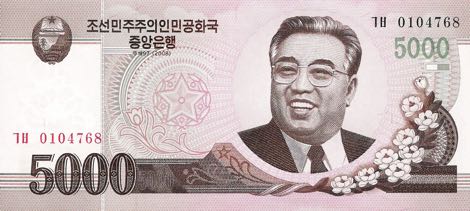
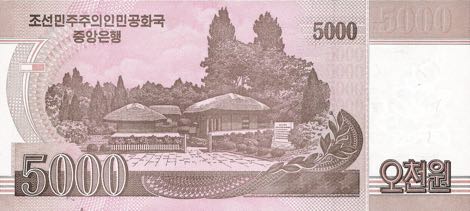
5,000 won, 2008. Brown and pink. Front: Coat of arms; star; Kim Il Sung; mongnan (Seibold’s magnolia) flowers. Back: Trees; houses (birthplace of Kim Il Sung) in Mangyongdae. Solid security thread with printed text. Watermark: Mongnan (Seibold’s magnolia) flowers. Printer: Unknown. 145 x 65 mm. Intro: 30.11.2009.
Courtesy of Jean-Michel Engels.
North Korea new 2,000-won note (B346a) confirmed
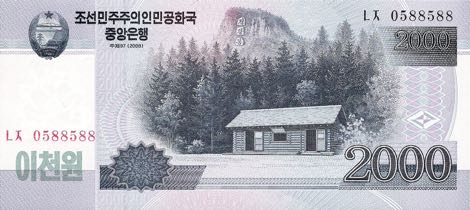
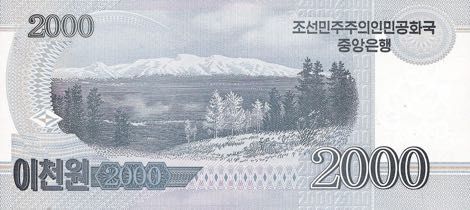
2,000 won, 2008. Light blue and gray. Front: Coat of arms; Jong Il Peak, trees, and cabin (birthplace of Kim Jong Il). Back: Trees and Baekdu (white-headed) Mountain. Solid security thread with printed text. Watermark: Mongnan (Seibold’s magnolia) flowers. Printer: Unknown. 145 x 65 mm.. Intro: 30.11.2009.
Courtesy of Jean-Michel Engels.
North Korea new 500-won note (B344a) confirmed


500 won, 2008. Gray and purple. Front: Coat of arms; Arch of Triumph. Back: Denomination and guilloché pattern. Solid security thread with printed text. Watermark: Mongnan (Seibold’s magnolia) flowers. Printer: Unknown. Dimensions 145 x 65 mm. Intro: 30.11.2009.
Courtesy of Jean-Michel Engels.
Moldova notes with new signature due in 2010
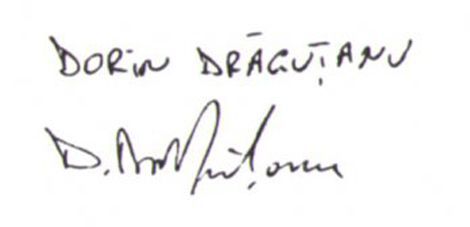
In 2010, the signature of the new governor, Dorin Dragutanu, will appear on banknotes issued by the National Bank of Moldova.
Courtesy of Alex Klark.
Philippines new date (2007) 100-peso note confirmed
Philippines new date (2009) 50-peso note confirmed
Philippines new date (2009) 20-peso note confirmed
Morocco new 50-dirham variety confirmed

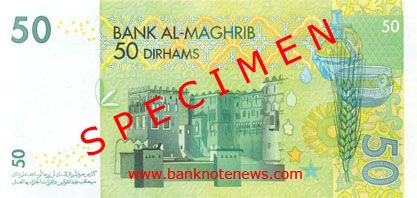

50 dirhams (US$6.05), 1423 2002. Like Pick 69, but no dash between dates. Intro: 2008.
Courtesy of banknoteshop@gmx.net.
Iran new signature 2,000-rial note confirmed
Dominican Republic new date (2009) 100-peso oro note confirmed
The Challenge: Identify Zaire and Congo DR note elements
I find it curious that many countries are proud enough to feature certain places, people, and objects on their notes, yet they fail to label these vignettes. As a result, it’s possible that their significance may be lost on future generations. That’s why I strive to provide detailed identifications of all elements depicted on notes in my new catalog. If you enjoyed the detective work as much as I did, keep your eyes on this site for future hunts.

1. Identified: Inga I dam on Congo River.
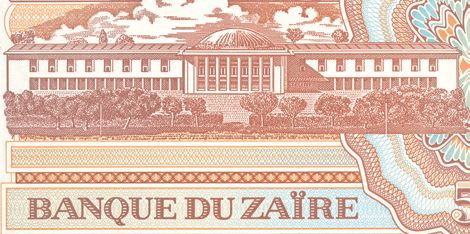
2. Identified: Palais de la Nation in Kinshasa.
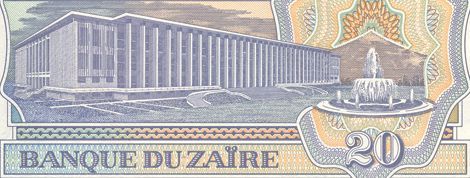
3. Identified: Palais Du Peuple in Kinshasa.

4. Identified: OEBK (Organization Équipage Banana-Kinshasa) suspension bridge (also known as Pont Maréchal) over the Congo River at port Matadi.
Bank of England to withdraw 20-pound note on 30 June 2010
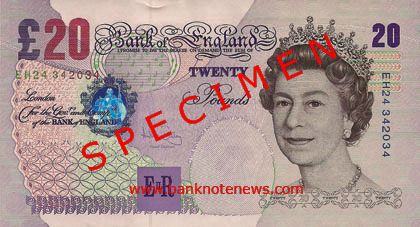
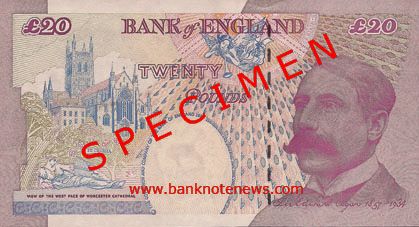
According to a Bank of England press release dated 8 March 2010, the 20-pound (US$30.10) note with the portrait of composer Sir Edward Elgar on back will cease to be legal tender after 30 June 2010. “This note has been gradually replaced by the Adam Smith £20 which was introduced in 2007. Announcing this today, the Bank of England assured holders of the Elgar £20 banknote that they could certainly use the notes up to, and including, 30 June. After that date the note will no longer have ‘legal tender’ status. The note will not have to be accepted in payment, or in change, in retail outlets after this date.”
“For several months from the end of June banks, building societies and Post Offices will accept Elgar £20 notes for deposit to customer accounts and for other customer transactions. Agreeing to exchange the notes for non-customers is at the discretion of the individual institution. The Bank of England will always give value for these notes (and all other banknotes the Bank has issued).”
“Andrew Bailey, the Bank of England’s Chief Cashier, said, ‘The Elgar £20 banknotes were first introduced in 1999 and we introduced the Adam Smith £20 banknotes three years ago. We said at the time that the two designs would circulate in tandem, with the Elgar notes gradually being withdrawn over the next few years. It is time now to withdraw the Elgar £20 notes completely, with the Adam Smith £20 banknotes to be the only £20 note design continuing in circulation.’”
Courtesy of Aidan Work.
Malaysia 1-ringgit note serial number variety confirmed
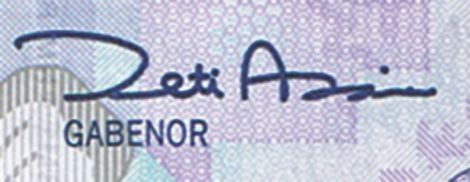

1 ringgit (US$0.30), no date. Like P39, but 3-character prefix. Serial number remains 7-digits long with signature of Zeti Akhtar Aziz. Introduced February 2010.
Courtesy of Vincent Tan.
United States to unveil new 100-dollar note 21 April 2010
“The unveiling of the $100 note is the first step in a global multi-government agency public education program implemented by the Department of the Treasury, the Federal Reserve Board and the U.S. Secret Service, to educate those who use the $100 note about its changes before it begins circulating. The $100 note is the highest value denomination of U.S. currency in general circulation, and it circulates broadly around the world. Public education is an important component of the government's redesigned currency program because a well informed public is our first and best line of defense against counterfeiting. Free training materials for cash-handlers as well as other public education resources will be available in 25 languages at www.newmoney.gov beginning at 10:30 a.m. EDT on April 21.”
Courtesy of Alan Moe.
Canada to issue polymer notes in 2011
Courtesy of Dharshan Mahalingam and Mark Allen.
India 20-rupee note without inset letter reported
Additional information and images are requested.
Nigeria extends circulation of low-denomination paper notes
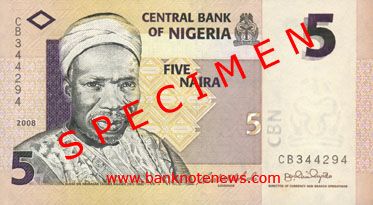

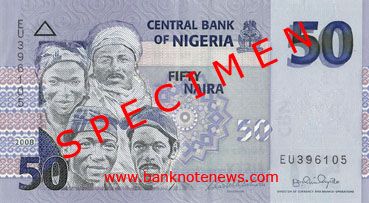
In a press release dated 3 March 2010, the Central Bank of Nigeria (CBN) indefinitely extended the terminal date for the circulation of the existing 5-, 10-, and 50-naira paper banknotes as legal tender, allowing them to circulate in parallel with polymer notes of the same denominations. “The Bank also wishes to reassure Nigerians that the N50 polymer banknotes, whether with 6-digits or 7-digits serial numbers were issued by the CBN and therefore genuine banknotes. The numbers on the notes are consistent with the numbering system adopted by the Bank. Both sets of banknotes are fortified with adequate security features which make counterfeiting difficult.”
Bosnia and Herzegovina removing 5-convertible marka note from circulation
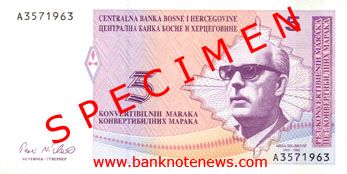
The Central Bank of Bosnia and Herzegovina (CBBH) is reminding citizens in possession of 5-convertible marka (US$3.50) notes that they have until 31 March 2010 to exchange them at commercial banks. The note ceased to be legal tender on 31 December 2009 and as such are no longer accepted in circulation for settlement of any type of liabilities. A coin of the same denomination remains in circulation.
United States considers putting Ronald Reagan on 50-dollar note
Bosnia and Herzegovina new date (2009) 50-convertible marka note confirmed
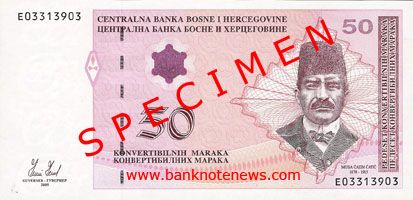
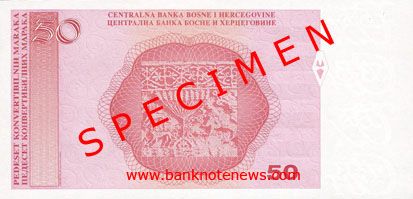

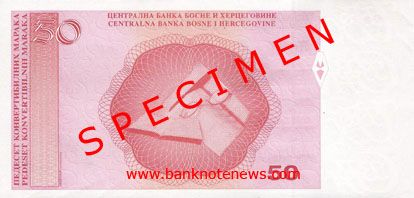
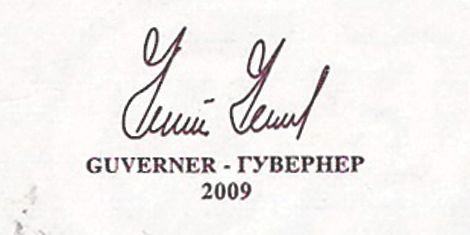
On 14 December 2009, the Central Bank of Bosnia and Herzegovina (CBBH) introduced a 50-convertible marka (US$36.60) note like Pick 72, but dated 2009 and a new signature (Kemal Kozanic).
Courtesy of Kovács Sándor and Jean-Michel Engels.
Philippines new date (2009) 1,000-peso note confirmed
Kuwait new signature varities confirmed
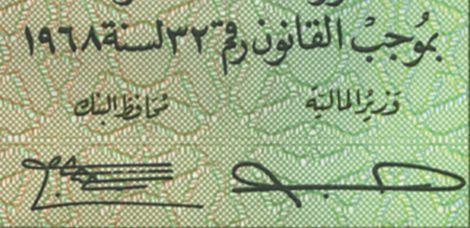
All denominations of Kuwaiti notes with the exception of the 1/2 dinar and 10 dinar have now been confirmed with the new signature combination of Salem Abdul Aziz Sa’ud al-Sabah, Governor and Mustafa Jassim Al-Shamali, Minister of Finance.
Courtesy of Rafal Nogowczyk.
India new date (2009) 1,000-rupee note with L inset letter confirmed


1,000 rupees (US$19.35), 2009. Like Pick 100, but new date and L inset letter.
Courtesy of Rafal Nogowczyk.
Jordan new sig/date (2009) 50-dinar note (B234f) confirmed
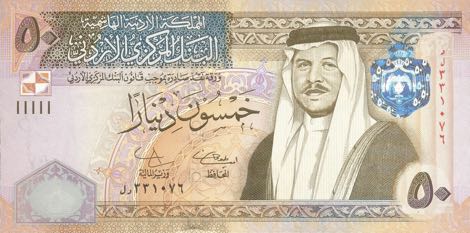

Like B234e, but new date (AH 1430 / 2009) and new signatures (Basem Al-Salem and Umayya Salah Toukan).
Courtesy of Abdullah Beydoun.
Namibia new 100-dollar variety confirmed

100 dollars (US$12.95), no date. Like Pick 7, but J prefix and 8-digit serial number. Printed by SABN without imprint. Issued 2009.
Courtesy of Andrew Roberts.
Poland new 20-złoty commemorative confirmed
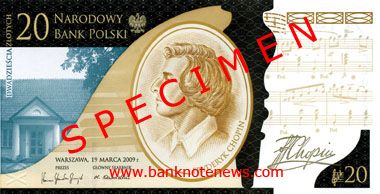
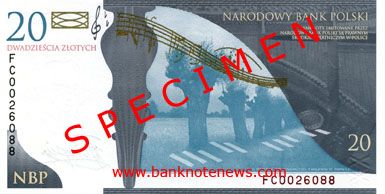

The National Bank of Poland honored the 200th birthday of musician Frédéric François Chopin with a new commemorative 20-złoty (US$7.10) banknote.
On the front center of the banknote measuring 138 x 69 mm is a portrait of Frederic Chopin seen in profile. At left is the mansion in Zelazowa Wola where the composer was born, and at right is a reproduction of Mazurka in B minor, Op. 7 together with the signature of the artist. On the back is a landscape with characteristic Masovian willows and Chopin’s etude in F minor, Op. 10.
This is the fourth commemorative note issued by the NBP, all of which are sold exclusively for the collector market and are not intended for circulation. This latest commemorative went on sale 26 February 2010 at a price of 50 zloty (US$17.20) each.
Courtesy of Rafal Nogowczyk.
Singapore new 1,000-dollar note confirmed
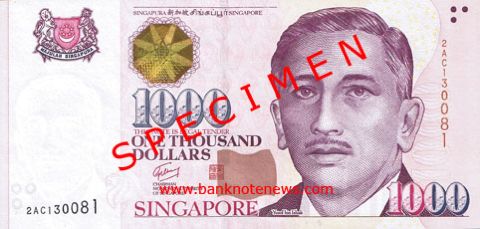
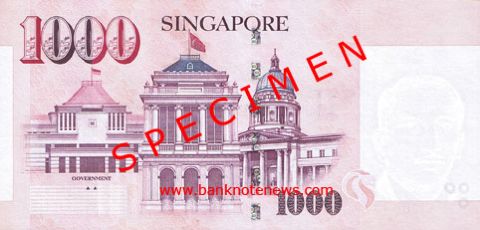
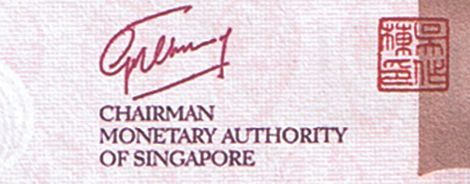
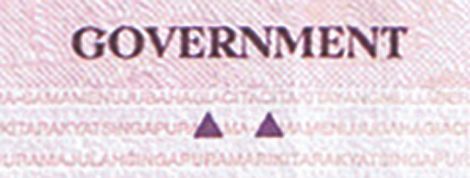
1,000 dollars (US$696), no date. Like Pick 43, but new signature (Goh Chok Tong), new issuer (Monetary Authority of Singapore), and two triangles below GOVERNMENT on back.
Courtesy of Vincent Tan.
Singapore 2-dollar note with two squares confirmed

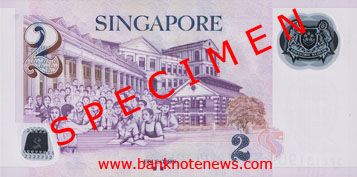
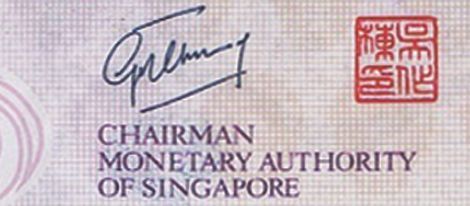
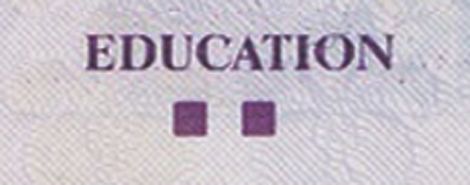
2 dollars (US$1.40), no date. Like Pick 46, but with two squares below EDUCATION on back.
Courtesy of Vincent Tan.
Solomon Islands new signature 50-dollar note (B219b) confirmed
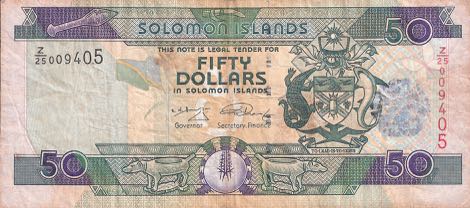

Like B219a, but new signatures (Rick N. Houenipwela and Luma Darcy).
Courtesy of Paul Nahmias.
United Arab Emirates new 200-dirham note (B230a) confirmed

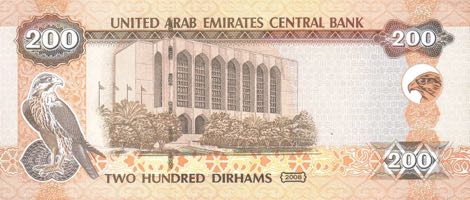
B230 (P31): 200 dirhams (US$54)
Tan and gold. Front: Arabic text; Saker falcon head as registration device; coat of arms; Sheikh Zayed Sports City and Judicial Department and Sharia Court buildings in Abu Dhabi. Back: English text; Saker falcon; UAE Central Bank headquarters building in Abu Dhabi; Saker falcon head. Holographic stripe with denomination. Windowed security thread. Watermark: Saker falcon head with electrotype 200 and coffee pot. Printer: (Unknown). 159 x 68 mm. a. ١٤٢٩ (AH1429)/2008. Sig. 3. Prefix 000 - 038.
Courtesy of Amirali Somji.
Mexico new sig/date (28.10.2008) 500-peso note confirmed

500 pesos (US$39.05), 28 OCT. 2008. Like Pick 120, but new date, new signatures (Roberto del Cueto Legaspi and Raúl Valdés Ramons), and new series (AW).
Courtesy of Rickey Stein.
Mexico new sig/date 200-peso notes confirmed

200 pesos (US$15.60), 14 MAY. 2007. New date, new signatures (Guillermo Ortiz Martínez and Raúl Valdés Ramons), and new series (E).

200 pesos (US$15.60), 14 MAY. 2007. New date, new signatures ( Everado Elizando Almaguer and Raúl Valdés Ramons), and new series (F).

200 pesos (US$15.60), 20 NOV. 2007. New date, new signatures (Jesús Marcos Yacamán and Raúl Valdés Ramons), and new series (G).

200 pesos (US$15.60), 20 NOV. 2007. New date, new signatures (Everado Elizondo Almaguer and Raúl Valdés Ramons), and new series (H).
Courtesy of Rickey Stein.
Mexico new sig/date (14.05.2007) 200-peso notes confirmed

200 pesos (US$15.60), 14 MAY. 2007. Like Pick 119, but new date, new signatures (José Julian Sidaoui Dib and Raúl Valdés Ramons), and new series (DN).
Courtesy of Rickey Stein.
Mexico new sig/date (28.04.2008) 100-peso notes confirmed

100 pesos (US$7.80), 28 ABR. 2008. Like Pick 118, but new date, new signatures (Roberto del Cueto Legaspi and Raúl Valdés Ramons), and new series (DZ).
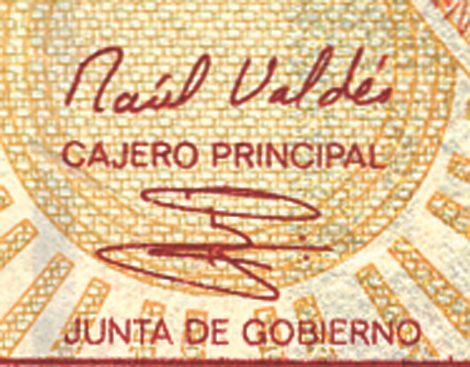
100 pesos (US$7.80), 28 ABR. 2008. Like Pick 118, but new date, new signatures (Guillermo Ortiz Martinez and Raúl Valdés Ramons), and new series (EA).
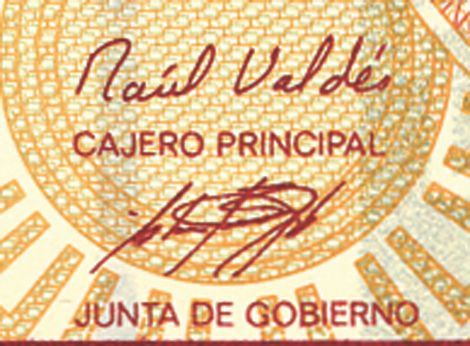
100 pesos (US$7.80), 28 ABR. 2008. Like Pick 118, but new date, new signatures (Everado Elizando Almaguer and Raúl Valdés Ramons), and new series (EB).
Courtesy of Rickey Stein.
Vanuatu to issue polymer 10,000-vatu note in July 2010
Governor Odo Tevi stated, “The existing note series has come under a lot of pressure over the years, particularly with regard to the lifespan and counterfeiting challenges. It is apparent that in recent years most countries in our region have modernized their currency, therefore it is considered appropriate that in the 30th year of independence, the Reserve Bank of Vanuatu takes steps to introduce a new modernized series of vatu banknotes.”
Courtesy of Leszek Porowski.
Pakistan new date (2009) 10-rupee note (B231d) confirmed
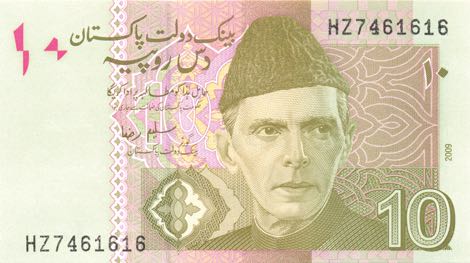
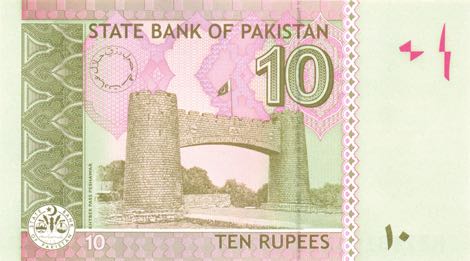
Like B231c, but new date (2009) and new signature (Syed Salim Raza).
Courtesy of banknoteshop@gmx.net.
Pakistan new date (2009) 20-rupee note (B233c) confirmed
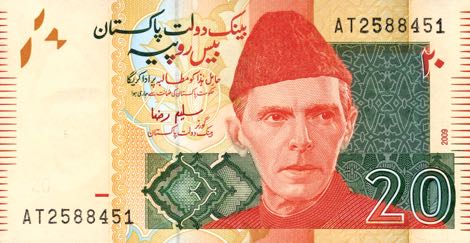
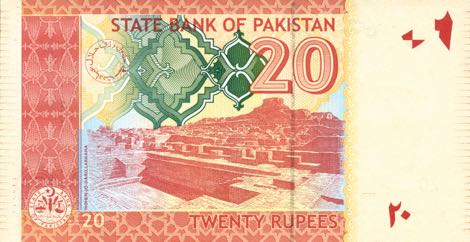
Like B233b, but new date (2009) and new signature (Syed Salim Raza).
Courtesy of banknoteshop@gmx.net.
Pakistan new date (2009) 50-rupee note (B234b) confirmed


Like B234a, but new date (2009) and new signature (Syed Salim Raza). Introduced 15 May 2009.
Courtesy of banknoteshop@gmx.net.
Sweden considering changes to its currency
Courtesy of Martin Rydberg.
Pakistan revised 500-rupee note (B237a) confirmed
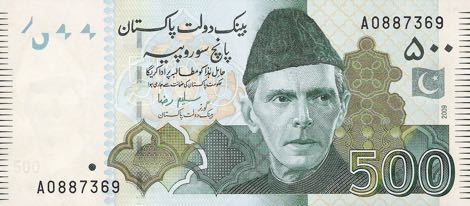
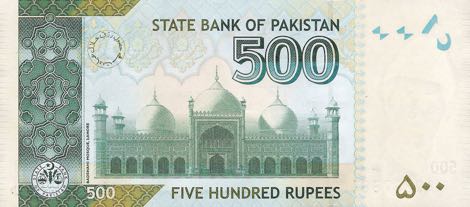
State Bank of Pakistan introduced a new 500-rupee note (B237a) on 25 January 2010. The new note bears the signature of Syed Salim Raza, SBP Governor. The new note is like B236, which was introduced in 2006, except on right front it now features the Pakistani flag of a crescent and five-pointed star in green-to-magenta OVI. Both notes will circulate in parallel.
Courtesy of Jean-Michel Engels.
Switzerland postpones new notes until 2012
“Intensive efforts are underway at the Swiss National Bank (SNB) on the preparatory work for its new banknote series. The project activities have revealed that additional development work will bring improvements as regards those technological security features which are being used for the first time. However, this will take time, and as a result the project will need to be rescheduled.
“The SNB still intends to replace existing banknotes with a new series. Given the high security standard of the banknote series currently in circulation, however, there is no urgent need for replacement. To allow time for the additional development processes, the SNB is postponing the issue date of the new banknote series, which had originally been scheduled for autumn 2010. The SNB expects that the first note of the new series can be issued in 2012.
“As mentioned in previous announcements, the new banknote series depicts Switzerland as a meeting place and platform for organisation, creativity, adventure, humanity, progress and dialogue. The current denominations of CHF 10, 20, 50, 100, 200 and 1,000 and the familiar colours of the individual denominations will remain unchanged, although the new notes will be slightly smaller than the current series. As well as improving their overall proportions, this will ensure that they are even better able to meet current and future demands on payment instruments.”
Courtesy of David Liu and Christof Zellweger.
Vietnam new date (2009) notes confirmed

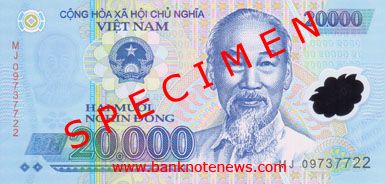
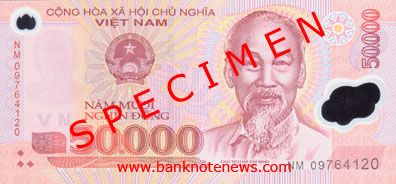
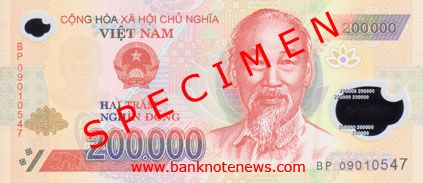
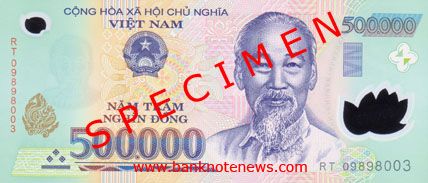
10,000 to 500,000 dong. Like Pick 119-124, but new date (20)09.
Courtesy of Torsten Fuhlendorf.
North Korea new 200-won note (B343a) confirmed
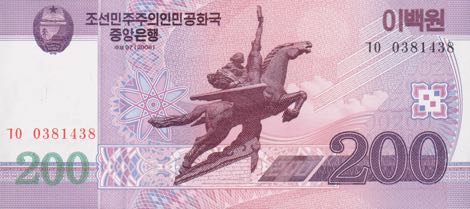
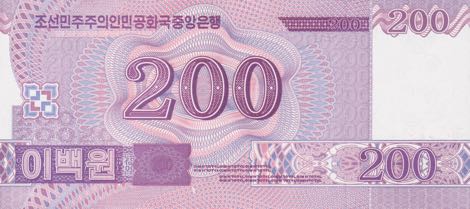
200 won, 2008. Violet. Front: Coat of arms; statue of woman with wheat and man with book riding Chollima (thousand mile horse) in Pyongyang. Back: Denomination and guilloché pattern. Solid security thread with printed text. Watermark: Mongnan (Seibold’s magnolia) flowers. Printer: Unknown. 145 x 65. Intro: 30.11.2009.
Courtesy of Torsten Fuhlendorf.
North Korea new 100-won note (B342a) confirmed

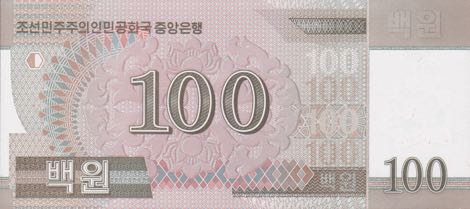
100 won, 2008. Green. Front: Coat of arms; mongnan (Seibold’s magnolia) flowers. Back: Denomination and guilloché pattern. Solid security thread with printed text. Watermark: Mongnan (Seibold’s magnolia) flowers. Printer: Unknown. 145 x 65. Intro: 30.11.2009.
Courtesy of Torsten Fuhlendorf.
Mexico new sig/date (15.05.2007) 200-peso note confirmed

200 pesos (US$15.45), 15 MAY. 2007. New date, new signatures (Jesús Marcos Yacamán and Raúl Valdés Ramos), and series D.
Courtesy of Ricardo G. Ramírez.
Mexico new sig/date (20.11.2007) 100-peso note confirmed
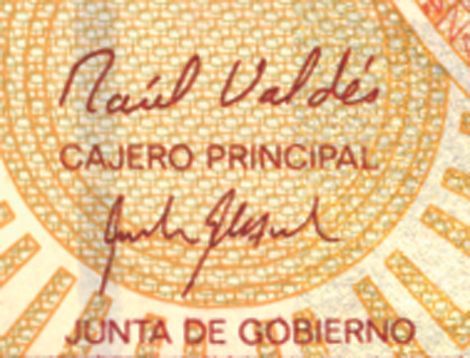
100 pesos (US$7.70), 20 NOV. 2007. Like Pick 108, but new date, new signatures (Jesús Marcos Yacamán and Raúl Valdés Ramos), and series DY.
Courtesy of Ricardo G. Ramírez.
Nigeria new signature 2009 100-naira note confirmed
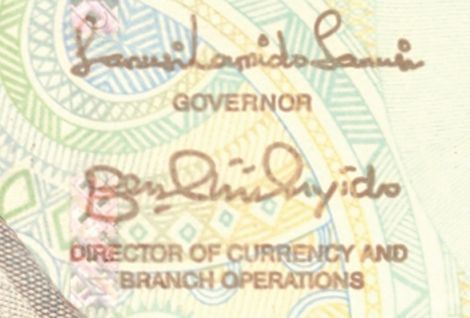
100 naira (US$0.70), 2009. Like Pick 28, but new date and new signature combo (Lamido Aminu Sanusi and Benjamin C. Onyido).
Courtesy of Arigo Avbovbo.
Norwegian 50-krone notes printed abroad put into circulation
Courtesy of Håkon Hagelund.
Bahamas new CRISP 100-dollar note (B343a) confirmed

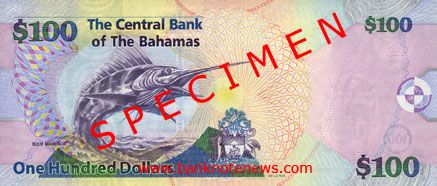
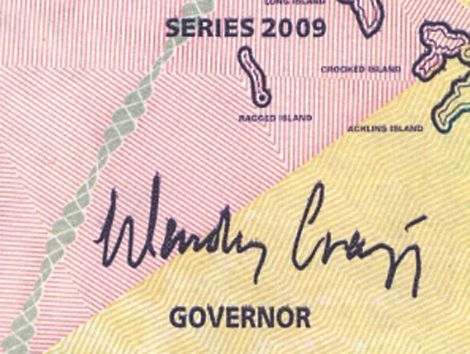
On 16 December 2009 the Central Bank of The Bahamas introduced a more secure 100-dollar banknote. This is the sixth and final denomination issued in the new CRISP (Counterfeit Resistance Integrated Security Product) family of notes. The new notes will circulate in parallel with the old $100 notes, which will eventually be phased out of circulation.
The new note is purple, blue, green, and mauve. It features a portrait of Queen Elizabeth II on the front, and a picture of a blue marlin on the back. The note has a new watermark of QEII, the numeral 100 on the front left, and a new registration device of a sand dollar. CRISP banknote paper is also coated with a new sizing agent to help prevent the chemical removal of inks from the paper.
100 dollars (US$100), 2009. Purple, blue, green, and mauve. Front: Sand dollar; map; hologram; Queen Elizabeth II. Back: Blue marlin fish; coat of arms. Solid security thread and 3-mm windowed security thread with demetalized BAHAMAS and sand dollar. Watermark: Queen Elizabeth II with electrotype 100. Printer: DE LA RUE. 156 x 67 mm.
Courtesy of Thomas Krause and TDS.
Iraq to redenominate notes by end of 2010
South Africa new signature 100-rand note confirmed

100 rand (US$12.85), no date. Like Pick 131, but new signature (Ms. Gill Marcus).
Courtesy of Andrew Roberts.
Liberia new date (2008) 5-dollar note confirmed

5 dollars (US$0.07), 2008. Like Pick 26, but new date and new signatures (Antoinette Sayeh, MINISTER OF FINANCE; J. Mills Jones, EXECUTIVE GOVERNOR).
Courtesy of Andrew Roberts.
Zimbabwe lined paper 500,000-dollar note confirmed
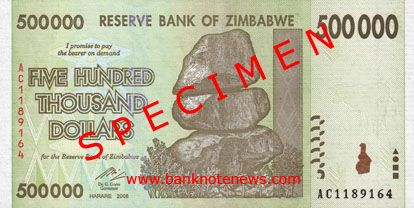

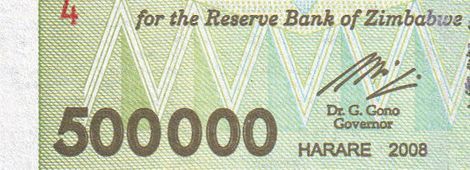
500,000 dollars, 2008. Like Pick 76, but instead of plain paper, this variety is printed on lined paper.
Courtesy of Andrew Roberts.
Indonesia to replace 1,000-rupiah note with coin in April
Belize new sig/date (01.07.2009) 5-dollar note (B325d) confirmed
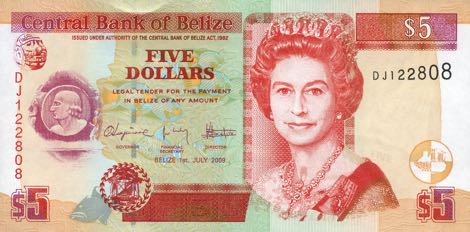

Like B325c, but new date (1st. JULY 2009) and new signatures. Prefix DJ.
Courtesy of TDS.
Nicaragua new 500-córdoba note confirmed
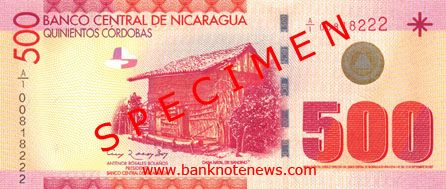


On 12 January 2010, Banco Central de Nicaragua introduced a new 500-córdoba (US$24) note printed on cotton paper and carrying the law date of 12 DE SEPTIEMBRE DE 2007 (12.09.2007) . This note which measures 156 x 67 mm depicts the birthplace of General Augusto César Sandino while the back features Indian statues. The note is protected by a watermark of Sandino with electrotype 500, iridescent stripe, registration device, intaglio printing, bank logo in OVI, and color-changing windowed security thread with demetalized BCN 500.
Courtesy of Cleophas Elmakias Schockemohle and banknoteshop@gmx.net.
Honduras new polymer 20-lempira note confirmed



According to a press release, the Banco Central de Honduras introduced a new polymer 20-lempira (US$1.05) note on 12 January 2010. A total of 60 million banknotes have been printed and will circulate in parallel with the paper version of the same denomination.
Courtesy of Thomas Krause, Claudio Marana, and banknoteshop@gmx.net.
Maldives new date (29.12.2008) 20-rufiyaa note confirmed

20 rufiyaa (US$1.55), 2008/AH1430. Like Pick 20, but new date (29.12.2008) and new signature (unknown).
Courtesy of Rui Manuel Palhares.
Nigeria new 10- and 50-naira note varieties confirmed

10 naira (US$0.06), 2009. Signed by Lamido Aminu Sanusi and Benjamin C. Onyido, with 6-digit serial number.

50 naira (US$0.30), 2009. Signed by Chukwuma “Charles” Soludo and Benjamin C. Onyido, with 7-digit serial number.
Courtesy of Arigo Avbovbo.
North Korea new 10- and 50-won notes (B340a, B341a) confirmed
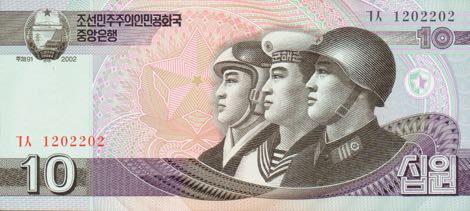
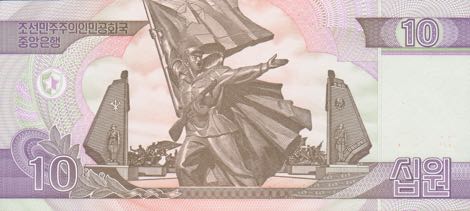
10 won, 2002. Blue, green, and purple. Front: Coat of arms; star; pilot, sailor, and soldier. Back: Military statues with soldier holding flag. No security thread. Watermark: Mongnan (Seibold’s magnolia) flowers. Printer: Unknown. 145 x 65 mm. Intro: 30.11.2009.
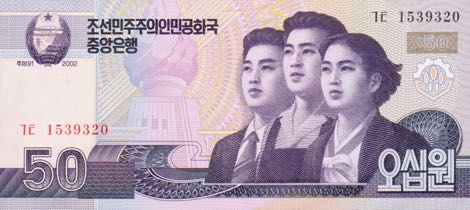
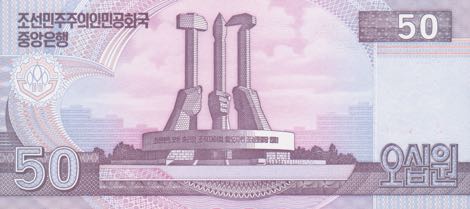
50 won, 2002. Purple. Front: Coat of arms; flame atop Juche Idea monument in Pyongyang; man in business suit, man in overalls, and woman wearing blouse. Back: Party Foundation Monument in Pyongyang with hands holding hammer, paint brush, and sickle. No security thread. Watermark: Mongnan (Seibold’s magnolia) flowers. Printer: Unknown. 145 x 65 mm. Intro: 30.11.2009.
Courtesy of Torsten Fuhlendorf.
Nicaragua new 50-córdoba note confirmed
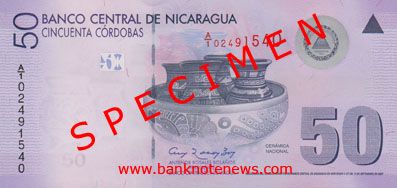
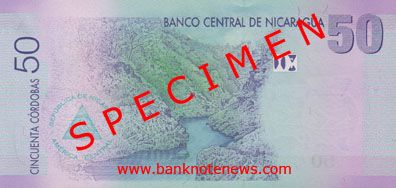

On 3 December 2009, the Banco Central de Nicaragua introduced a new 50-córdoba (US$2.40) note printed on paper. It depicts pottery of Nicaragua on the front and Somoto canyon on back. The windowed security thread is demetalized BCN 50. The watermark is of the pottery with electrotype 50.
Courtesy of Marcin Wiktoruk and Thomas Augustsson.
Peru new date (21.12.2006) 50-nuevo sol note confirmed


50 nuevos soles (US$17.50), Like Pick 180, but new date (21 DE DICIEMBRE DE 2006).
Courtesy of Christof Zellweger.
Kazakhstan new 1,000-tenge commemorative note (B135a) confirmed

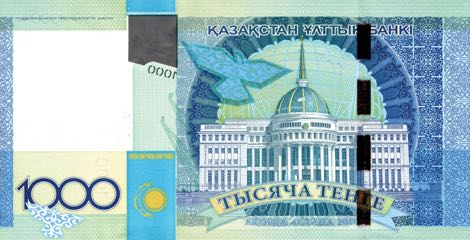
The National Bank of Kazakhstan issued a new 1,000-tenge note on 5 January 2010 to commemorate Kazakhstan’s chairmanship of the Organization for Security and Co-operation in Europe in 2010.
A total of 10 million notes will be issued at face value (US$6.75). The note dated 2010 is the same size (134 x 70 mm) as the current note of the same denomination, though the color is now turquoise-green, and the designs are as follows:
Obverse: State Emblem of the Republic of Kazakhstan in left upper corner, decorative image of flying birds in national style, face value in Kazakh language in the center, motives of Kazakh national patterns along the banknote, holographic image of Baiterek monument , color-changing logo of National Bank of Kazakhstan on the right part
Reverse: State Flag of the Republic in the left lower corner, Akorda palace of President of the Republic of Kazakhstan in the center with face value in Russian language, image of a bird and year of issue 2010, numerical indication of face value in the left lower part, motives of Kazakh national patterns along the banknote.
Courtesy of Vadim Tislenko.
India new date (2009) 100-rupee note with F inset letter confirmed


100 rupees (US$2), 2009.
Like Pick 98, but new date (2008), new signature (D. Subbarao, Governor), and F inset letter.
Courtesy of Alberto Fochi.
India new date (2008) 50-rupee note with E inset letter confirmed


50 rupees (US$0.95)
Like Pick 97, but new date (2008), new signature (Dr. Y. V. Reddy, Governor), and E inset letter.
Courtesy of Alberto Fochi.
Hong Kong new date (01.01.2008) 100-note confirmed
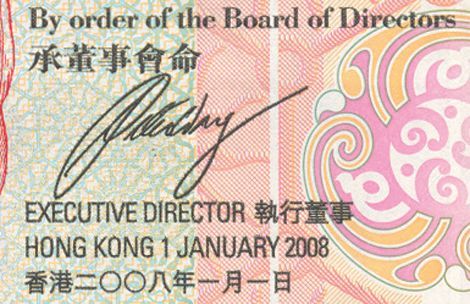
100 dollars (US$12.85), 1 JANUARY 2008. Like Pick 209, but new date and new signature.
Courtesy of Christof Zellweger.
North Korea new 5-won note (B339a) confirmed
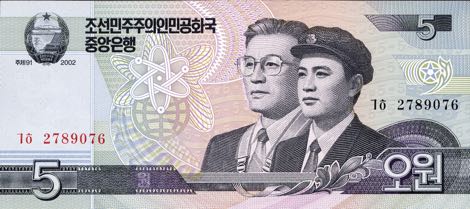

5 won, 2002. Blue, green, and purple. Front: Coat of arms; atomic symbol; man with glasses; boy with cap. Back: Dam. No security thread. Watermark: Mongnan (Seibold’s magnolia) flowers. Printer: Unknown. 145 x 65 mm. Intro: 30.11.2009.
Courtesy of Alberto Fochi.
Nepal new 1,000-rupee note (B279) confirmed
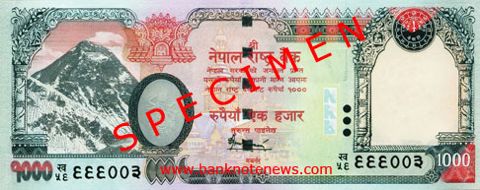
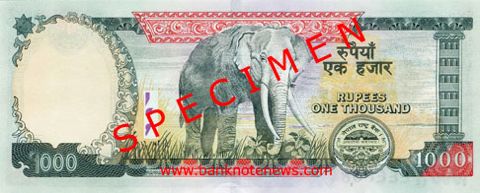

B279: 1,000 rupees (US$13.65)
Like Pick 66, but without rhododendron printed atop watermark area. Introduced 8 January 2010.
Blue, brown, and green. Front: Mount Everest; goddess Bhagwati; Swayambhunath stupa and temple of goddess Harati; obverse of coin. Back: Elephant; bank logo. 4-mm wide windowed security thread with demetalized NRB. Watermark: Rhododendron. Printer: Unknown. 172 x 70 mm.
Courtesy of Claudio Marana, Ömer Yalcinkaya, and Shankar Shrestha.
Trinidad and Tobago new 100-dollar CHOGM commemorative confirmed


The Central Bank of Trinidad & Tobago introduced a new 100-dollar (US$15.80) note to commemorate the Commonwealth Heads of Government Meeting (CHOGM) that was held 27-29 November in the capital, Port of Spain.
The new notes is legal tender, circulating side-by-side with the current note of the same denomination (Pick 45). The commemorative note has all the security features of the current note, though there are two changes to the front:
- 60 years of the Commonwealth 1949-2009
- CHOGM logo in single color
On the reverse of the note are the following changes:
- CHOGM logo in full color
- Carnival sun image at the top of the note
- The Port-of-Spain International Waterfront Centre and the view of the city of Port-of-Spain in the background
- The oil rig has been shifted to the right of the note
- Larger $100 numeral at the top right of the note
- ONE HUNDRED DOLLARS in words at the bottom of the note.
Courtesy of Mark Allen and TDS.
Paraguay new 2,000-guaraní polymer note (B846a) confirmed
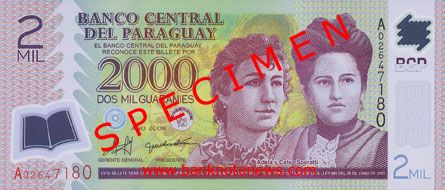

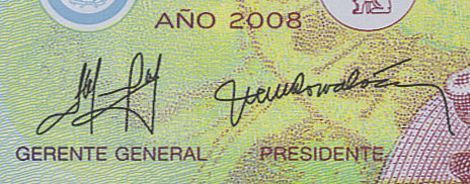
On 18 December 2009, the Central Bank of Paraguay introduced a new 2,000-guaraní (US$0.45) polymer note dated 2008, featuring portraits of educators Adela and Celsa Speratti on front, and a parade with flag-waving marchers on back. Printer: OBERTHUR TECHNOLOGIES.
Courtesy of Thomas Krause, Claudio Marana, Roman Boroznjak, and Rui Manuel Palhares.
Rwanda new 5,000-franc note confirmed
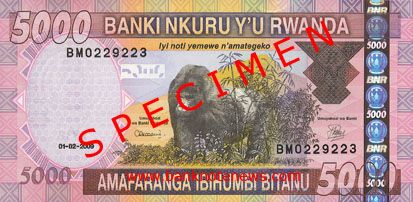


5,000 francs (US$8.75), 01-02-2009. Like Pick 33, but new date, bank name and signature titles in Kinyarwanda, new registration device, and new color (yellow) at front center.
Courtesy of Richard Miranda and Rui Manuel Palhares.
Burundi new date (01.07.2009) 10,000-franc note confirmed

10,000 francs (US$8.10), 01-07-2009. Like Pick 43, but new date and new signatures.
Courtesy of Richard Miranda and Rui Manuel Palhares.
Romania new 10-leu note (B281a) confirmed

2005-dated note (B280)

2008-dated note (B281)
This note was originally reported as a new date variety only, but it has recently been determined that there are sufficient changes to this note to qualify it as a new type.
10 lei (US$3.50), 1 decembrie 2008. Like B280, but new date, paint brushes replace 10 on see-through window, new colors for various text elements and bank logo, and two-tone numerals 10 now monochrome. Polymer.
Courtesy of Thomas Krause and Andrew Quirke.
Egypt new 10-pound note confirmed

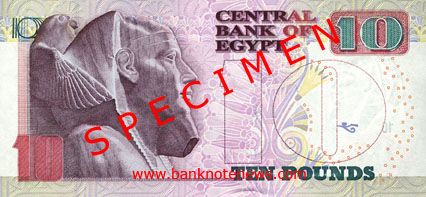
10 pounds (US$1.85). Like Pick 64, but new security thread type and placement, and the watermark is of a pharaoh’s bust with electrotype 10 instead of Tutankhamen's mask. This note has been confirmed dated 13.03.2007, 15.04.2008, 27.04.2008, and 28.04.2008 (all dates appear in Arabic on the notes). The latest date variety confirmed for Pick 64 is 22.11.2006.
Courtesy of Alberto Fochi and Banknoteshop.
Egypt new date (2009) varieties confirmed
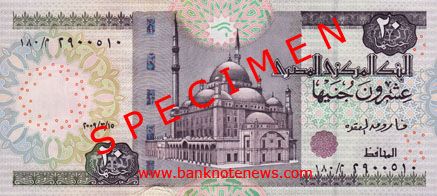
20 pounds (US$3.65). New date 15.03.2009.
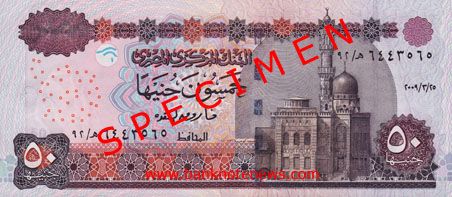
50 pounds (US$9.15). New date 25.03.2009.
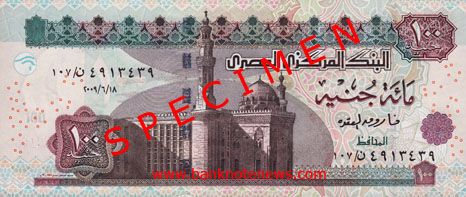

100 pounds (US$18.35). New date 18.06.2009.
Courtesy of Ricardo Castedo and Banknoteshop.
Mexico new date (14.05.2007) 20-peso note confirmed
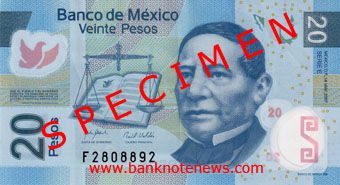
20 pesos (US$1.55), 14 MAY. 2007. New date, series E, and new signatures (Jesus Marcos Yacaman and Raul Valdes Ramons).
Courtesy of Thomas Krause and Richard Miranda.
Bangladesh new signature variety 1,000-taka note confirmed
Courtesy of Nat Denkin and Mohammed Islam.
Honduras new date (17.04.2008) varieties confirmed

1 lempira (US$0.05), 17 DE ABRIL DE 2008. Like Pick 84, but new date, new signatures, and new printer imprint: OBERTHUR TECHNOLOGIES.

2 lempira (US$0.10), 17 DE ABRIL DE 2008. Like Pick 80A, but new date, new signatures, and new printer imprint: OBERTHUR TECHNOLOGIES.
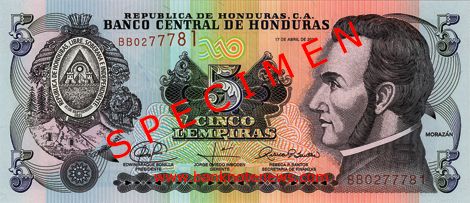
5 lempira (US$0.25), 17 DE ABRIL DE 2008. Like Pick 85, but new date, new signatures, and new printer imprint: OBERTHUR TECHNOLOGIES.

50 lempira (US$2.65), 17 DE ABRIL DE 2008. Like Pick 94, but new date and new signatures.
Courtesy of Richard Miranda and Rui Manuel Palhares.
Nigeria new sig/date (2009) 200-naira note confirmed
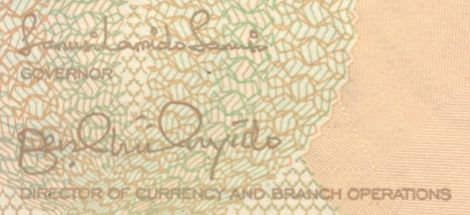
200 naira (US41.45), 2009. This note is like P29, but with new date (2009) and new signatures of Lamido Aminu Sanusi and Benjamin C. Onyido.
Another 2009 dated N200 note has been confirmed, but it has a different signature combination. Interestingly, on this new variety, the signatures, titles, and year are all printed in light brown ink whereas these elements have traditionally been printed in black ink.
Courtesy of Arigo Avbovbo.
Nigeria new date (2009) 5-, 10-, and 50-naira notes confirmed
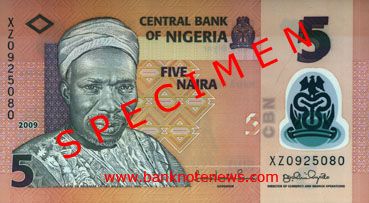
5 naira (US$0.05), 2009. This denomination has now been confirmed dated 2009 with two different GOVERNOR signatures (Chukwuma “Charles” Soludo and Lamido Aminu Sanusi), both paired with Benjamin C. Onyido as DIRECTOR OF CURRENCY AND BRANCH OPERATIONS.
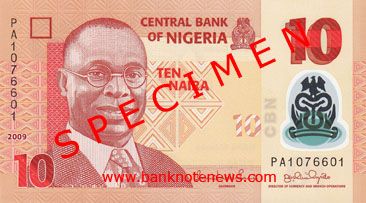
10 naira (US$0.05), 2009. This denomination has now been confirmed dated 2009 with two different GOVERNOR signatures (Chukwuma “Charles” Soludo and Lamido Aminu Sanusi), both paired with Benjamin C. Onyido as DIRECTOR OF CURRENCY AND BRANCH OPERATIONS.
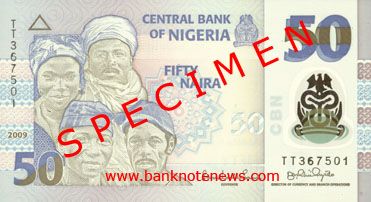

50 naira (US$0.35), 2009. This is the second note of this denomination dated 2009 with the signature combination of Lamido Aminu Sanusi and Benjamin C. Onyido. There appear to be varieties with six-digit serial numbers (as shown above) as well as seven-digit serial numbers, perhaps from different printers.
Courtesy of Arigo Avbovbo, Thomas Krause, and Andrew Roberts.
